Aviation in Early Los Angeles
| Historical Photos of Aviation in L.A |
United Airport to Hollywood Burbank Airport
The Hollywood Burbank Airport has undergone several name changes throughout its history, reflecting its evolving ownership and identity. Here's a chronological overview of the airport's names:
United Airport (1930-1934)
The airport was initially opened as United Airport on Memorial Day weekend in 1930. It was constructed by United Aircraft and Transport Corporation, a partnership between Boeing and United Airlines.
Union Air Terminal (1934-1940)
In 1934, the airport was renamed Union Air Terminal. This change occurred when the United Aircraft and Transport holding company dissolved due to federal antitrust actions.
Lockheed Air Terminal (1940-1967)
Lockheed purchased the airport in 1940 and renamed it Lockheed Air Terminal.
Hollywood-Burbank Airport (1967-1978)
In 1967, the airport underwent another name change to Hollywood-Burbank Airport.
Burbank-Glendale-Pasadena Airport (1978-2003)
When Lockheed sold the airport to the Burbank-Glendale-Pasadena Airport Authority in 1978, it was renamed Burbank-Glendale-Pasadena Airport to reflect the surrounding cities.
Bob Hope Airport (2003-2017)
In 2003, the airport was officially renamed Bob Hope Airport.
Hollywood Burbank Airport (2017-present)
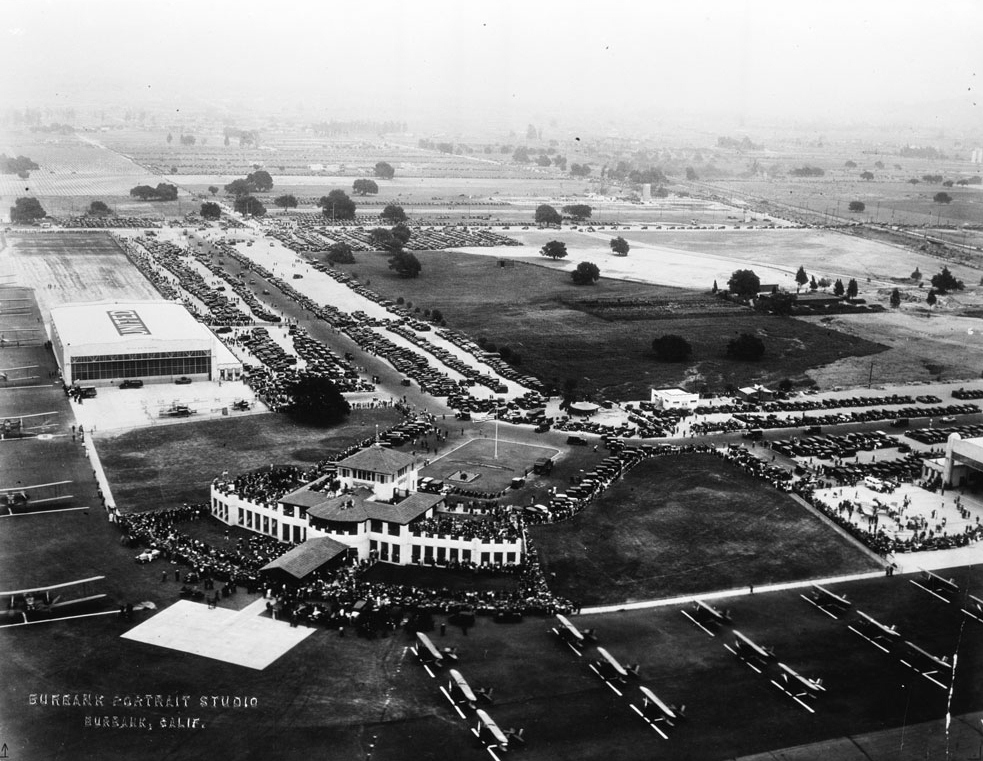 |
|
| (1930)^* - Birds eye view of the United Airport in Burbank at the Terminal's dedication. At center, a crowd of people has gathered around the main terminal bulding. Converting just before it, two lanes of airplanes can be seen in the foreground. To the left, a sign on a long, one-story building reads "United", while automobiles can be seen parked all around. |
Historical Notes United Airport was dedicated amid much festivity (including an air show) on Memorial Day Weekend (May 30 – June 1, 1930). The airport and its handsome Spanish revival terminal was a showy new competitor to the nearby Grand Central Airport in neighboring Glendale, which was then Los Angeles' main airline terminal. |
 |
|
| (1930)#* - Panoramic photo taken during the dedication and grand opening of the Burbank airport on May 30, 1930, back when it was called “United Airport.” |
 |
|
| (1930)#* - A slightly elevated panoramic view of a runway full of airplanes at United Airport in Burbank. There are at least eight rows of three airplanes parked on the runway in the foreground. These are US Army Bomber aircraft, including the Curtiss B-2 and the Keystone LB-6. Beyond these there are dozens more smaller planes, closely parked in rows of six to ten. |
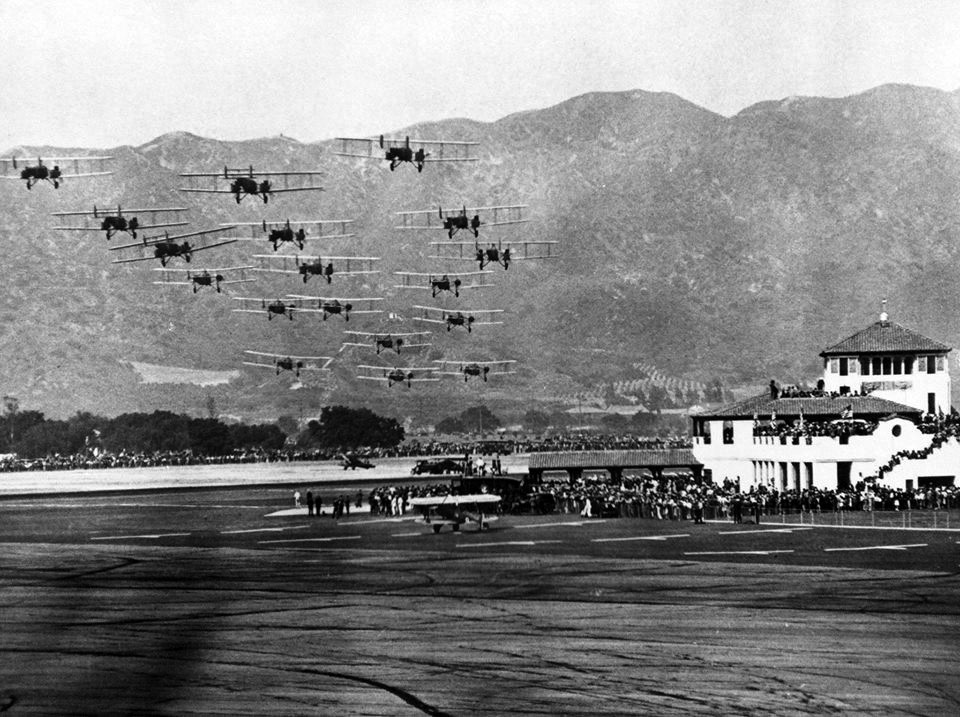 |
|
| (1930)^*^* - A squadron of planes takes-off and flys over the new Terminal building as spectators watch. |
Historical Notes The new Burbank facility became the largest commercial airport in the Los Angeles area until it was eclipsed in 1946 by the Los Angeles Airport in Westchester when that facility (formerly Mines Field, then Los Angeles Municipal Airport) commenced scheduled airline operations |
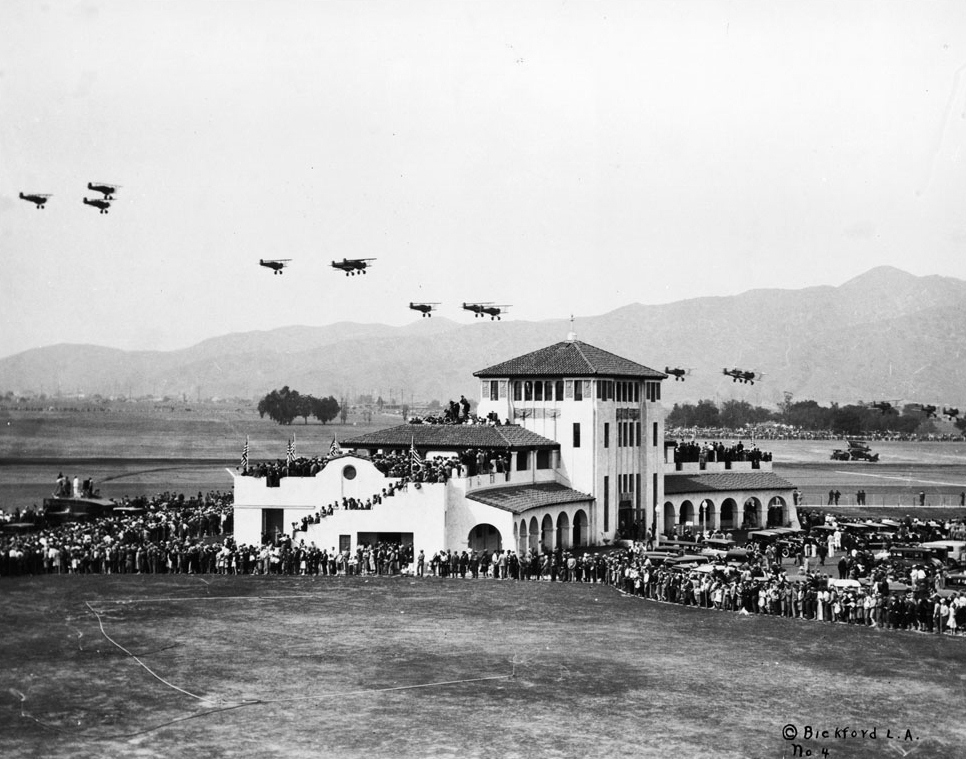 |
|
| (1930)^* - A fly-over of the United Air Terminal in Burbank at the terminal's dedication, May 30, 1930. The terminal is at center and is a light-colored structure with a tall rectangular tower at center that is flanked by two lower sections. The front of the building is marked by a series of archways, and the tops of the two lower wings are uncovered and crowded with people. There are also hundreds of people on the ground, and a parking lot is at right. Twelve biplanes are flying in formation over the terminal, and more planes are visible on the ground at right. A tall mountain range is visible in the distance. |
Historical Notes Over the years, the airport has been known as Angeles Mesa Drive Airport (1928–1930), United Airport (1930–1934), Union Air Terminal (1934–1940), Lockheed Air Terminal (1940–1967), Hollywood-Burbank Airport (1967–1978), Burbank-Glendale-Pasadena Airport (1978–2003) and most recently Bob Hope Airport (2003–present). |
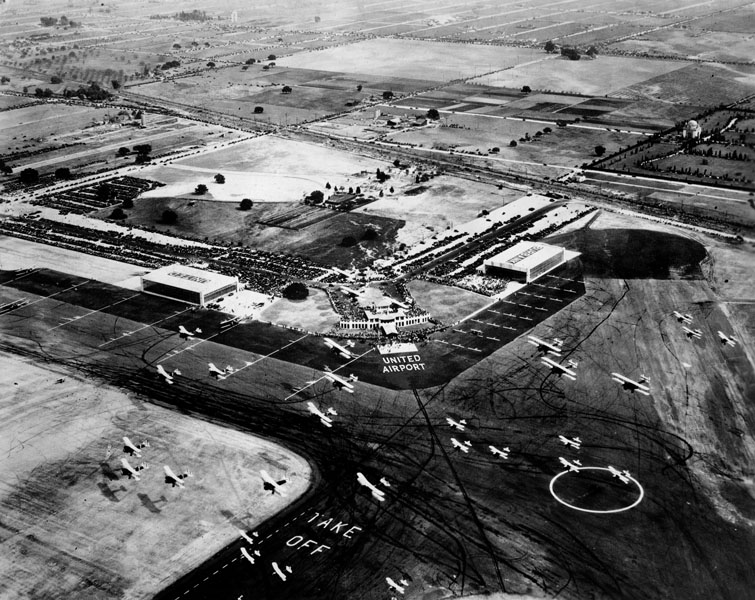 |
|
| (1930)* - Aerial view of United Airport in Burbank. Crowds of people can be seen on the ground, watching the air show taking place over the airport. |
Historical Notes Boeing Aircraft and Transport (BA&T) was a holding company created in 1928 that included Boeing Aircraft and United Air Lines, itself a holding company for a collection of small airlines that continued to operate under their own names. One of these airlines was Pacific Air Transport (PAT), which Boeing had acquired because of PAT's west coast mail contract in January 1928. BA&T then sought a suitable site for a new airport for PAT, and found one in Burbank. BA&T had the benefit of surveys that the Aeronautics Department of the Los Angeles Chamber of Commerce had conducted starting in 1926 to identify potential airport sites. |
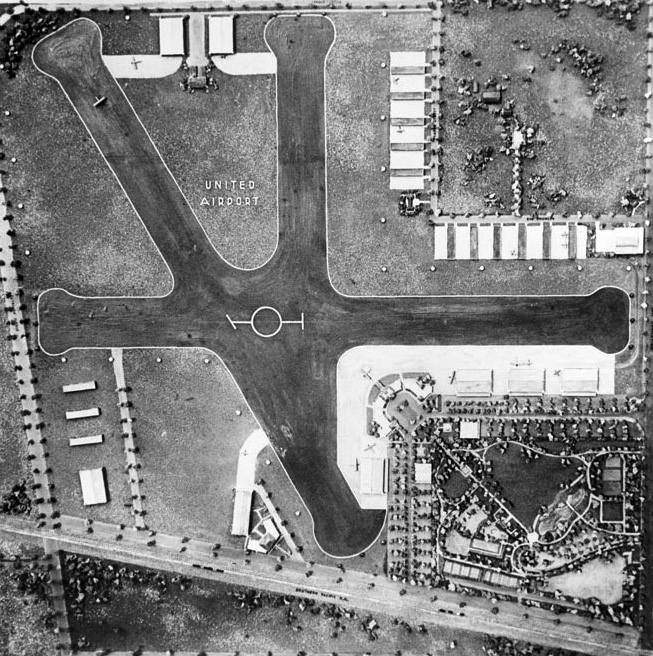 |
|
| (ca. 1930)^* - Aerial view of United Airport. The runway extends in four directions, toward the north, north-west, to the west and the east. Below the eastern part of the runway, the pavement connects to what appears to be a terminal at the airport proper. The roofs of three large structures can be seen, sandwiching a semicircular area that appears to be the airport. To the bottom right is an area lined with trees, houses, and perhaps a golf course. Below the airport runs the Southern Pacific Railroad, and to the right runs Hollywood Way. In the upper right corner lie several roofed structures that form an "L" shape around an arborous area. At the back to the left are two roofed structures with roads that connect to the runway, presumably hangars. |
Historical Notes It took Boeing Aircraft and Transport a year and the cooperation of the city to assemble the site. The 234-acre site was rife with vines and trees and the ground had to be filled and leveled, but it had good drainage, a firm landing surface, steady winds, and good access to ground transport. Construction was completed in just seven months. In an age when few aircraft had brakes and many had a tail skid instead of a wheel, runways were not usually paved; those at Burbank had a 5-inch-thick mixture of oil and sand. |
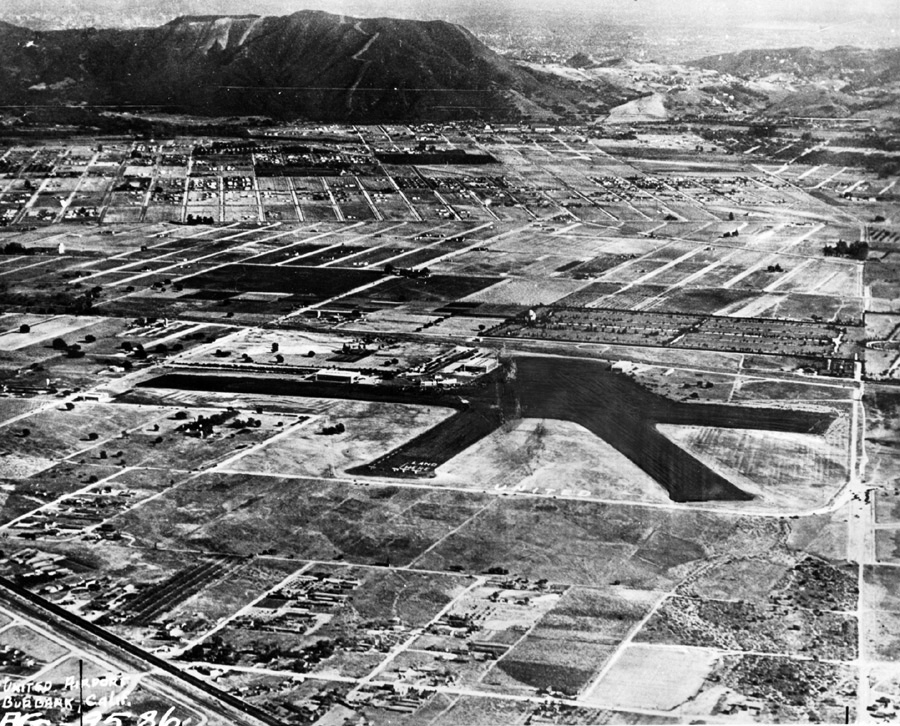 |
|
| (mid-1930s)#^*^ - Aerial panoramic showing United Airport, Burbank, and the Verdugo Hills in the background. |
Historical Notes United Airport had no taxi strips, but the designers left room for them. Two of the runways were over 3,600 feet long; a third was 2,900 feet; all were 300 feet wide. These were generous dimensions, and the site had room for expansion. |
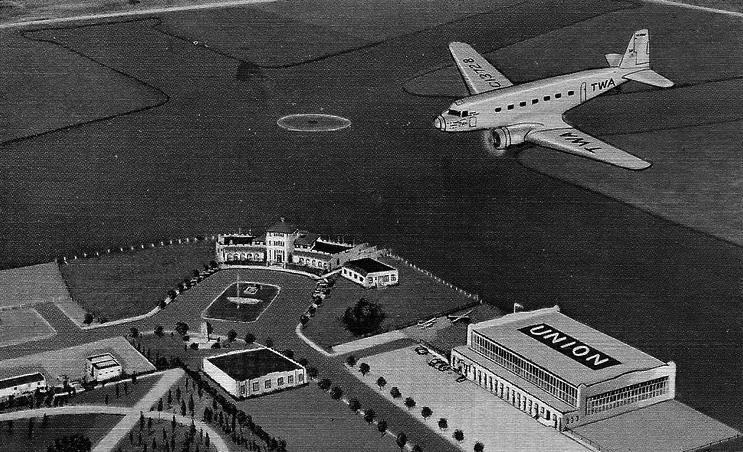 |
|
| (ca. 1934)#^*^ - Postcard showing a plane flying over the Union Air Terminal Building. |
Historical Notes The Burbank facility remained United Airport until 1934 when it was renamed Union Air Terminal. The name change came the same year that Federal anti-trust actions caused United Aircraft And Transport Corp. to dissolve, which took effect September 26, 1934. |
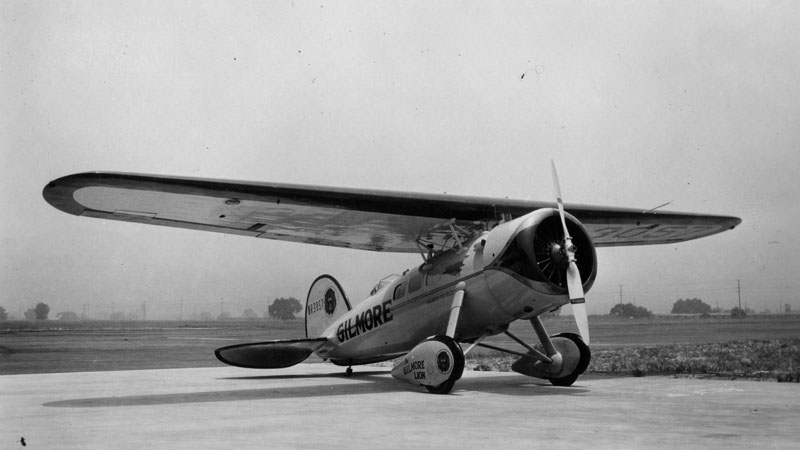 |
|
| (1930)* - A Lockheed Air Express at United Airport (Bob Hope Airport), owned by famous pilot Colonel Roscoe Turner. |
Historical Notes Roscoe Turner was known as a serious racing pilot, a Hollywood stunt pilot and showman. In 1930 he took on a new and unexpected flight partner--a lion. A year before, Turner had secured sponsorship by the Gilmore Oil Company, who had a lion as a corporate logo (see rear of plane), and realizing the potential publicity for both him and his sponsor, Turner acquired a lion cub and began flying with him. "Gilmore," the lion became a well-known national figure and, like Turner's uniform, one of the aviator's trademarks. Gilmore was on aboard when Turner set two transcontinental speed records in May 1930, one traveling eastward and the other westward. Turner flew from Los Angeles to New York in 15 hours, 37 minutes. The journey back to California took 18 hours, 42 minutes. To celebrate his achievements, Turner decided to set yet another record, this time across three countries. |
| (1932)^*# - Photograph showing Amelia Earhart standing between two men in front of single-prop plane. In the background is the Pacific Airmotive Corp. hangar in Burbank. |
Historical Notes Amelia Mary Earhart; July 24, 1897 – disappeared July 2, 1937) was an American aviation pioneer and author. Earhart was the first female pilot to fly solo across the Atlantic Ocean. She received the U.S. Distinguished Flying Cross for this record. She set many other records, wrote best-selling books about her flying experiences and was instrumental in the formation of The Ninety-Nines, an organization for female pilots. Earhart joined the faculty of the Purdue University aviation department in 1935 as a visiting faculty member to counsel women on careers and help inspire others with her love for aviation. She was also a member of the National Woman's Party, and an early supporter of the Equal Rights Amendment. |
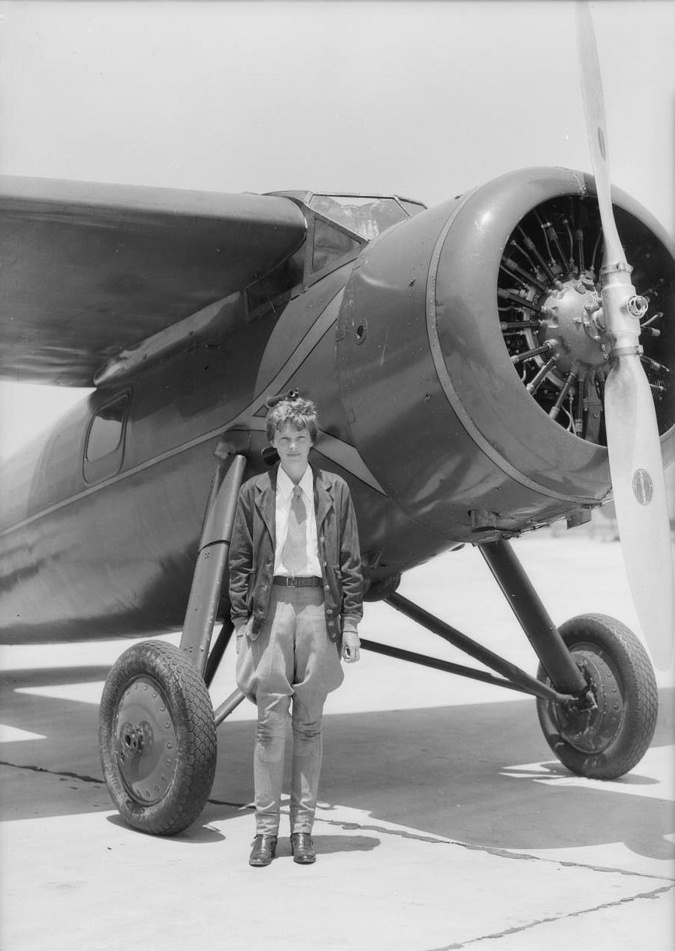 |
|
| (1932)^*# - Amelia Earhart standing in front of her single-prop plane in Burbank. |
Historical Notes During an attempt to make a circumnavigational flight of the globe in 1937 in a Purdue-funded Lockheed Model 10 Electra, Earhart disappeared over the central Pacific Ocean near Howland Island. Fascination with her life, career and disappearance continues to this day. |
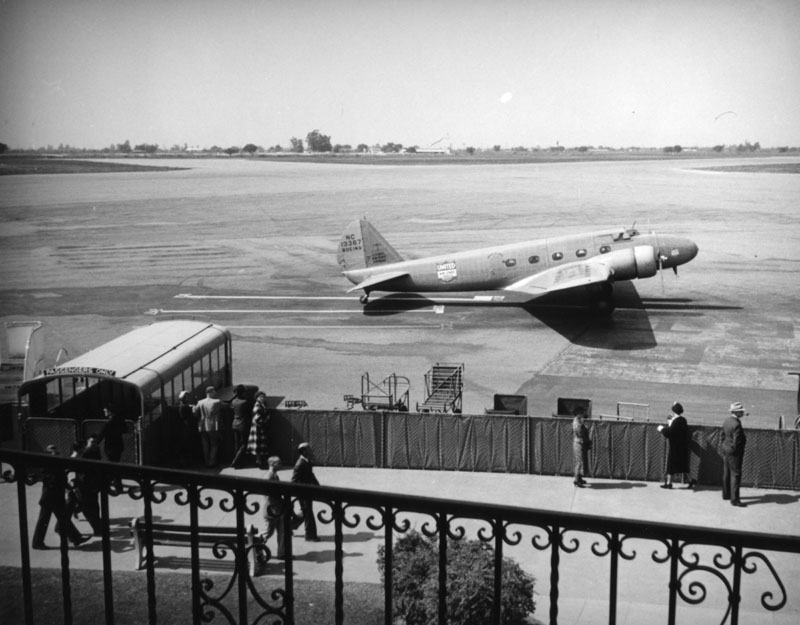 |
|
| (1930s)^*# - A Boeing Model 247 as it taxis off toward the runway at Union Air Terminal. The 247 was the first commercial plane capable of flying non-stop coast to coast. |
Historical Notes The Boeing Model 247 was considered the first aircraft to fully incorporate advances such as all-metal (anodized aluminum) semi-monocoque construction, a fully cantilevered wing and retractable landing gear. Other advanced features included control surface trim tabs, an autopilot and deicing boots for the wings and tailplane. The 247 was capable of crossing the United States from east to west eight hours faster than its predecessors, such as the Ford Trimotor and Curtiss Condor. Entering service on May 22, 1933, a Boeing Air Transport 247 set a cross-country record pace of 19½ hours on its San Francisco to New York inaugural flight. For the first time airline passengers could fly across the country without changing planes or stopping overnight. The 247 remained in airline service until World War II, when several were converted into C-73 transports and trainers. No. 121 Squadron, Royal Canadian Air Force (RCAF) operated seven Model 247Ds as medium transports during the early part of the war. Some 247s were still flying in the late 1960s, converted either into cargo transports or personal business aircraft. |
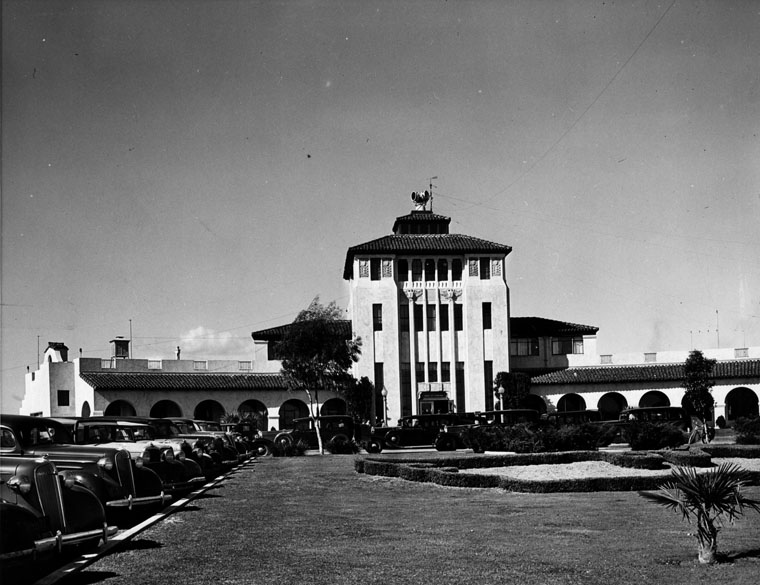 |
|
| (1930s)* - Exterior view of the Administration building of Union Air Terminal (later Bob Hope Airport) in Burbank. |
Historical Notes The Union Air Terminal moniker stuck until Lockheed bought the airport in 1940 and renamed it Lockheed Air Terminal. |
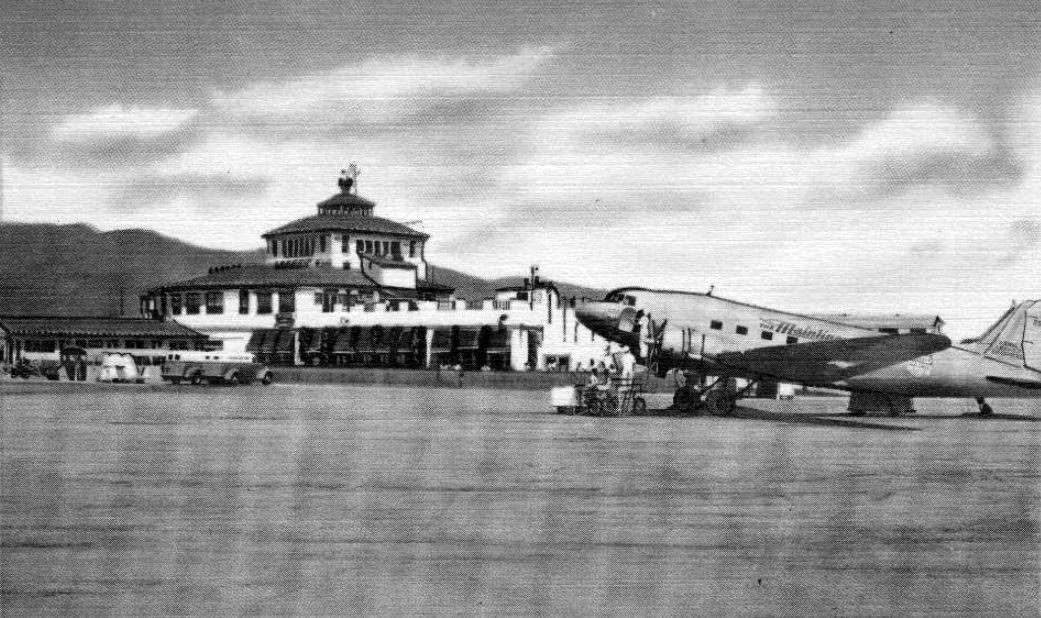 |
|
| (ca. 1939)#^^^ – Postcard view showing a plane, Douglas DC-3, being serviced at Union Air Terminal, Burbank. |
Historical Notes The Douglas DC-3’s speed and range revolutionized air transport in the 1930s and 1940s. Its lasting impact on the airline industry and World War II makes it one of the most significant transport aircraft ever made. The major military version was designated the C-47 Skytrain, of which more than 10,000 were produced. Many DC-3s and converted C-47s are still used in all parts of the world. |
 |
|
| (ca. 1939)* - View is looking south over the Burbank Airport showing a TWA airliner, Douglas DC-3, coming in for a landing. |
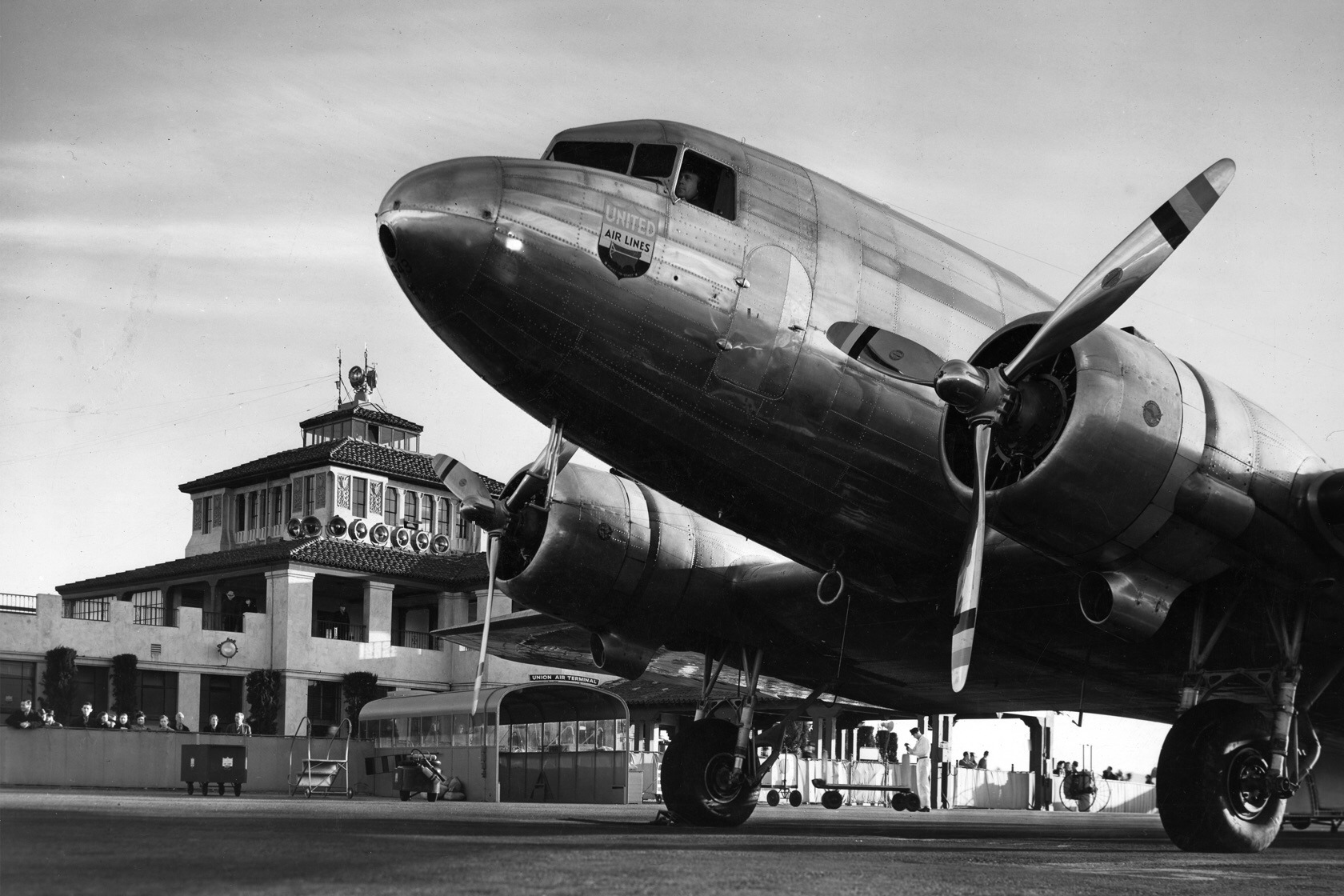 |
|
| (1940s)* – Close-up view of a Douglas DC-3 sitting in front of Lockheed Air Terminal (changed names in 1940). Photo courtesy of the Museum of Flight |
Historical Notes What was to become perhaps the most important airliner in history, quickly established its reputation with this and other operators, including the military. During World War II, the DC-3 (named Dakota by Britain) was mass produced as a utility transport in C-47, C-53, and other versions, known also as Skytrains and Skytroopers, and was license-built in large numbers in Russia as the Lisunou Li-2. Used in all imaginable roles, from freight and personnel transport to glider tug and ambulance, the type was active in all theaters of war, notably during the D-Day landings in Normandy, and subsequent assaults by Allied airborne forces. After the war, military flying continued and production of the civil version was restarted. DC-3s became the mainstay of worldwide passenger and freight services for many years. As larger capacity piston and jet airliners became available, DC-3s were gradually turned over to smaller operators.^ |
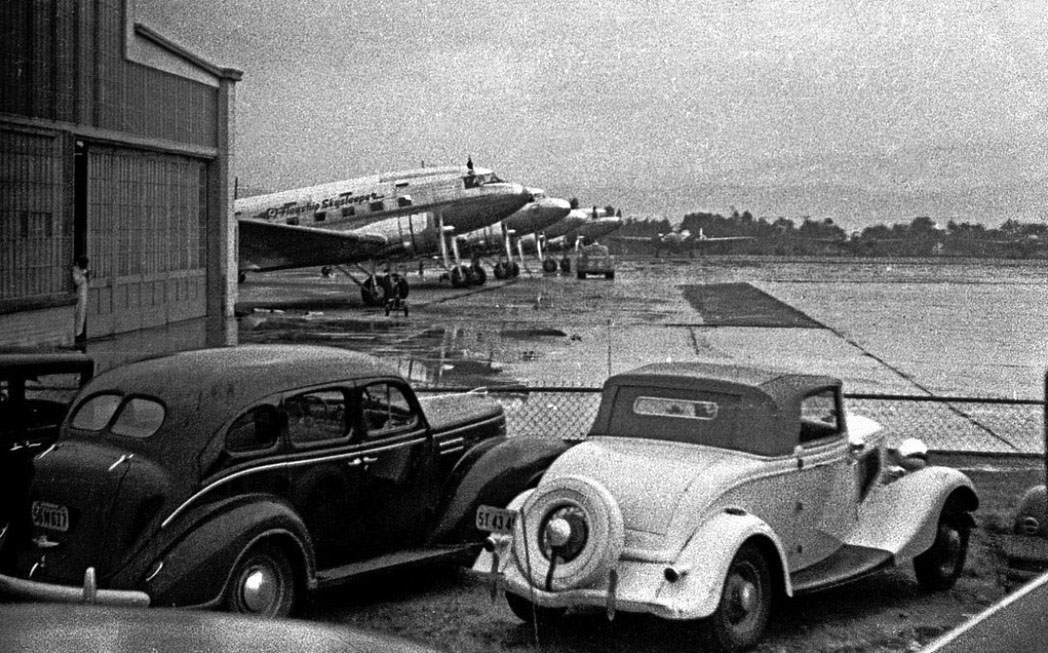 |
|
| (ca. 1939)#^ – View of Union Air Terminal on a rainy day with four DC3’s lined up near the terminal. Two cars are seen parked in the foreground. |
Historical Notes By 1934 the airport had become Los Angeles' primary airport known as Union Air Terminal. The DC-3 first in the line is an American Airlines Flagship Skysleeper which was equipped with individual berths. These aircraft would fly coast to coast in approximately 17 hours. |
 |
|
| (ca. 1939)#^*^ - Panoramic view showing the Union Air Terminal shortly before the name was changed to Lockheed Air Terminal. |
Historical Notes During the 1930's Lockheed Aircraft Company, adjacent to the field, evolved into one the nation's largest aircraft manufacturers, and in 1940 Lockheed purchased the airport. It was then renamed Lockheed Air Terminal and used to test and deliver Lockheed aircraft. It also remained Los Angeles' primary civil airport and remained the area's only civil airport throughout the war. |
.jpg) |
|
| (1940s)*^^ - View showing the Lockheed Air Terminal camouflaged and covered with tree-like netting during World War II. |
Historical Notes During the war Lockheed built P-38 fighters, Hudson and B-17 bombers. The Royal Air Force's Air Technical Services Command and US Army Air Forces Western Technical Training Command had operations at the field. The airport and the Lockheed plant were extensively camouflaged during the war. |
Before and After
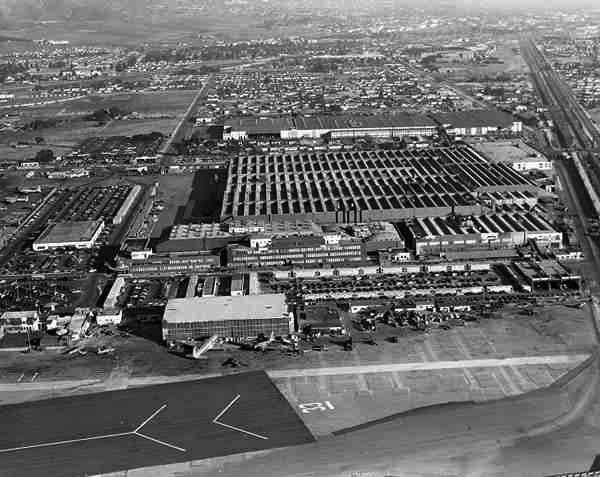 |
|
.jpg) |
|
| (1940s)*^^ - View showing the Lockheed plant before and after it was camouflaged. |
Historical Notes The main Lockheed plant and runways were made to appear as grain fields and houses, and the parking lot was covered over with netting to appear as alfalfa fields. In addition, an extensive smoke screen system was installed to hide the plant under smoke. |
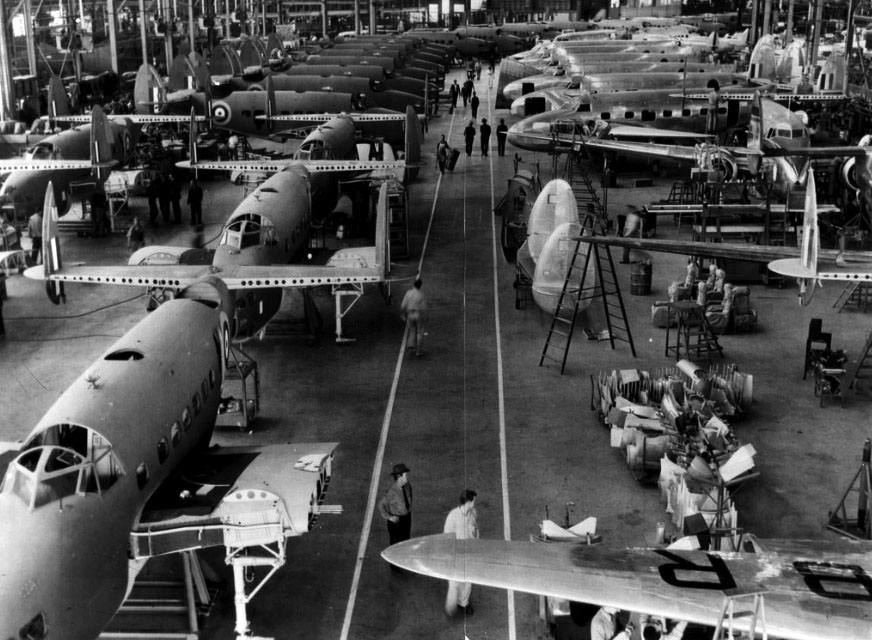 |
|
| (1941)#^ – Interior view of the sprawling Lockheed aircraft factory in Burbank showing one section of the assembly plant where a large order of Lockheed Hudson bombers for Britain is nearing completion. |
Historical Notes The Lockheed Hudson was a light bomber and coastal reconnaissance aircraft built initially for the Royal Air Force shortly before the outbreak of the Second World War and primarily operated by the RAF thereafter. The Hudson was a military conversion of the Lockheed Model 14 Super Electra airliner, and was the first significant aircraft construction contract for the Lockheed Aircraft Corporation—the initial RAF order for 200 Hudsons far surpassed any previous order the company had received. The Hudson served throughout the war, mainly with Coastal Command but also in transport and training roles as well as delivering agents into occupied France. They were also used extensively with the Royal Canadian Air Force's anti-submarine squadrons and by the Royal Australian Air Force.^ |
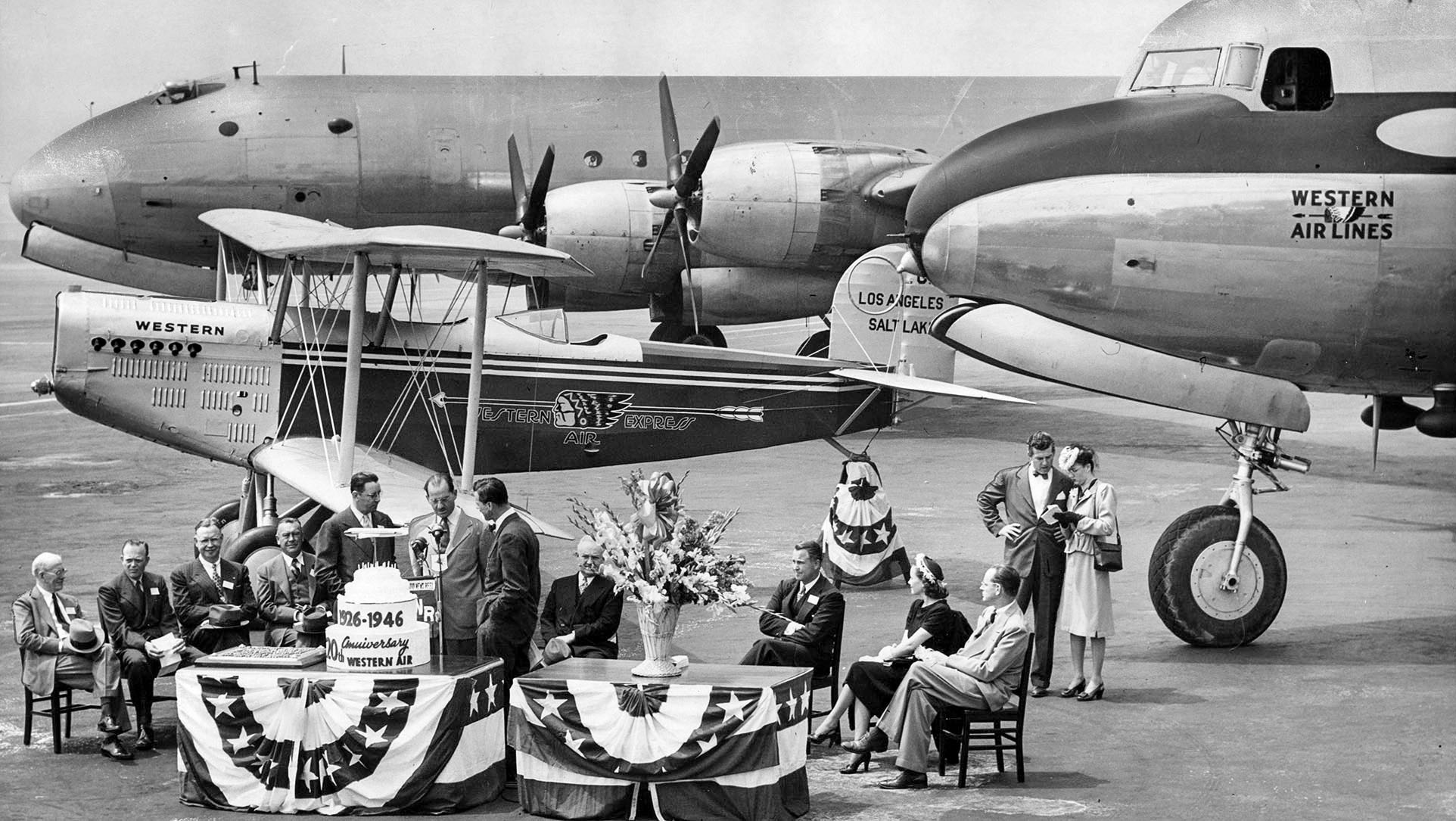 |
|
| (1946)** – View showing ceremonies celebrating Western Air Lines 20th anniversary at Lockheed Air Terminal. In back of cake-cutting is a Douglas M-2 biplane. On right is the front portion of a Douglas C-54 Skymaster. In background is Douglas C-74. L.A. Times Framework |
Historical Notes A story in the April 18, 1946, Los Angeles Times reported: Three planes told the story of transport aviation yesterday at Lockheed Air Terminal where Western Air Lines celebrated its 20th birthday — the beginning of its third decade — as the oldest air carrier in the nation. Representing the past was Western’s historic M-2 biplane, with criss-crossed wires, fabric fuselage and external control cables, a 100-m.p.h. two-place “speedster” that in 1926 inaugurated W.A.L.’s original mail service from Los Angeles to Salt Lake City. For the present was the airline’s 54-passenger Spymaster, a sleek, 36-ton luxury liner recently placed in operation on Western’s newest route linking Los Angeles and Denver. And in the future was the giant Douglas C-74, a bug-eyed monster weighing some 80 tons and destined to carry nearly 100 passengers nonstop over transcontinental ranges. In 1941, Western Air Express changed its name to Western Air Lines. Later the name was shortened to Western Airlines. In 1987, Western Airlines merged with Delta Air Lines. |
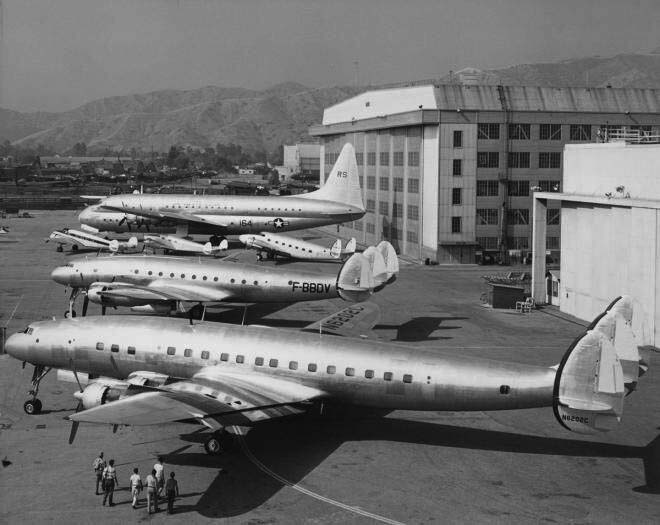 |
|
| (ca. 1948)* - View showing the Lockheed post-war production planes in front of their main plant. |
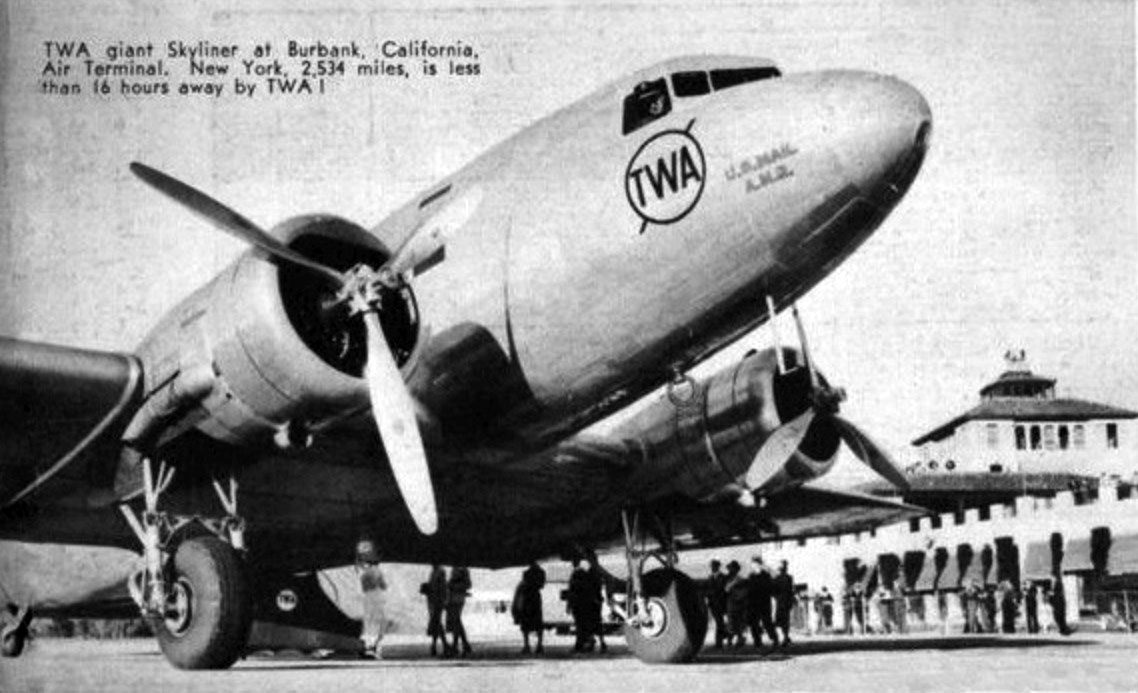 |
|
| (ca. 1940s)#^*^ – Postcard view showing the TWA Skyliner which operated day and night on a regular schedule between New York and California over the Lindbergh Line. The card reads: “TWA giant Skyliner at Burbank, California, Air Terminal. New York, 2,534 miles, is less than 16 hours by TWA!” |
Historical Notes The DC-3 and DST popularized air travel in the United States. Eastbound transcontinental flights could cross the U.S. in about 15 hours with three refueling stops; westbound trips against the wind took 171⁄2 hours. A few years earlier such a trip entailed short hops in slower and shorter-range aircraft during the day, coupled with train travel overnight. “DC” stands for Douglas Commercial and “DST” for Douglas Sleeper Transport. |
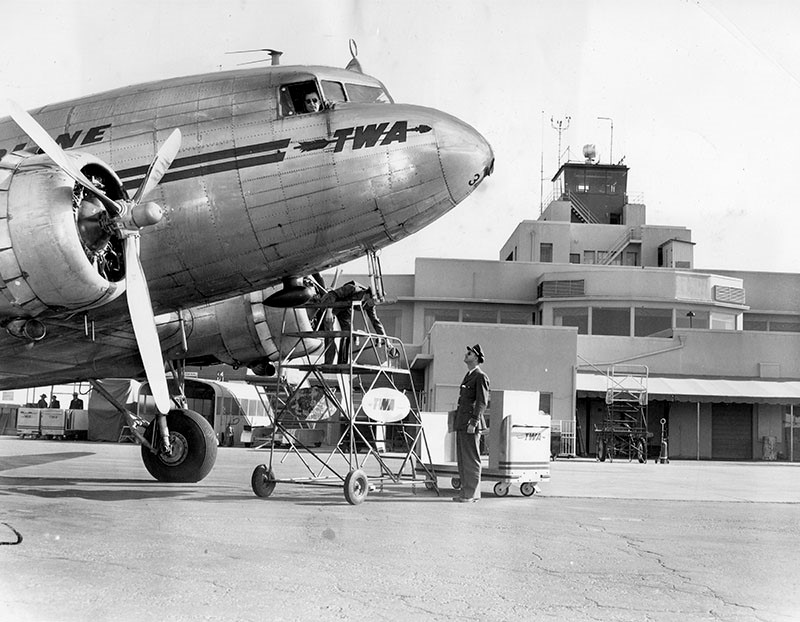 |
|
| (1948)* - Photograph caption dated March 4, 1948 reads, "Air transports of the TWA line pay frequent calls to the Lockheed Air Terminal located in the Valley at Burbank, the aerial city of California." |
Historical Notes In 1947, when Mines Field was expanded to become Los Angeles' primary airport, this facility became a secondary airport. In 1978 the cities of Burbank, Glendale and Pasadena bought the airport and renamed it Burbank Glendale-Pasadena Airport. Lockheed continued in operation at the field for many years. |
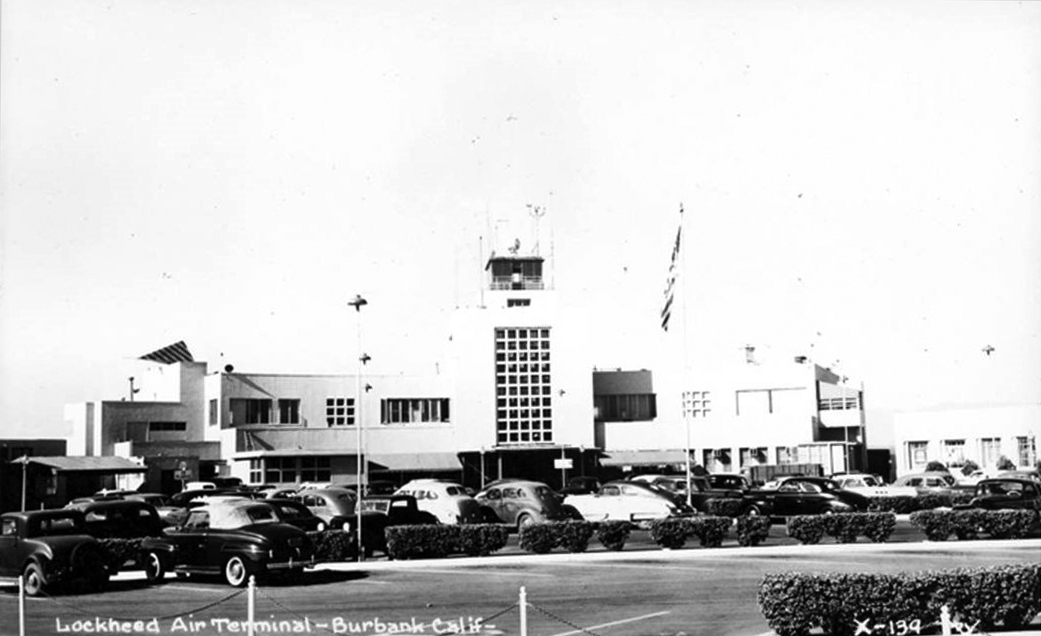 |
|
| (ca. 1940s)^ – Postcard view of the Lockheed Air Terminal in Burbank. |
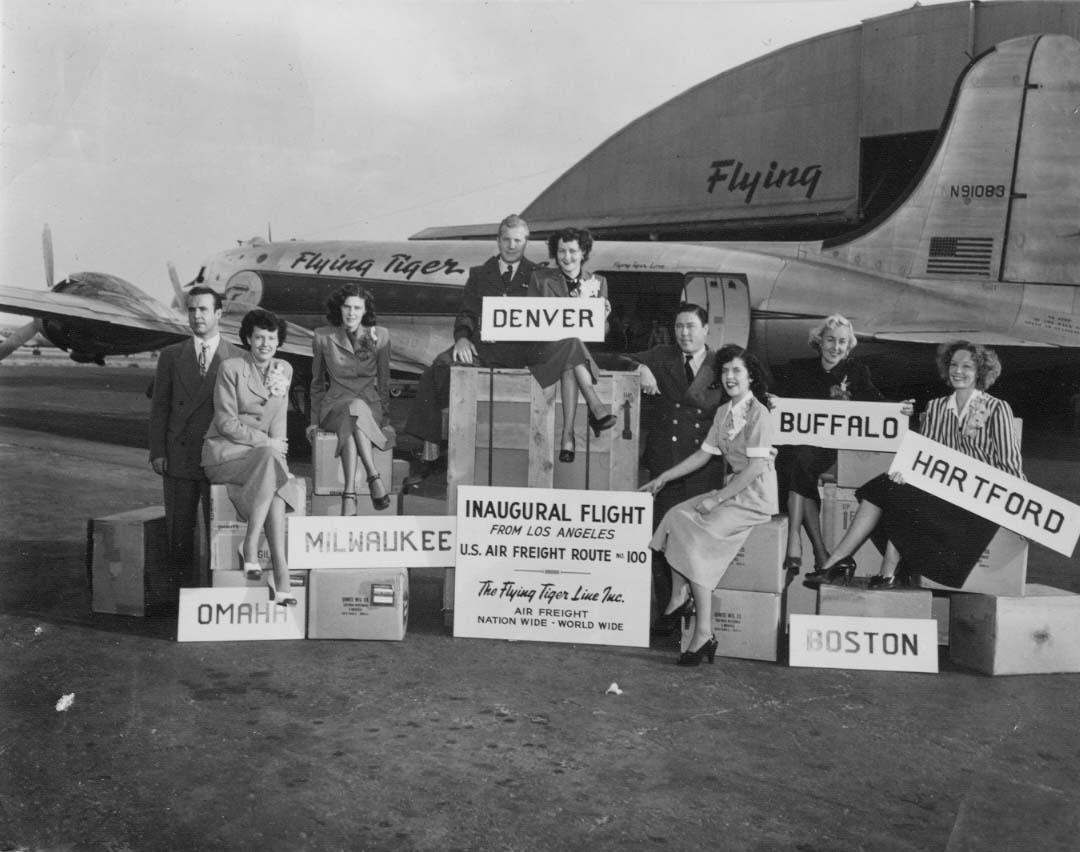 |
|
| (1949)^*^ - A publicity photo commemorating the Flying Tiger Line’s 1949 inaugural cargo flight out of Burbank. |
Historical Notes The Flying Tiger was an L.A. based company that ferried cargo by air from 1945 until 1989. FedEx purchased the operation in 1989. |
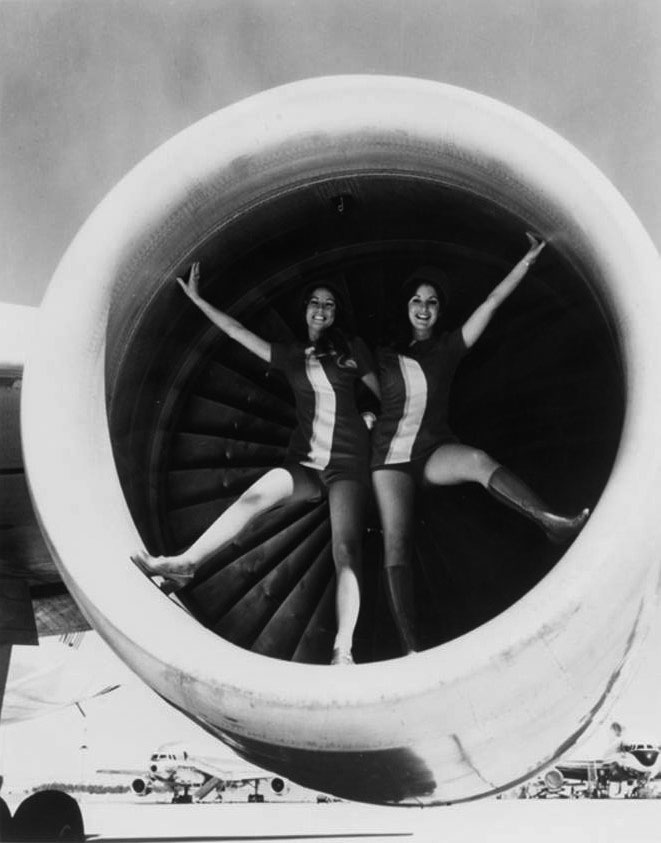 |
|
| (ca. 1960s)^ - Stewardesses from Pacific Southwest Airlines pose in front of an L-1011 TriStar engine to promote their new uniforms of cotton-candy pink, tangelo red, and pumpkin orange; designed to match the colored stripes of PSA's "Smiling Aircrafts". Taken at Hollywood-Burbank Airport. |
Historical Notes The first stewardesses were actually nurses hired to make passengers feel safer. Women who wanted to be “sky girls” had to meet strict requirements. In addition to being single, they had to be under 25 years of age, under 5-feet-5 and under 116 pounds. Not only did they tend to passengers, they were also expected to haul luggage, fuel the plane and help pilots push the plane into the hanger after flights. "Stewardess" was replaced with the term: "flight attendant" in the 70s. Between 1968 and 1984, Lockheed manufactured a total of 250 TriStars. The aircraft's sales were hampered by two years of delays due to developmental and financial problems at Rolls-Royce, the sole manufacturer of the TriStar's engines. After production ended, Lockheed withdrew from the commercial aircraft business due to its below-target sales. |
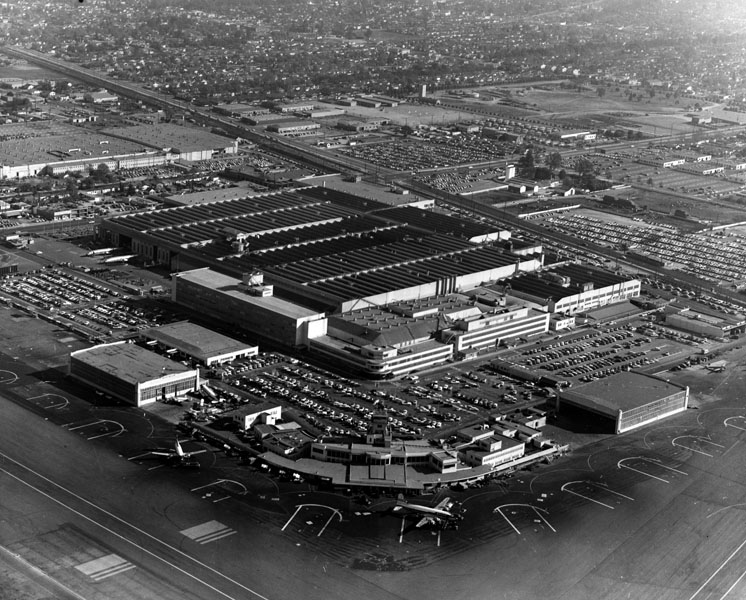 |
|
| (ca. 1960s)* - Aerial view of Lockheed Air Terminal in Burbank, Calif; Lockheed Air Terminal (1940-1967); Hollywood-Burbank Airport (1967-1978). |
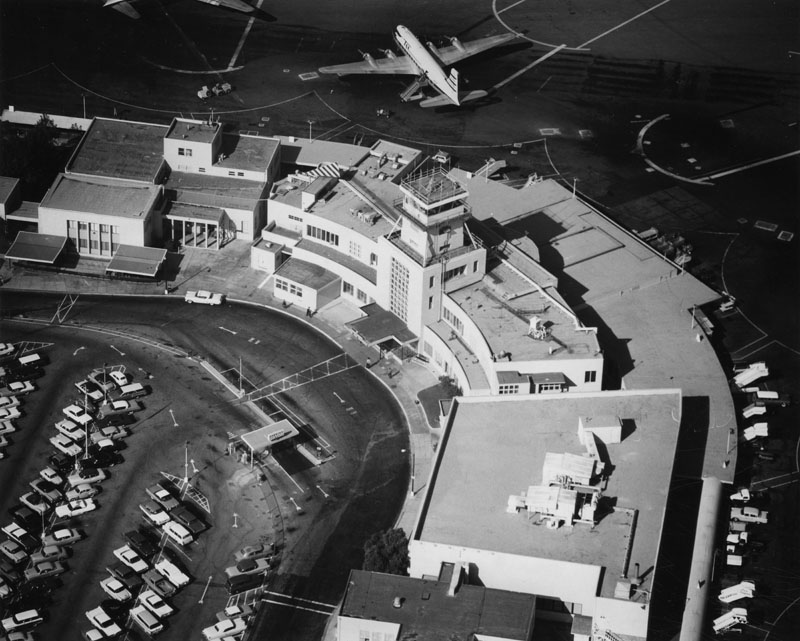 |
|
| (1961)* - Lockheed Air Terminal has had many names: United Airport (1930-1934); Union Air Terminal (1934-1940); Lockheed Air Terminal (1940-1967); Hollywood-Burbank Airport (1967-1978); Burbank-Glendale-Pasadena Airport (1978-2003) and Bob Hope Airport (2003-Present). |
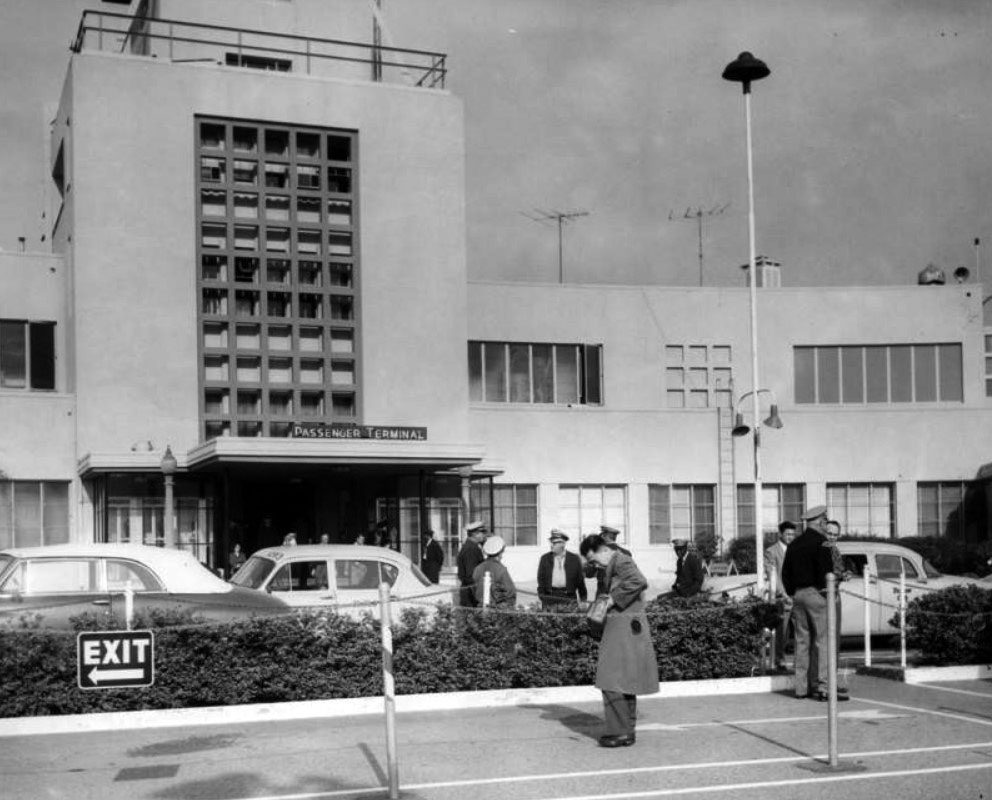 |
|
| (1958)* - Photograph caption reads, "Hub of Burbank Terminal. Largest of Valley's network of airports, Lockheed Air Terminal handles 1,000,000 passengers annually. Of those, 45,000 are military personnel. In addition, 22,500 tons of freight move through Lockheed every year. Standing behind operation is force of security police who enforce terminal rules." Valley Times Photo |
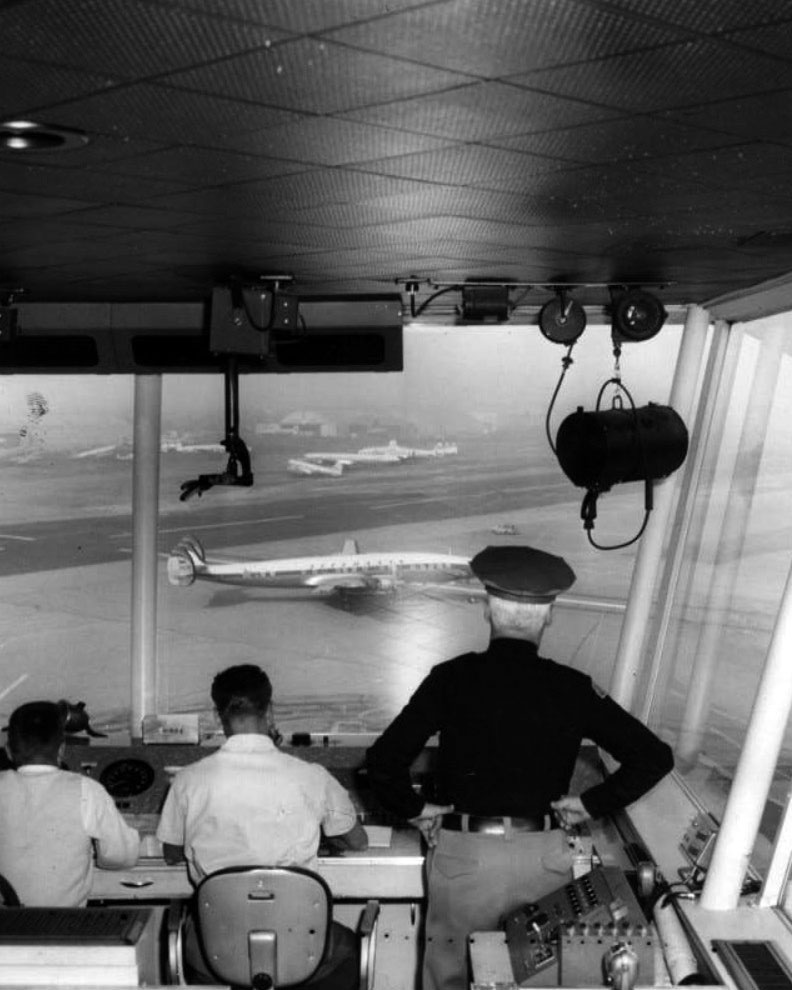 |
|
| (1958)* - Photograph caption reads, "Watch Airplane Operations. Security officer checks air liner from terminal control tower. Security force is in charge of field operations at Lockheed. It collects landing and departure fees from planes, directs airplane and automotive parking and guards airfield." Valley Times Photo |
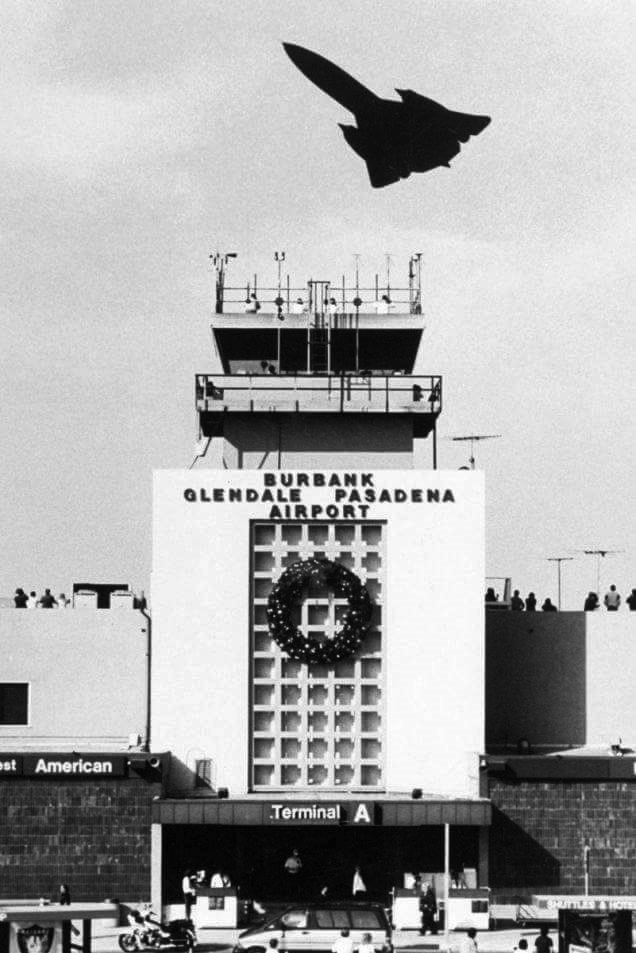 |
|
| (ca. 1990s)* – View showing a Lockheed SR-71 "Blackbird" flying over the Burbank – Glendale – Pasadena Airport as spectators watch from the roof. |
Historical Notes The SR-71 was designed for flight at over Mach 3 with a flight crew of two in tandem cockpits, with the pilot in the forward cockpit and the Reconnaissance Systems Officer (RSO) operating the surveillance systems and equipment from the rear cockpit, and directing navigation on the mission flight path. The SR-71 was designed to minimize its radar cross-section, an early attempt at stealth design. Finished aircraft were painted a dark blue, almost black, to increase the emission of internal heat and to act as camouflage against the night sky. The dark color led to the aircraft's nickname "Blackbird". On March 6, 1990; the SR-71 flew from Los Angeles to Washington D.C. in 1hour, 4 minutes, 20 seconds at average speed of 3,418kph (2,124 mph) setting a new record. The plane was handed over to the Smithsonian and is now on display. |
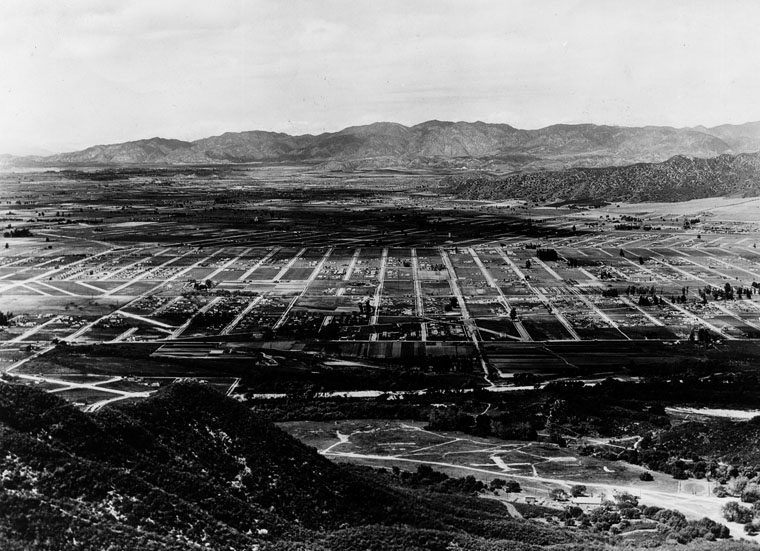 |
|
| (ca. 1967)* - View of the San Fernando Valley, overlooking Burbank from Griffith Park. The Hollywood-Burbank Airport can be seen at lower-center. |
Historical Notes In 1967 Lockheed rechristened the facility with the more glamorous-sounding name of Hollywood-Burbank Airport. The facility remained Hollywood-Burbank Airport for over a decade until 1978 when Lockheed sold the airport to the Burbank-Glendale-Pasadena Airport Authority. At that time the airport acquired its fifth name: Burbank-Glendale-Pasadena Airport (1978–2003). |
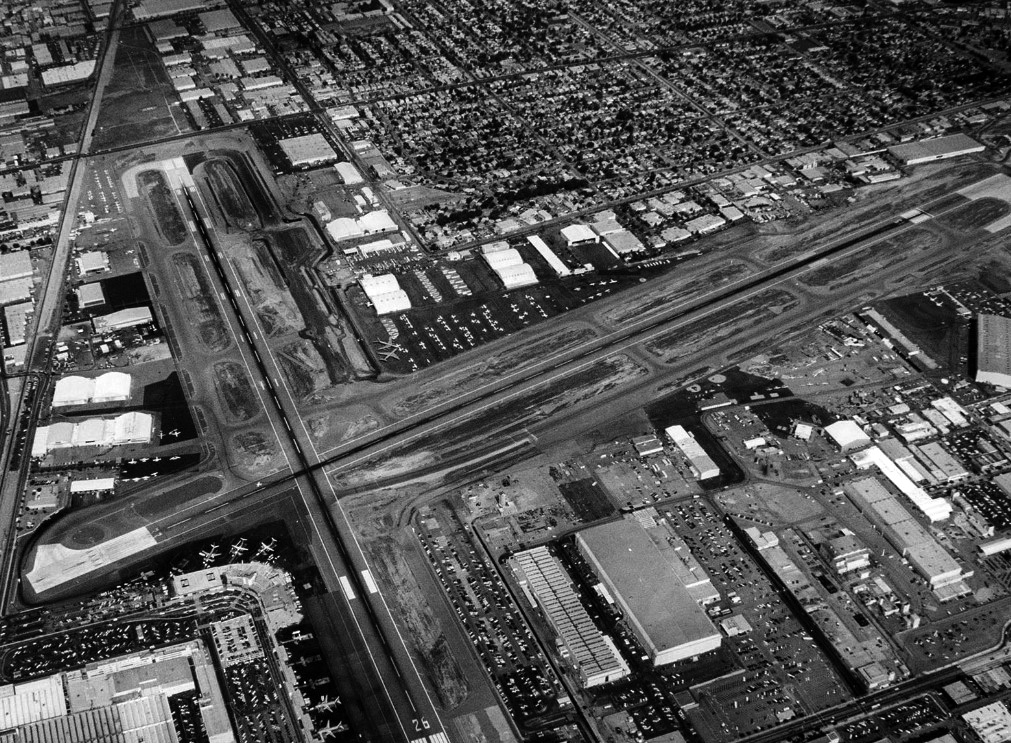 |
|
| (1990)** – Aerial view of the Burbank-Glendale-Pasadena Airport, it’s fifth name. The airport's name would change again in 2003. |
Historical Notes On November 11, 2003 the airport authority voted to change the airport's name to Bob Hope Airport in honor of comedian Bob Hope, a longtime resident of nearby Toluca Lake, who had died earlier in the year and who had kept his personal airplane at the airfield. The new name was unveiled on December 17, 2003, on the 100th anniversary of the Wright brothers' first flight in 1903, the year that Bob Hope was born. |
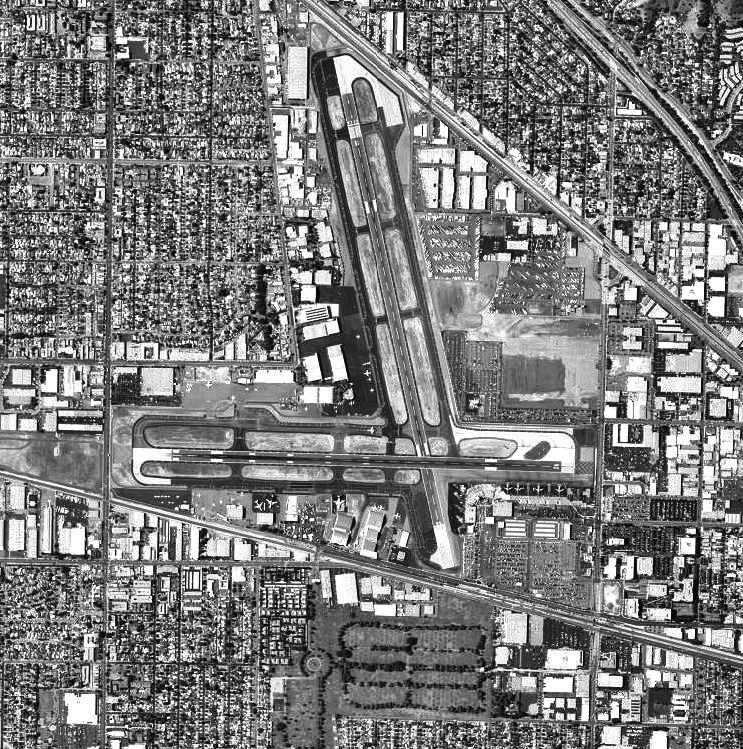 |
|
| (2006)*^ - Aerial view of Bob Hope Airport as it appeared in 2006. |
Historical Notes In 2005 the airport celebrated its 75th anniversary; in 2006 it served 5,689,291 travelers on seven major carriers, with more than 70 flights daily. |
Mines Field to LAX
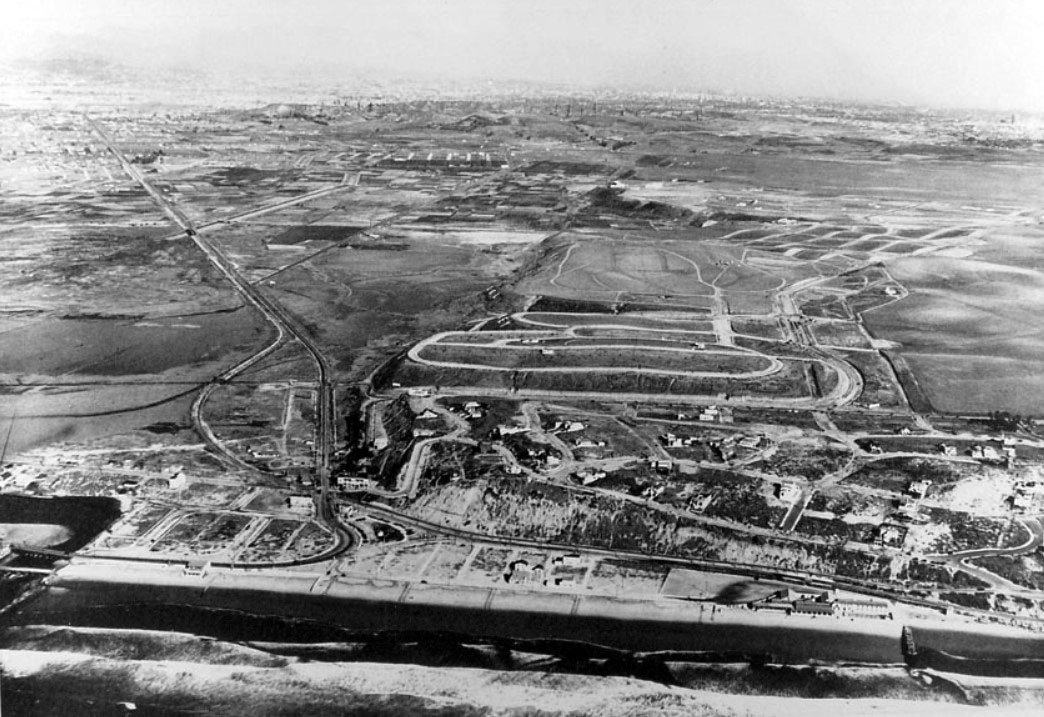 |
|
| (1921)**^# - Aerial view showing Playa del Rey, Bluffs and Playa Vista. Right side became Mines Field and later LAX. |
Historical Notes The name ‘Mines Field’ came from real estate agent William W. Mines who represented the ranching interests and he claimed his own bit of history when he clinched the deal. For years Angelinos refused to call their airport anything else. The city leased 640 acres for ten years and aviation got an immediate boost when America's National Air Races brought the crowds flocking to Mines Field to see pilots like the legendary Charles Lindbergh. ##** |
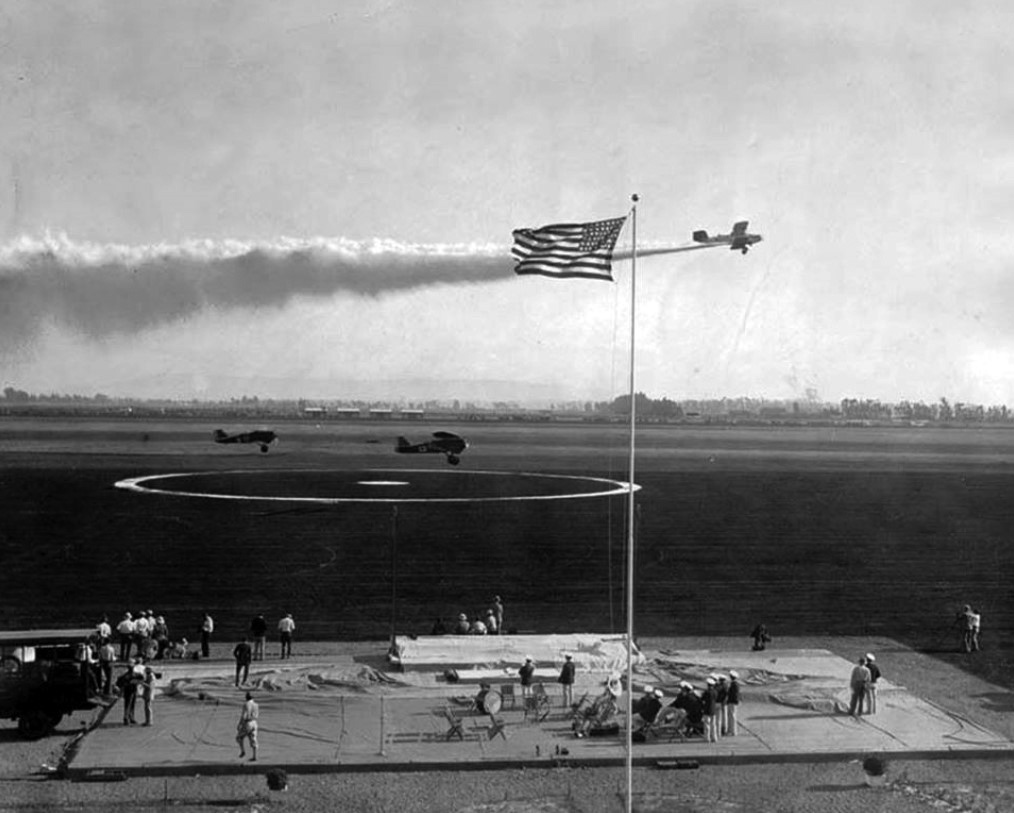 |
|
| (1928)^*^# - The opening day of the National Air Races at Mines Field (now LAX). September 8, 1928 |
Historical Notes The National Air Race was an air competition, comprised of a series of pylon and cross-country races, that took place annually from 1920 to 1949. Due to the rapid development of aviation science at that time, there was significant popular interest in this event.* |
 |
|
| (1928)^*^^ - Aerial view of the 1928 National Air Races. The packed parking lot can be seen on the right side of the photo, where passenger terminals now stand at LAX. The large crowds were partly due to the participation of Charles Lindbergh in the air races that year. |
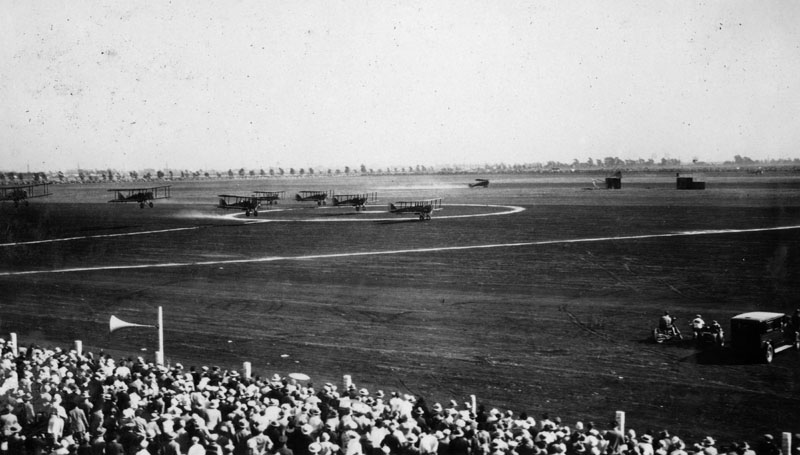 |
|
| (1928)* - Crowds watch as Army biplanes take off at Mines Field (Los Angeles International Airport) in Westchester during the 1928 National Air Races, which ran from September 8-17. |
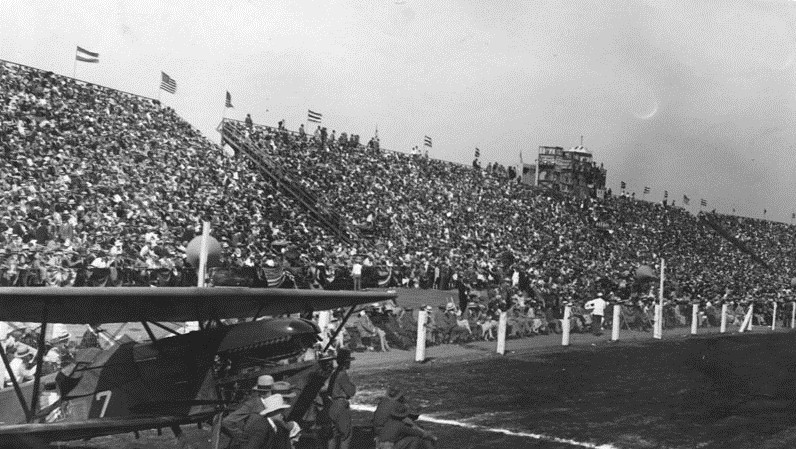 |
|
| (1928)* - View shows the crowds of people attending the National Air Races, Mines Field, September 17, 1928. |
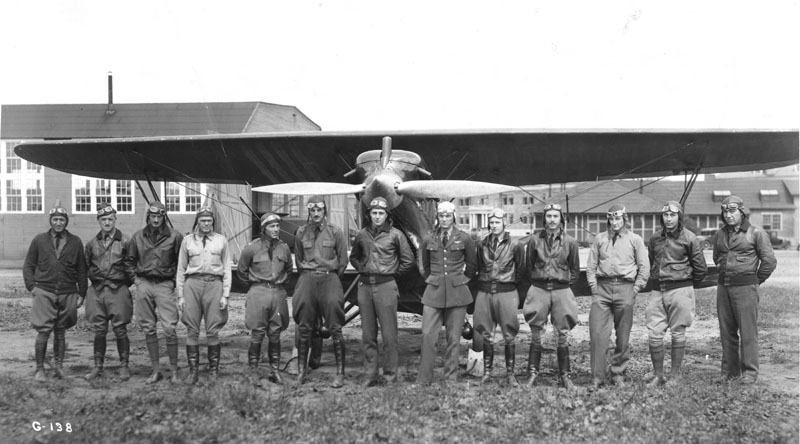 |
|
| (1928)* - For the glory of the American army and the John L. Mitchell trophy, these brave men drive their planes 160 miles per hour today in the National Air races at Mines field. This is the First Pursuit group from Selfridge field, Michigan. Left to right: Major Ralph Royce, Flight commander, Air Corps; Captain Victor H. Strahm, Air Corps.; 1st Lieut. Rex K. Stoner, Air Corps.; 1st Lieut. John K. Cannon , Air Corps.; 1st Lieut. Julian B. Haddon, Air Corps.; 2nd Lieut. Frank G. Irvin, Air Corps.; 2nd Lieut. Frank D. Klein, Air Corps.; 2nd Lieut. Ernest H. Lawson, Air Corps.; 2nd Lieut. William H. Doolittle, Air Corps.; 2nd Lieut. Burton M. Hovey, Air Corps.; 2nd Lieut. Frank H. Robinson, Air Corps.; 2nd Lieut. John F. Egan, Air Corps.; 2nd Lieut. Trevor Kenyon, Air Res.; and 2nd Lieut. Robert L. Schoenlein, Air Corps. |
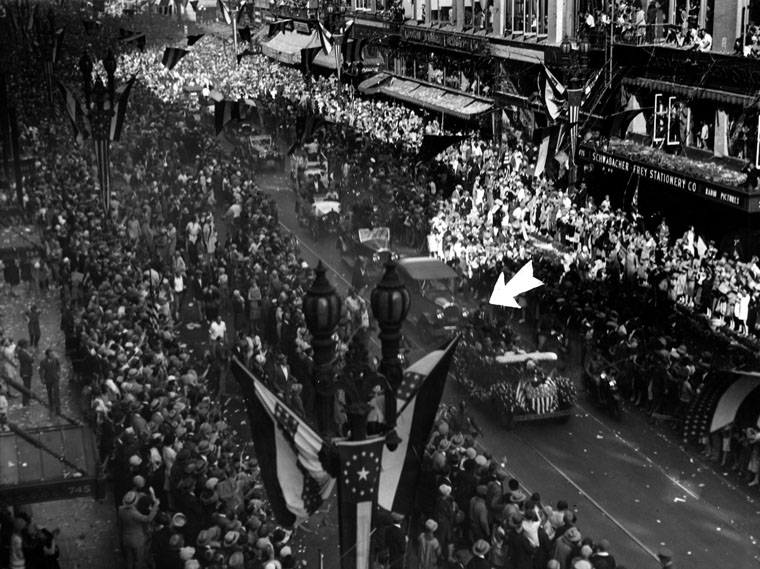 |
|
| (1927)* - Col. Charles A. Lindbergh rides down Broadway in Los Angeles in a ticker-tape parade, Sept. 21, 1927. (Arrow points out Lindbergh in his car) |
Historical Notes Charles Lindbergh's famous transatlantic flight in May 1927 convinced Los Angeles city leaders of the need for a permanent, municipal airport. With an improved runway and dedicated facilities, a city airport would encourage airmail and passenger traffic between Los Angeles and other aviation-friendly cities, while a permanent presence would allow airlines, maintenance companies, and other private enterprises to cluster around the site. In September 1927, Lindbergh himself, in Los Angeles on a nationwide victory lap, told a Coliseum crowd of roughly 60,000 that "airports are the most important factor in the development of aviation...I wish to say that if you expect to keep your city on the air map, it will be necessary to construct a municipal airport".**^ |
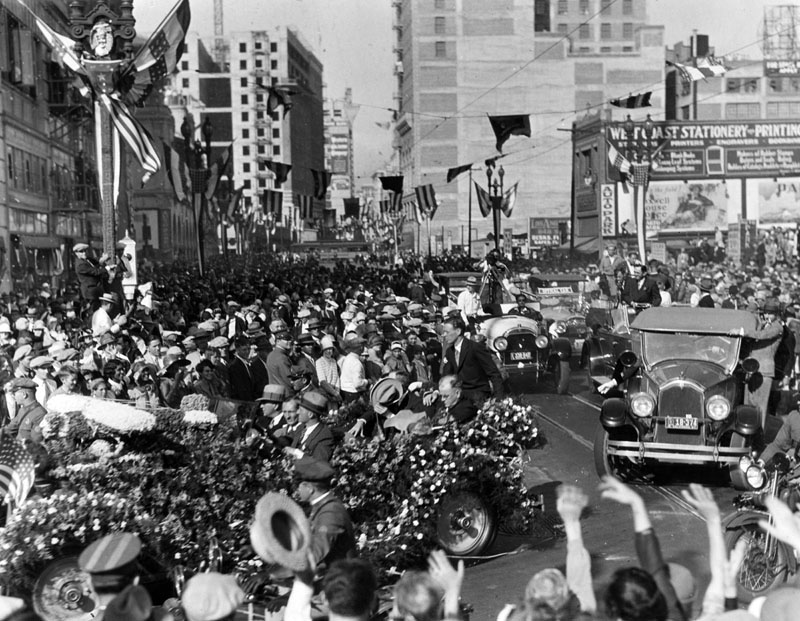 |
|
| (1927)* - View of a parade honoring Col. Charles A. Lindbergh, as it passes in front several large buildings along Broadway and 10th Street, in Downtown Los Angeles. Col. Lindbergh (wearing a dark suit) can be seen sitting atop the seat at the rear of the car decorated entirely with white roses; then-Mayor Porter sits next to him. The parade took place on September 21, 1927, four months to the day after Col. Lindbergh flew solo non-stop from Roosevelt Field to Paris aboard the "Spirit of St. Louis". |
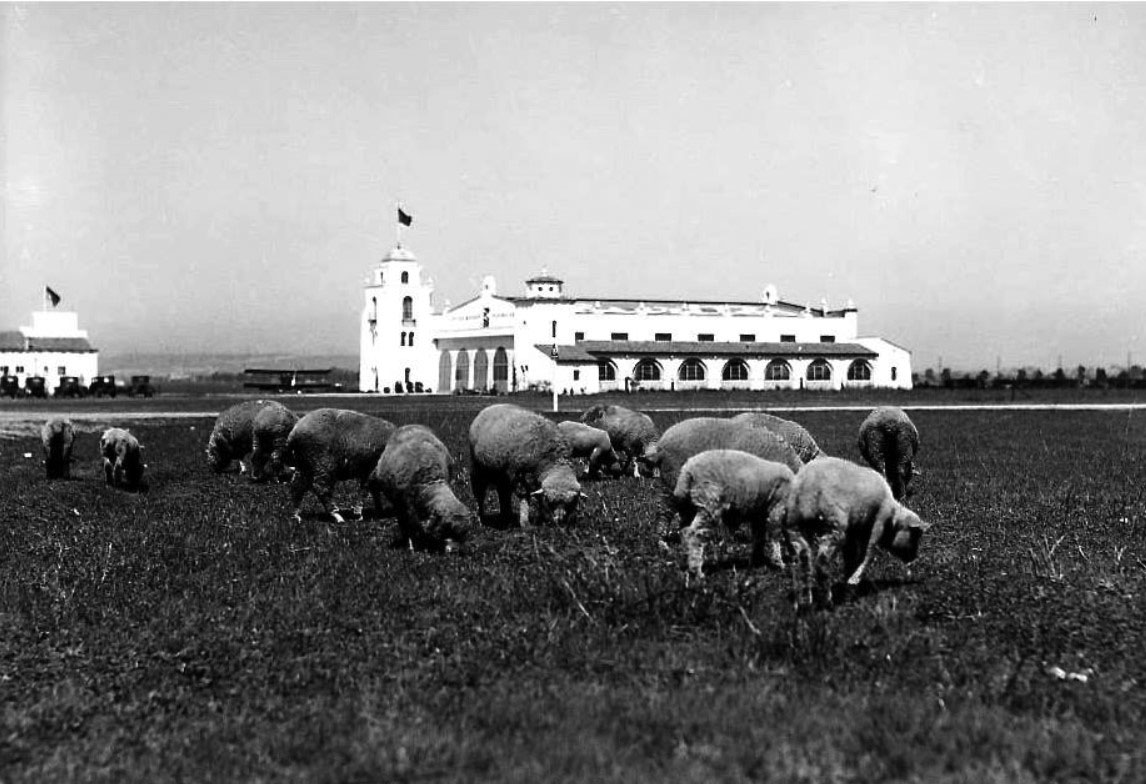 |
|
| (ca. 1928)*## – Sheep grazing near the runway at Mines Field. |
Historical Notes In 1928, the Los Angeles City Council selected 640 acres (1.00 sq. mile) in the southern part of Westchester as the site of a new airport for the city. The fields of wheat, barley and lima beans were converted into dirt landing strips without any terminal buildings. It was named Mines Field for William W. Mines, the real estate agent who arranged the deal. The City signed a 10-year lease* |
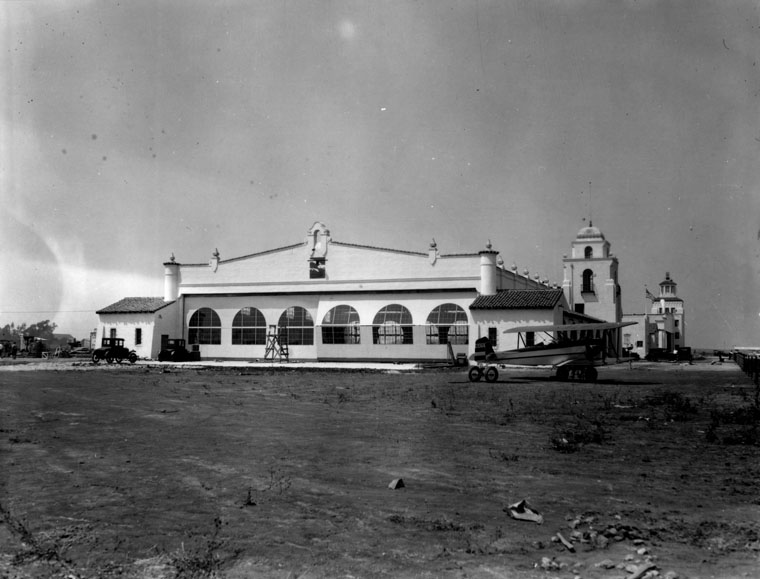 |
|
| (ca. 1928)* - View of the administration building at Mines Field (later to become the Los Angeles International Airport) |
 |
|
| (ca. 1928)* - Wide angle view of Mines Field (later known as Los Angeles International Airport) showing the more important buildings. |
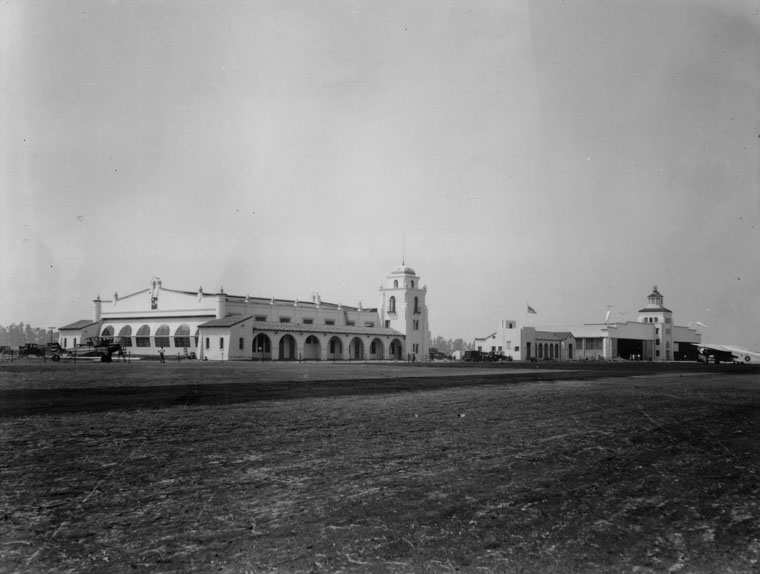 |
|
| (ca. 1928)* - Administration building in foreground and hangars in background at Mines Field (later to become the L.A. International Airport) |
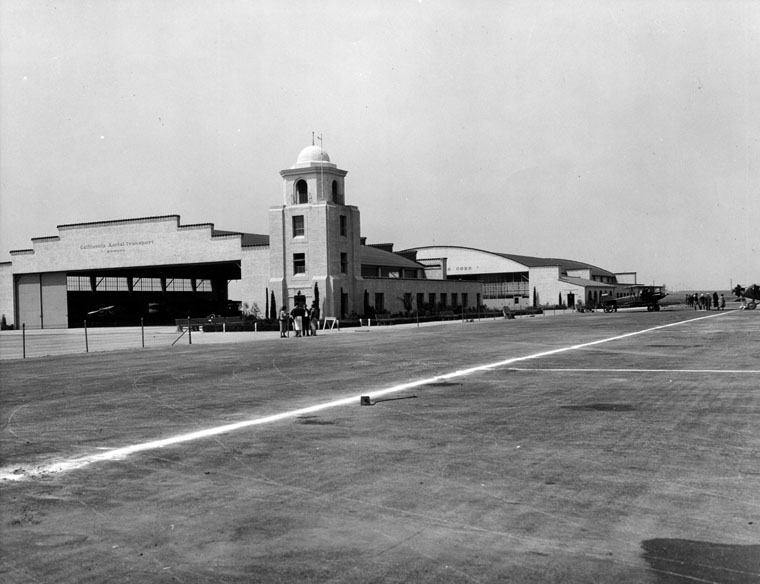 |
|
| (ca. 1928)* - California Aerial Transport School and other buildings at Mines Field (later to become the Los Angeles International Airport) |
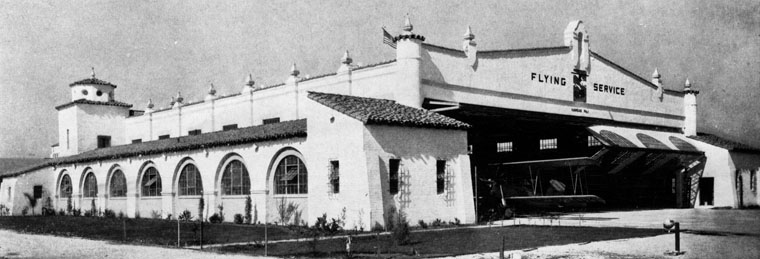 |
|
| (ca. 1928)* - Flying service building at Mines Field (later known as Los Angeles International Airport) |
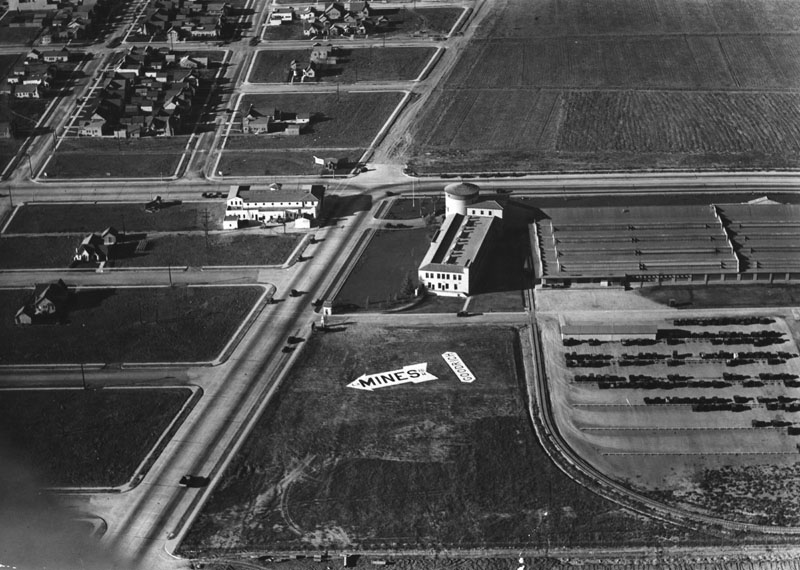 |
|
| (1928)* - Fliers seeking Mines Field, new municipal airport and site of the National Air Races, will hereafter find the way pointed out to them unmistakably by six huge aerial markers. |
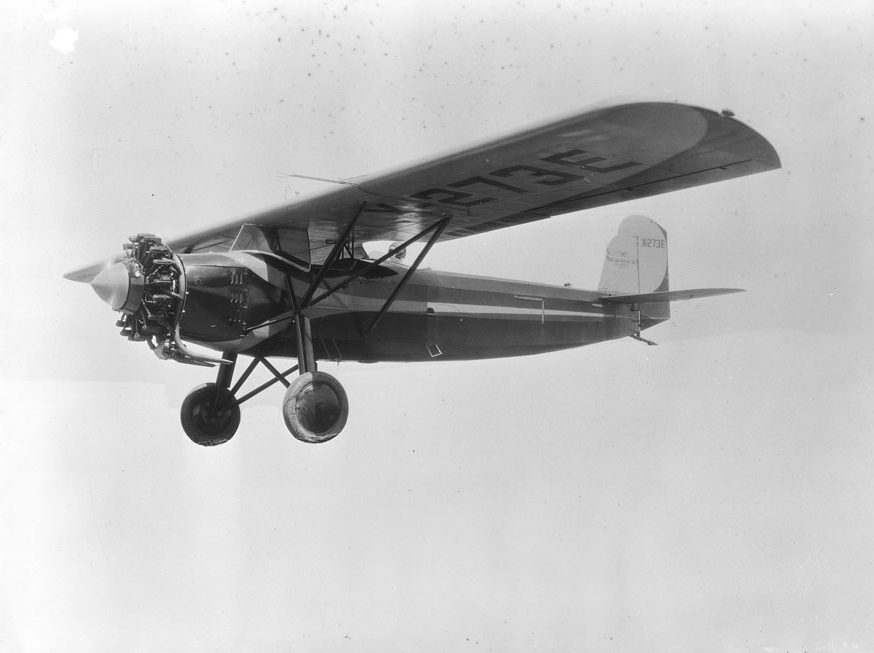 |
|
| (1929)^* - Photo of monoplane in flight near Mines Field factory, 1929. The plane was made by Moreland Aircraft Company which was located at Mines Field. |
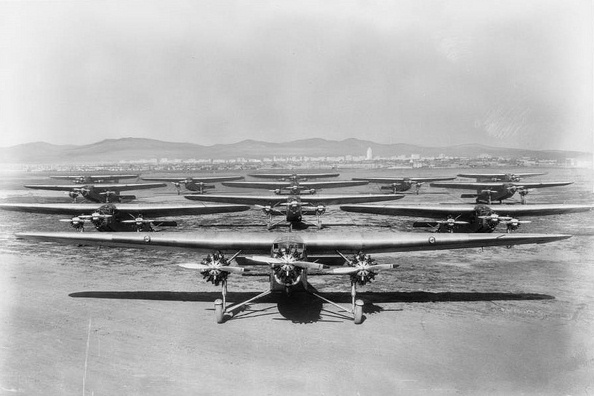 |
|
| (1929)^*# - View of the Maddux Air Lines fleet at Mines Field. |
Historical Notes In 1927 Jack L. Maddux, an owner of a Los Angeles Ford and Lincoln car dealership, founded Maddux Airlines. The airline’s inaugural flight was on September 22, 1927 when the airline’s Ford 4-AT Tri-motor carrying 12 passengers flew from San Diego to Los Angeles. This flight was to a small dirt landing strip that would later become Mines Field then Los Angeles International Airport, although the landing strip, called Inglewood Site, was not suitable for the airline, and Jack Maddux chose instead Rogers Airport, with improved facilities, and later Grand Central Air Terminal in Glendale. On August 26, 1929 a Maddux Tri-motor, along with other aircraft, escorted the famous LZ 127 Graf Zeppelin airship to Mines Field where it stopped during its around the world flight. Among the famous aviators who were involved with Maddux were Charles Lindbergh and Amelia Earhart. Maddux also had a publicity department that advertised the celebrities who flew with the airline. These included Will Rogers, who rode on the inaugural flight, and Hollywood actors Arthur Edmund Carewe and Dolores del Río. Click HERE for more on Maddux Airlines. |
* * * * * |
Graf Zeppelin Comes to Los Angeles
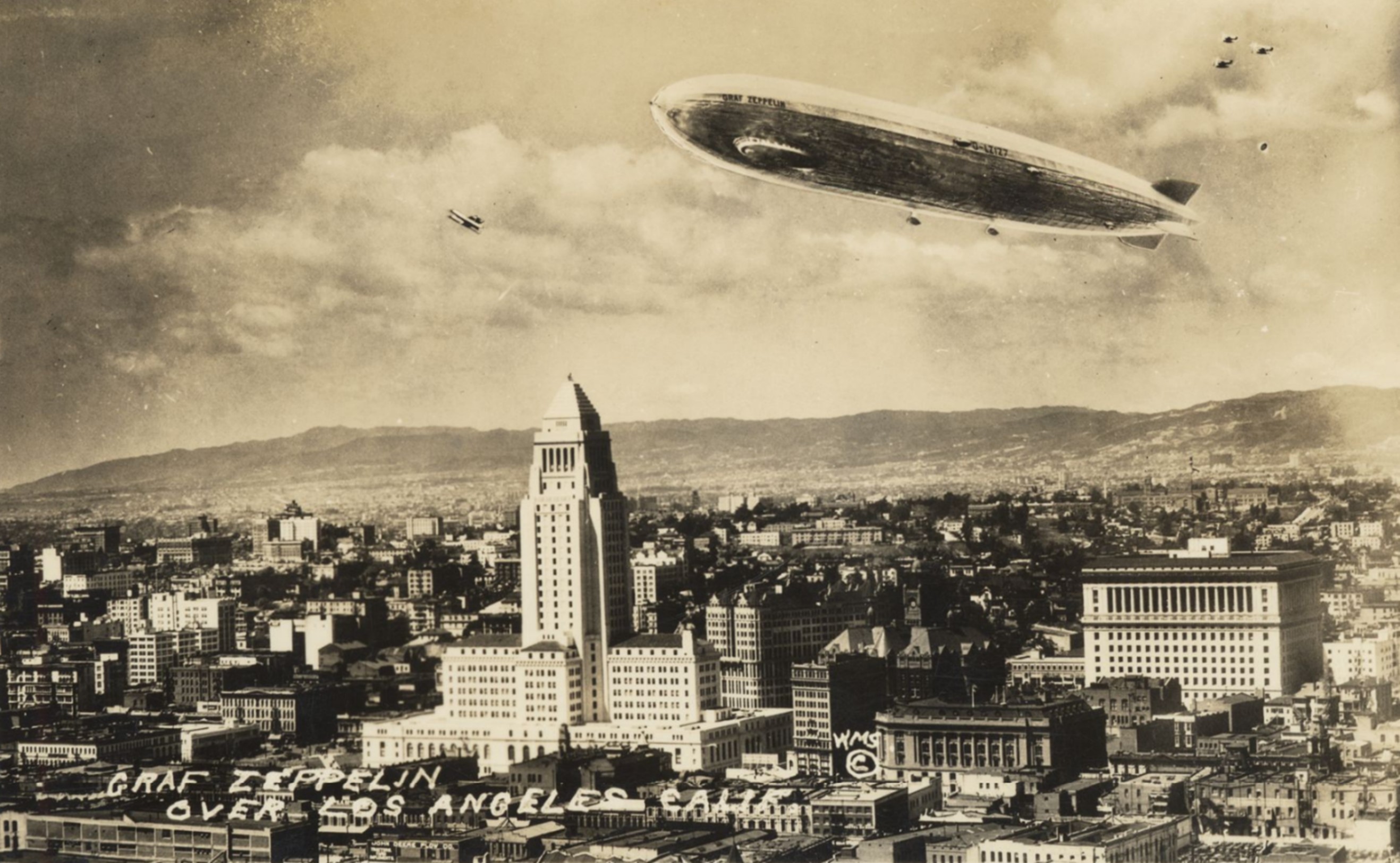 |
|
| (1929)* – A postcard view showing the Graf Zeppelin airship accompanied by a group of bi-planes flying over Los Angeles. |
Historical Notes In 1929, Graf Zeppelin made perhaps its most famous flight; a round-the-world voyage covering 21,2500 miles in five legs from Lakehurst to Friedrichshafen, Friedrichshafen to Tokyo, Tokyo to Los Angeles, Los Angeles to Lakehurst, and then Lakehurst to Friedrichshafen again. The round-the-world-trip was partly sponsored by American newspaper publisher William Randolph Hearst, who paid for about half the cost of the flight in return for exclusive media rights in the United States and Britain. |
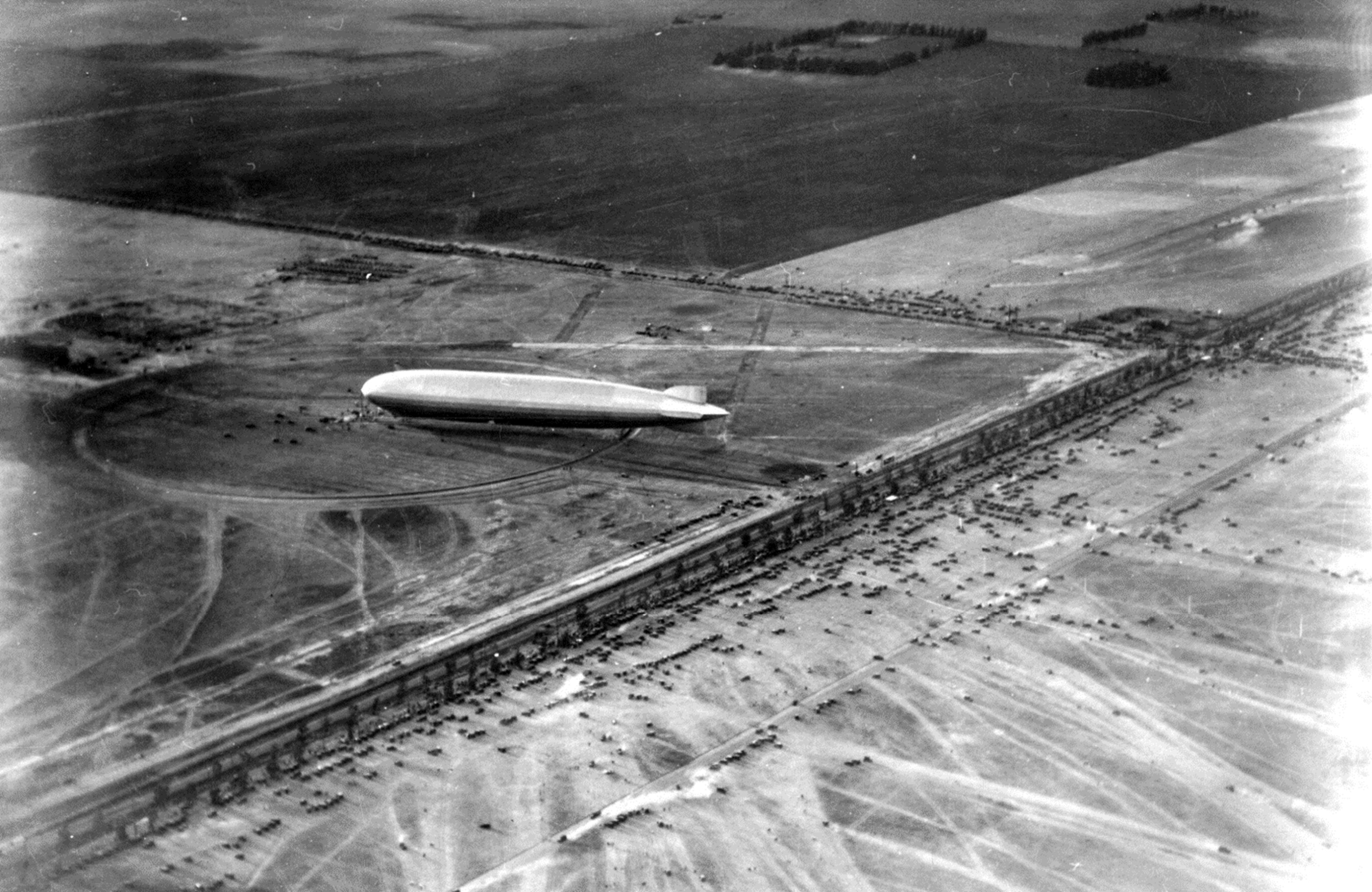 |
|
| (1929)* - The Graf Zeppelin landing at Mines Field, photographed from a Ford TriMotor plane. |
Historical Notes CThe Graf Zeppelin arrived at Mines Field in Los Angeles on August 26, 1929, after a 79-hour flight from Tokyo. This stop was part of the airship's famous Round-the-World flight in 1929. The massive dirigible measured 770 feet in length and 116 feet at its widest point. The airship landed at Mines Field, which is now the site of Los Angeles International Airport. The arrival was met with great excitement and anticipation, with an estimated 500,000 people gathering to witness the event. Many spectators camped overnight, equipped with tents and portable stoves, while vendors set up makeshift stands to sell food and drinks. |
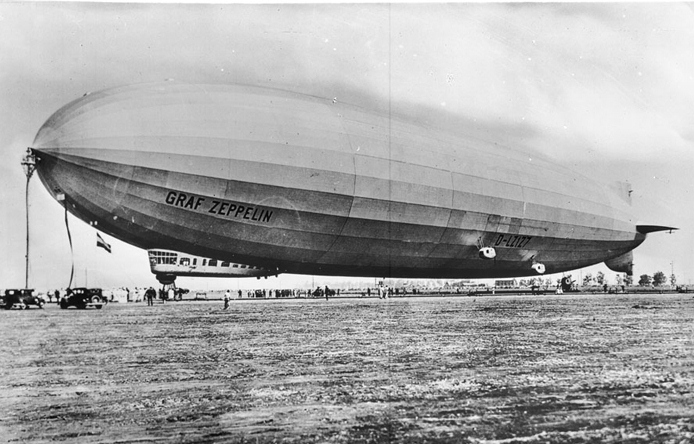 |
|
| (1929)^* - Closer view of the Graf Zeppelin from the side facing left, with people and automobiles visible beneath it. |
Historical Notes "Graf Zeppelin" means "Count Zeppelin," referring to Count Ferdinand von Zeppelin, the German aviation pioneer who founded the Zeppelin airship company. The word "Graf" is a German title of nobility that translates to "Count." |
 |
|
| (1929)* – View looking at the rear of the Graf Zeppelin from behind the gas equipment used for refueling the aircraft. |
Historical Notes The Graf Zeppelin employed a unique dual-fuel system combining Blau gas and gasoline. Blau gas, the primary fuel, had a density similar to air, which prevented significant changes in buoyancy as it was consumed, allowing stable flight without the need to vent hydrogen. The airship carried about 1,059,435 cubic feet of Blau gas, providing over 100 hours of flying time. Gasoline was also used, primarily to lighten the airship's load more effectively than Blau gas. This combination allowed the Graf Zeppelin to maximize its endurance, enabling up to 118 hours of cruising when both fuels were utilized. This innovative system addressed the challenge of maintaining aerostatic balance during long flights, contributing to the airship's operational success and extended range. |
_1929.jpg) |
|
| (1929)* - Postcard view of the Graf Zepelin at a stopever at Los Angeles' Mines Field on its "Around the World Trip". |
Historical Notes The Zeppelin was a type of rigid airship pioneered by the German Count Ferdinand von Zeppelin in the early 20th century. It was based on designs he had outlined in 1874 and detailed in 1893. His plans were reviewed by committee in 1894 and patented in the United States in 1899. Given the outstanding success of the Zeppelin design, the term zeppelin in casual use came to refer to all rigid airships. |
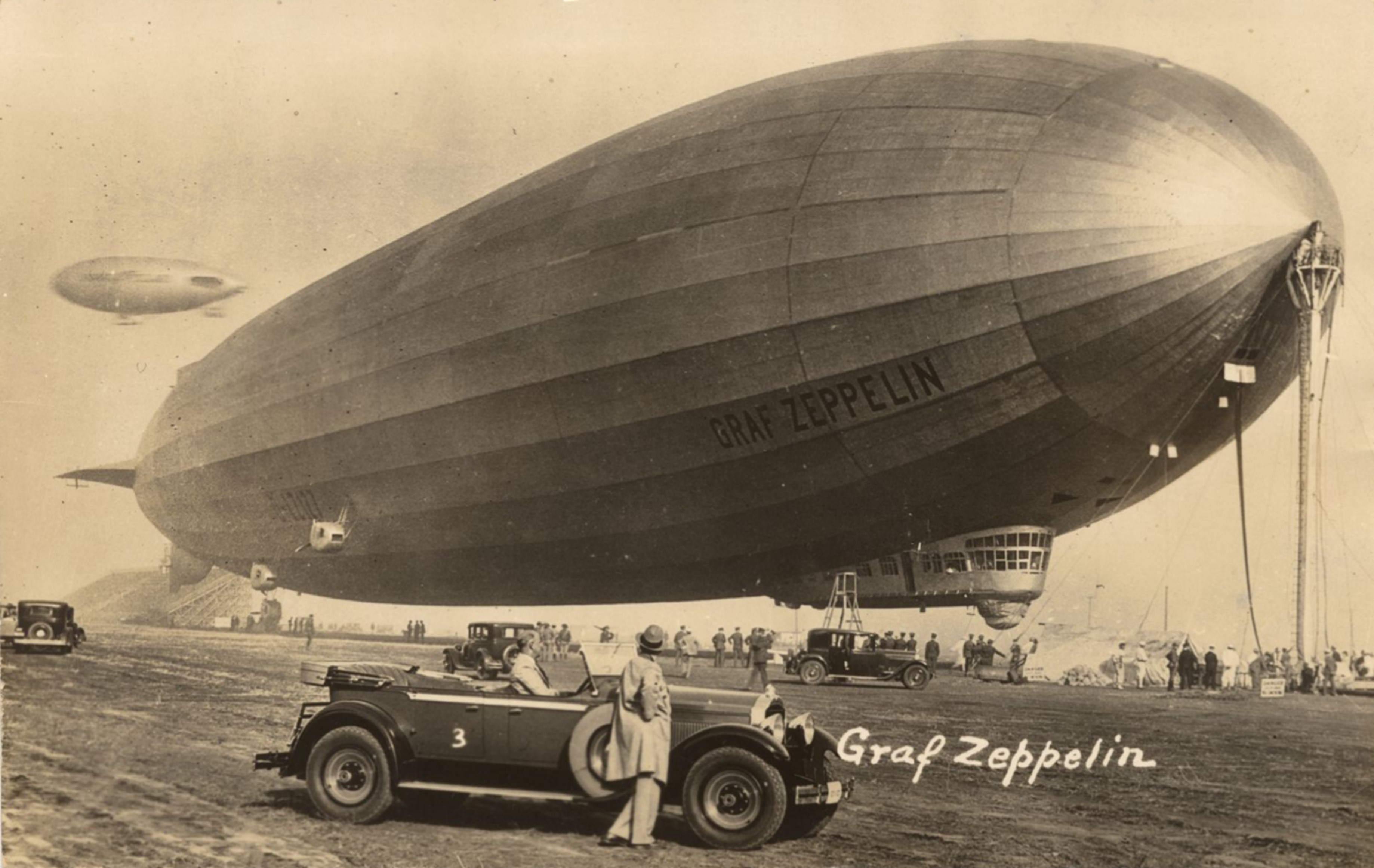 |
|
| (1929)* – View showing a 1929 Packard and the Graf Zeppelin at Mines Field, Los Angeles. In the distance can be seen the Goodyear Blimp. |
Historical Notes In 1930, the Graf Zeppelin began regular transatlantic commercial flights. It had 20 sleeping berths for passengers and a crew of 36. Its first flight was in 1928, its last in 1937, after 590 total flights. The Graf Zeppelin was retired one month after the Hindenberg disaster. |
.jpg) |
|
| (1929)* – View showing a 1929 Packard and the Graf Zeppelin at Mines Field, Los Angeles. In the distance can be seen the Goodyear Blimp. |
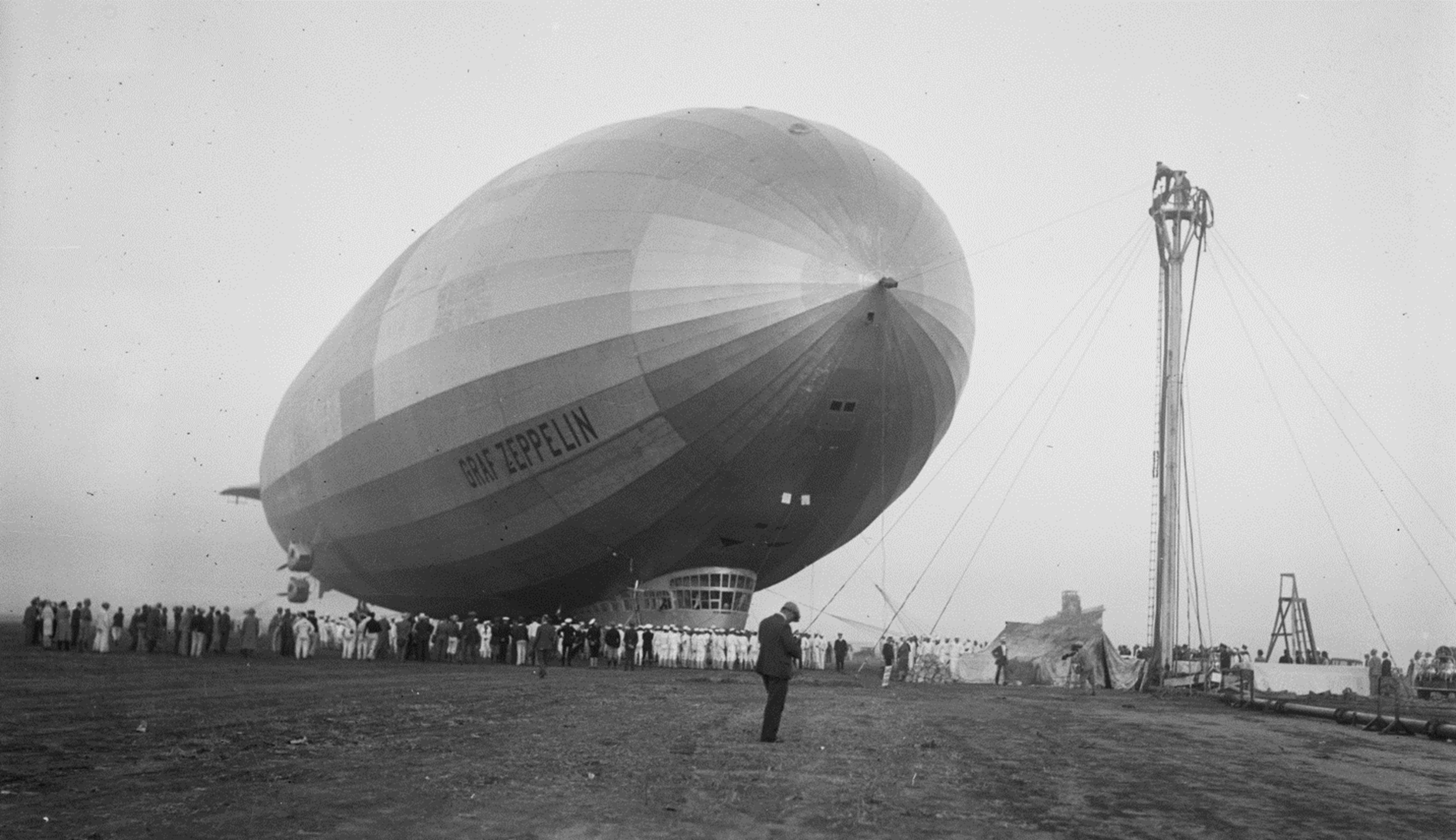 |
|
| (1929)* - Image of the Graf Zeppelin dirigible moored in a field at the Los Angeles Municipal Airport and surrounded by crowds, during a stop by the airship during its around-the-world flight. |
Historical Notes Zeppelins were first flown commercially in 1910 by Deutsche Luftschiffahrts-AG (DELAG), the world's first airline in revenue service. By mid-1914, DELAG had carried over 34,000 passengers on over 1,500 flights. After the outbreak of World War I, the German military made extensive use of Zeppelins as bombers and scouts. |
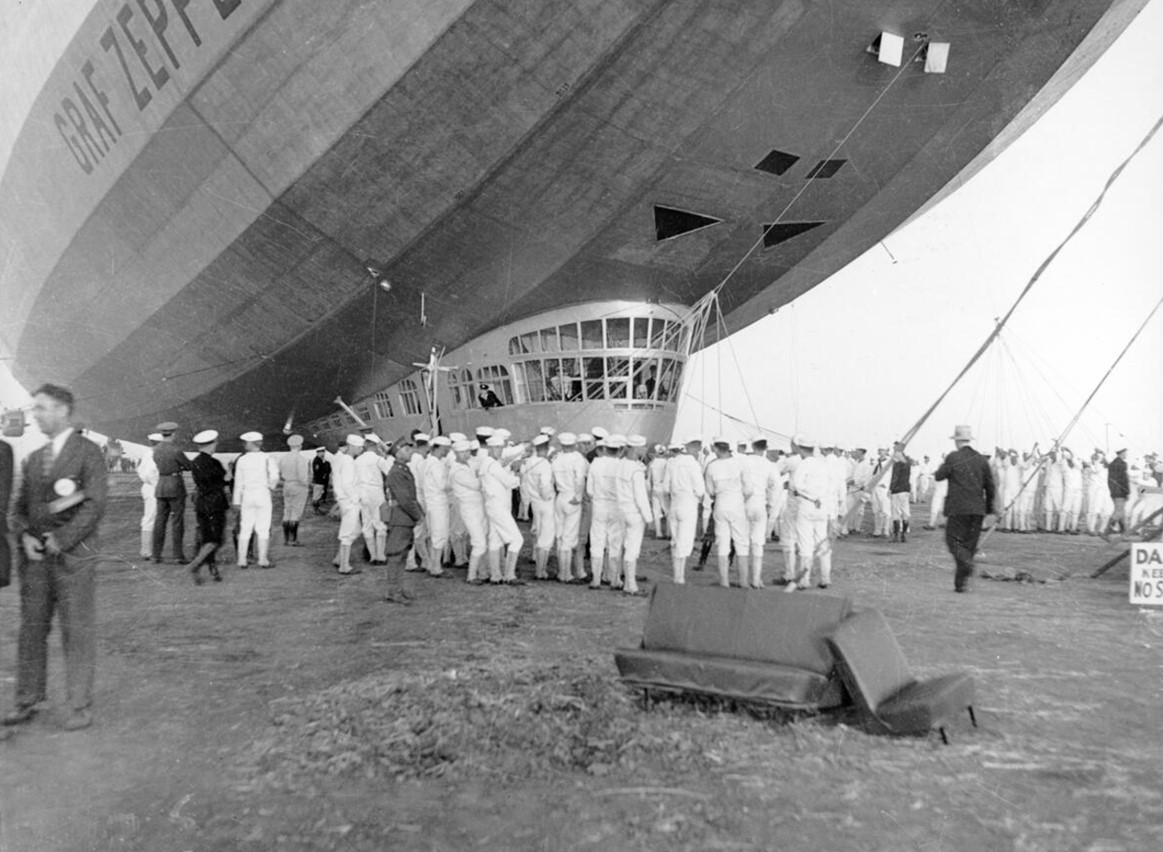 |
|
| (1929)* – Close-up view of the Graf Zeppelin at the Mines Field. A large group of uniformed men stands in the field below the zeppelin, along with two seats that sit in the foreground. Anchor ropes for the zeppelin diagonally cross the lower right corner of the image. |
Historical Notes CThe Graf Zeppelin maintained a flawless passenger safety record throughout its operational history from 1928 to 1937, never injuring a passenger or crew member. |
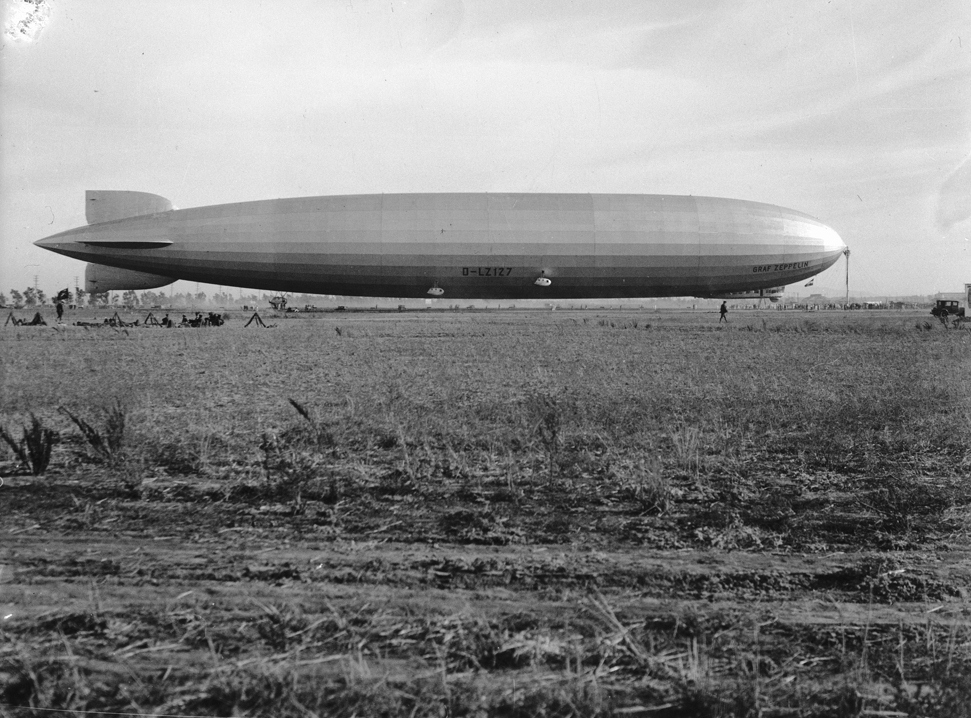 |
|
| (1929)^* - Photograph of Graf Zeppelin at Mines Field. The LZ-127 Graf Zeppelin was 776 feet long and 100 feet in diameter. |
Historical Notes The airship achieved several significant milestones during this period, including the first commercial passenger flight across the Atlantic in October 1928 and the first passenger-carrying flight around the world in 1929. In July 1931, it conducted a scientific mission over the North Pole, performing meteorological observations and mapping unmapped regions. |
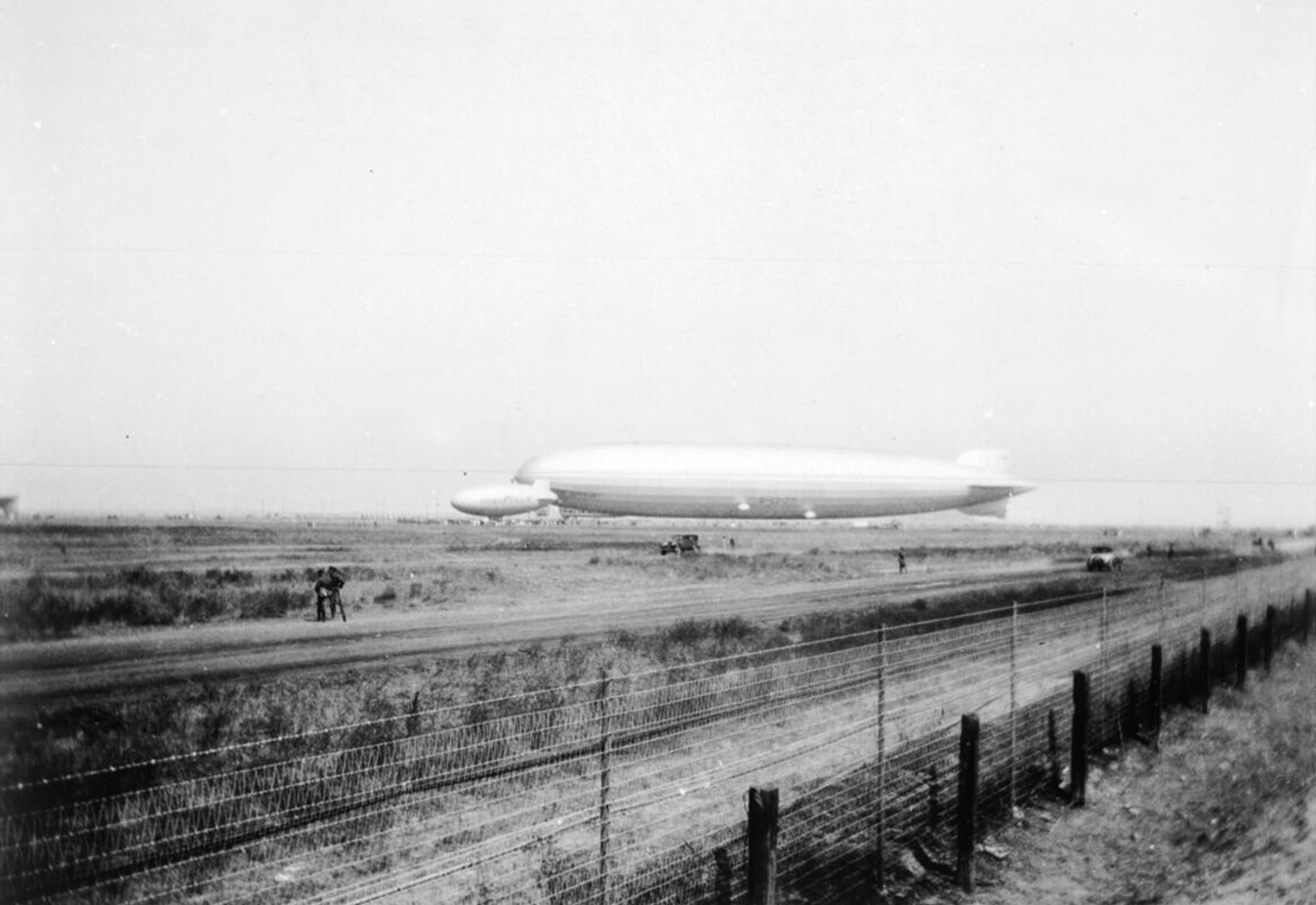 |
|
| (1929)* – View showing the Graff Zeppelin and the Goodyear Blimp in a field. The Graff Zeppelin sits in a field at the center of the image, with the Goodyear blimp in front of its left edge. A few automobiles and men are scattered throughout the field's thick vegetation. A wire fence borders the field in the foreground, running diagonally from the lower left corner to the center right. |
Historical Notes The Graf Zeppelin pioneered regularly scheduled, nonstop, intercontinental airline service and participated in notable events such as the 1933 Chicago World's Fair. Additionally, from 1931 to 1937, it established regular service to South America, particularly to Brazil and Argentina. |
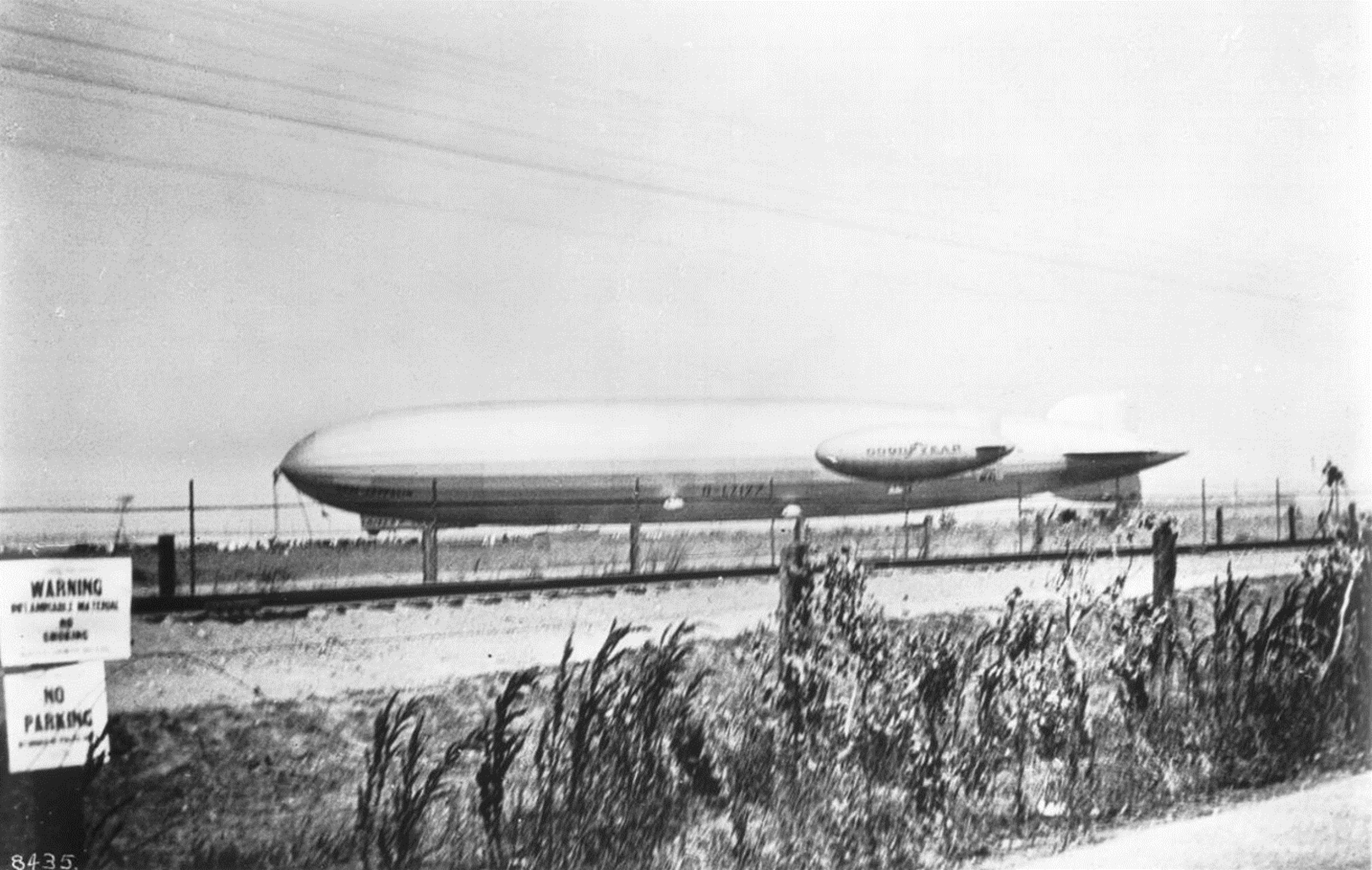 |
|
| (1929)* - Photograph of the Graf Zeppelin and the small Goodyear pony blimp floating (or parked?) next to each other, 1929. The Graf Zeppelin is about ten times the size of the Goodyear blimp. Both the blimps are on the other side of the fence in the foreground. Several warning signs are posted up including a no-parking sign. |
Historical Notes The LZ 127 Graf Zeppelin was in service for nearly nine years, from its first flight on September 18, 1928, to its last on June 18, 1937. During this period, it completed 590 flights, covering over 1.7 million kilometers (more than 1 million miles), and carried 13,110 passengers across 144 ocean crossings, all while maintaining a perfect passenger safety record. This made it the most successful rigid airship ever built. The Graf Zeppelin's retirement was directly linked to the Hindenburg disaster on May 6, 1937. After its final passenger flight from Brazil to Germany on May 8, 1937, it was grounded and officially withdrawn from service, eventually being scrapped in March 1940 by order of Hermann Goering's Luftwaffe. |
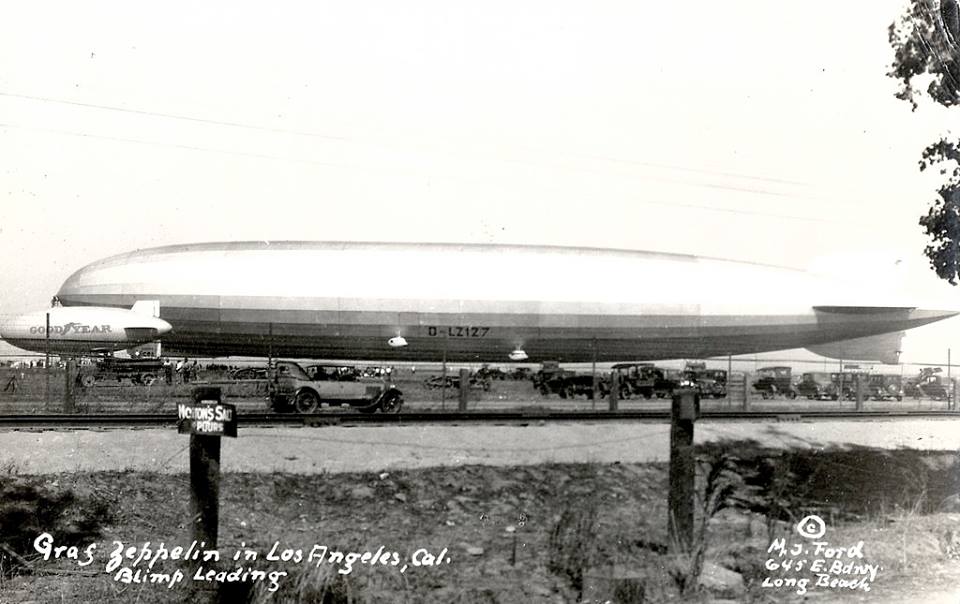 |
|
| (1929)* - Closer view of the Goodyear Blimp alongside the Graf Zeppelin showing the size disparity. |
Historical Notes Passengers were treated to high-quality meals served in a dedicated dining area, establishing the precedent for fine dining in the air. |
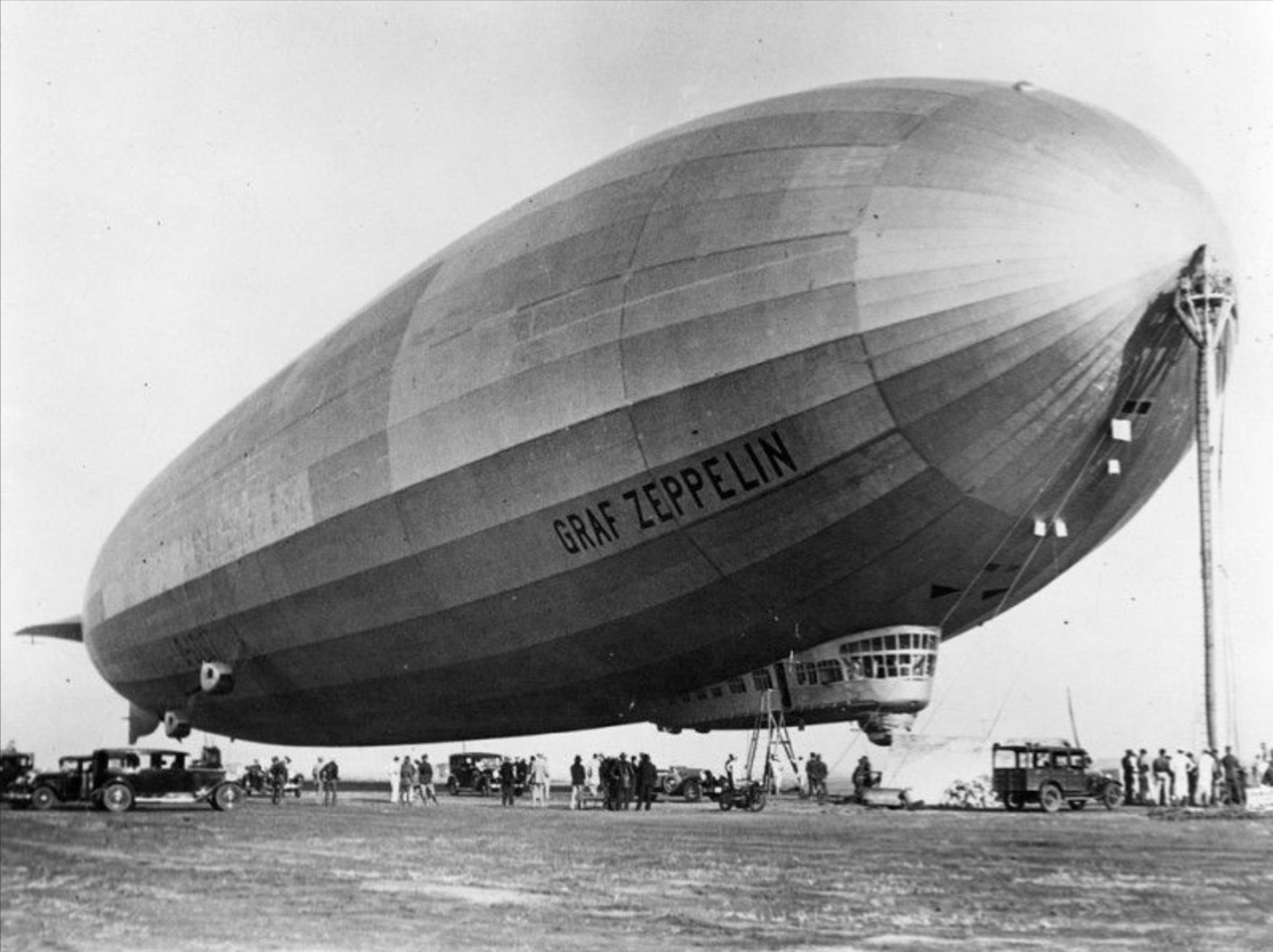 |
|
| (1933)* - The Graf Zeppelin airship is anchored to the ground as workmen and other officials ready her. A ladder extends to the doorway of the cabin. Several men gather around the hose that rises to the tip of the airship. Motorcycles and cars are parked haphazardly on the field. Photo dated: July 8, 1933. |
Historical Notes The Graf Zeppelin visited Los Angeles several times during its operational years. Its first visit was on August 26, 1929, during its Round-the-World flight. In 1933, it returned as part of a promotional tour that included a flight to the Chicago World's Fair. The airship made another notable visit in 1936 during a series of flights promoting the Olympics in Berlin and other international events. |
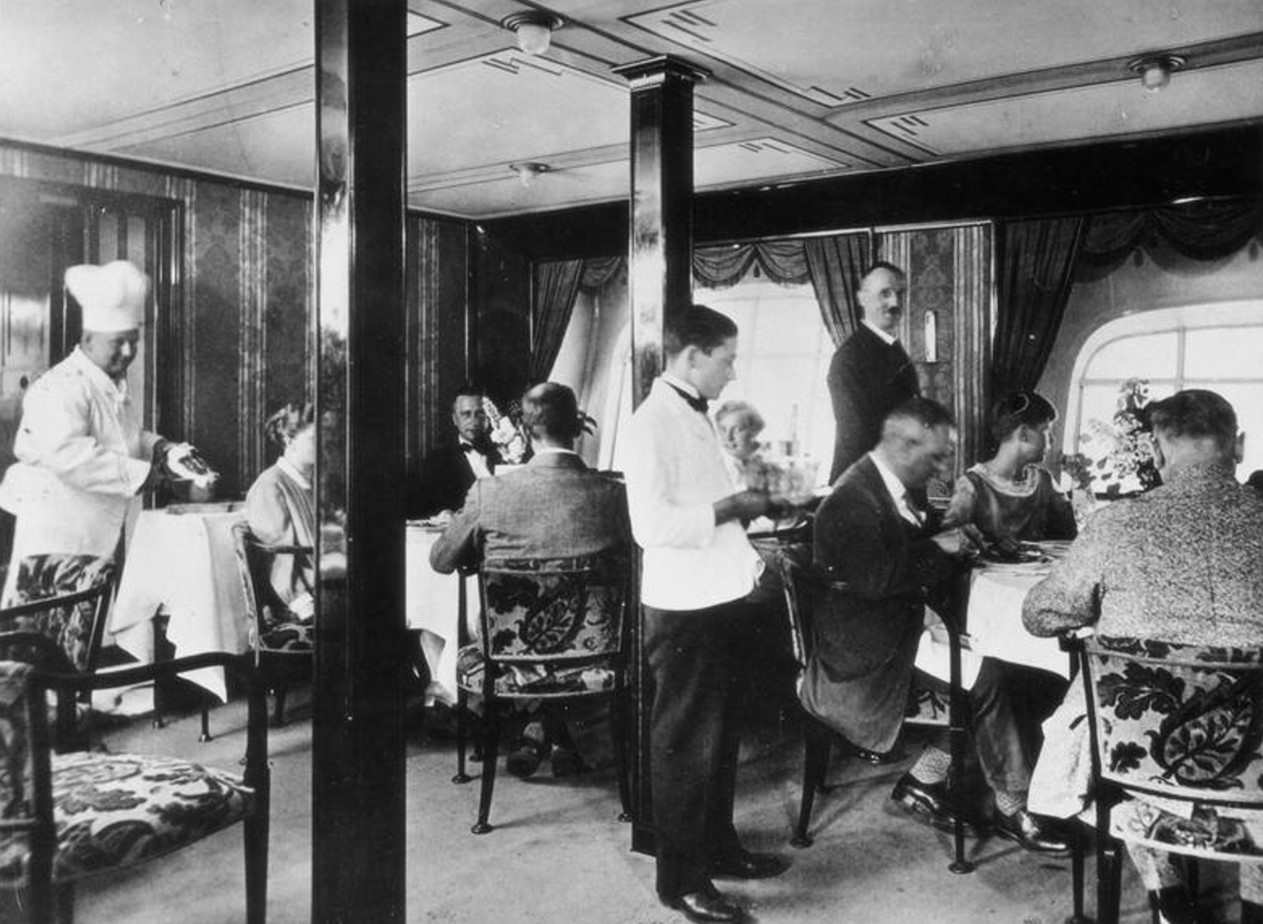 |
|
| (1929)* - Dining on the Graf Zeppelin. Passengers were treated to high-quality meals served in a dedicated dining area, establishing the precedent for fine dining in the air. |
Historical Notes The visit of the Graf Zeppelin left a lasting impression on Los Angeles. It inspired the creation of the Zep Diner, a temporary landmark near the intersection of W. Florence Avenue and S. Figueroa, which has since become a McDonald's parking lot. The event was extensively covered by the press, with numerous photographs and articles documenting the airship's presence in the city. Click HERE to see more of the Zep Diner. |
* * * * * |
Good Year Blimp at Mines Field
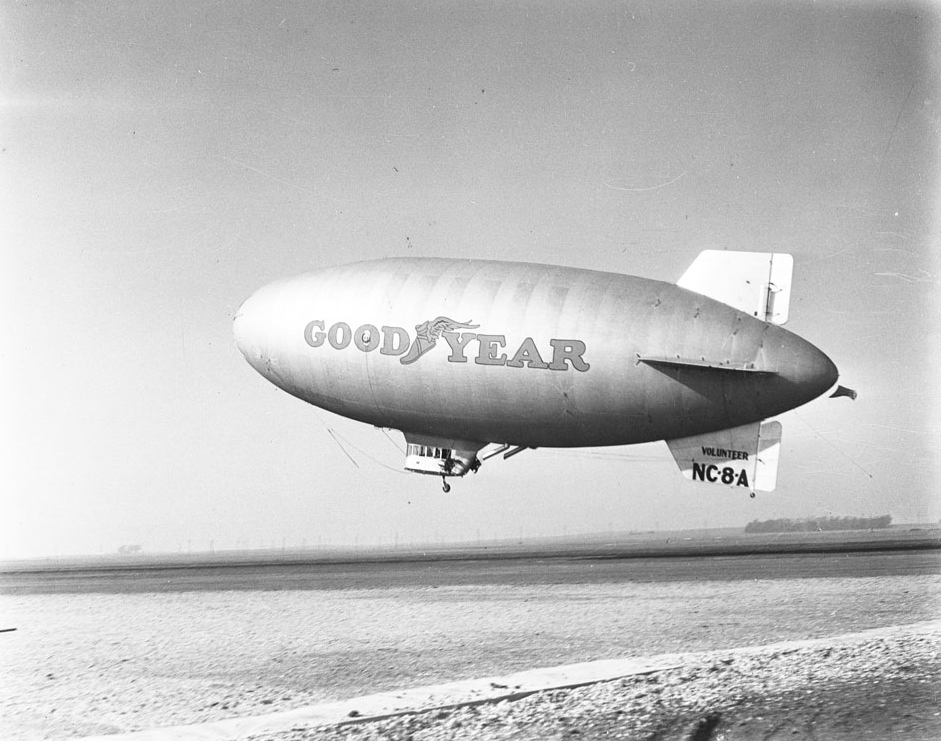 |
|
| (1930)* - Photograph of a Goodyear Blimp over Mines Field, February 7, 1930. The large blimp with the logo of "Goodyear" flies at center with "Volunteer NC-8-A" printed on one of its fin-like features at right. The empty, dirt field lies below. |
Historical Notes Goodyear began producing airship envelopes in 1911 and introduced its own blimp, Since 1928, Goodyear had named its blimps after the U.S. winners of the America's Cup yacht race. This naming method is attributed to then-Goodyear CEO Paul W. Litchfield, who viewed the airships as being like yachts in the sky. Although that practice deviated with the introduction of the Spirit of Akron in 1987, the Florida-based Stars & Stripes would be the last to carry this honor, ending in 2005. According to the Goodyear website, the three active GZ-20 blimps are 192 feet long, 59.5 feet tall, and 50 feet wide. For comparison, the largest airships ever built, the Zeppelin company's Hindenburg, LZ-129, and the Graf Zeppelin II, LZ-130, were 804 feet long and 135 feet in diameter. That is, over four times as long and over twice as wide as the current Goodyear blimps. |
* * * * * |
Hangar No. 1
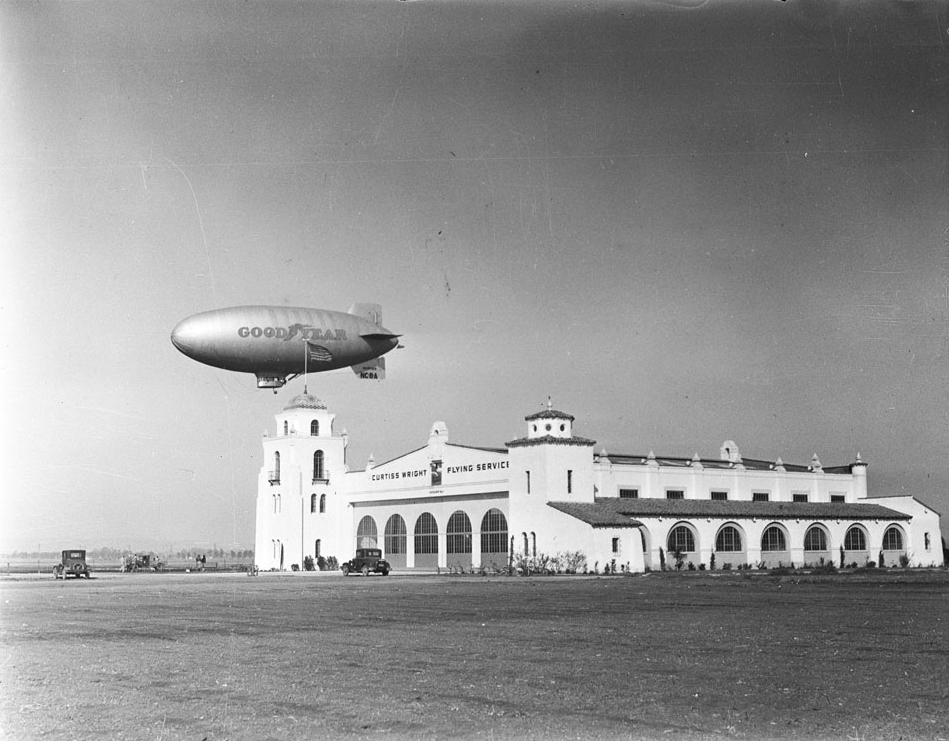 |
|
| (1930)* - Goodyear blimp flying over Hangar No. 1 at Mines Field, February 7, 1930. |
Historical Notes Hangar No. 1 was completed in 1929 and was the first permanent building constructed at Mines Field. At the time, the airport was little more than a dirt landing strip surrounded by open farmland. Designed by the firm Gable and Wyant, the hangar used Spanish Colonial Revival styling, giving the city’s new airport a sense of pride and permanence from the very beginning. The hangar was leased to the Curtiss Wright Flying Service, which operated a civilian flight school and aircraft maintenance facility. This image captures the moment when aviation in Los Angeles was transitioning from novelty to serious industry, even though the landscape around the hangar still looked rural and undeveloped. |
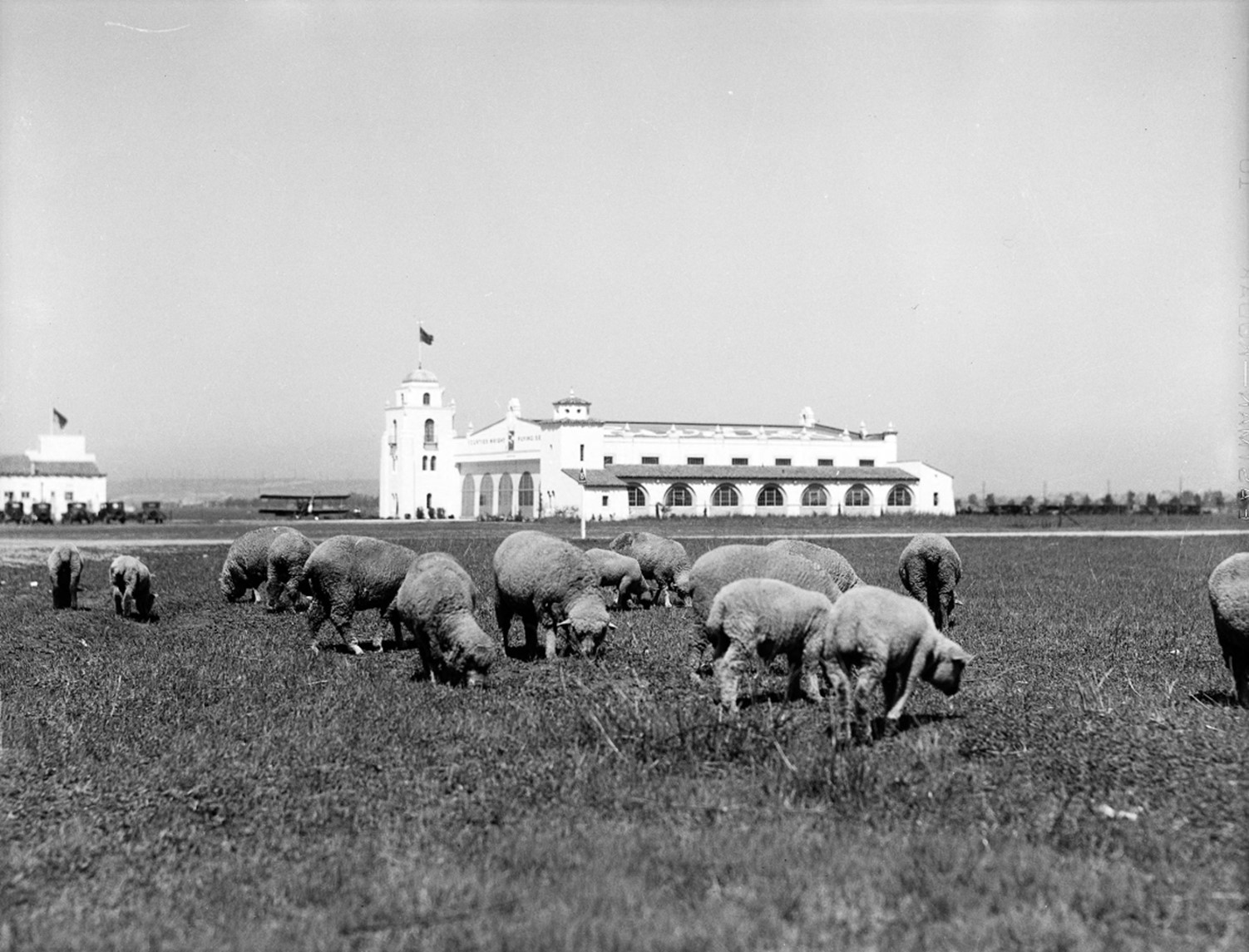 |
|
| (1930)* – Sheep grazing near the runway at Mines Field with Hangar No.1, the first structure built at the airport, in the background. Photo by Dick Whittington |
Historical Notes In its earliest years, Mines Field existed side by side with agriculture. Sheep grazing near the runways was not unusual, and nearby fields still produced crops like barley and beans. This photo shows how informal and open the airport was before fencing, paved runways, and large terminals became standard. Hangar No. 1 served as the center of airport activity and stood alone as the only major structure on the field. The hangar witnessed several historic events, including visits by Charles Lindbergh and the 1929 stop of the German airship Graf Zeppelin, which drew massive crowds and helped put Los Angeles aviation on the world stage. |
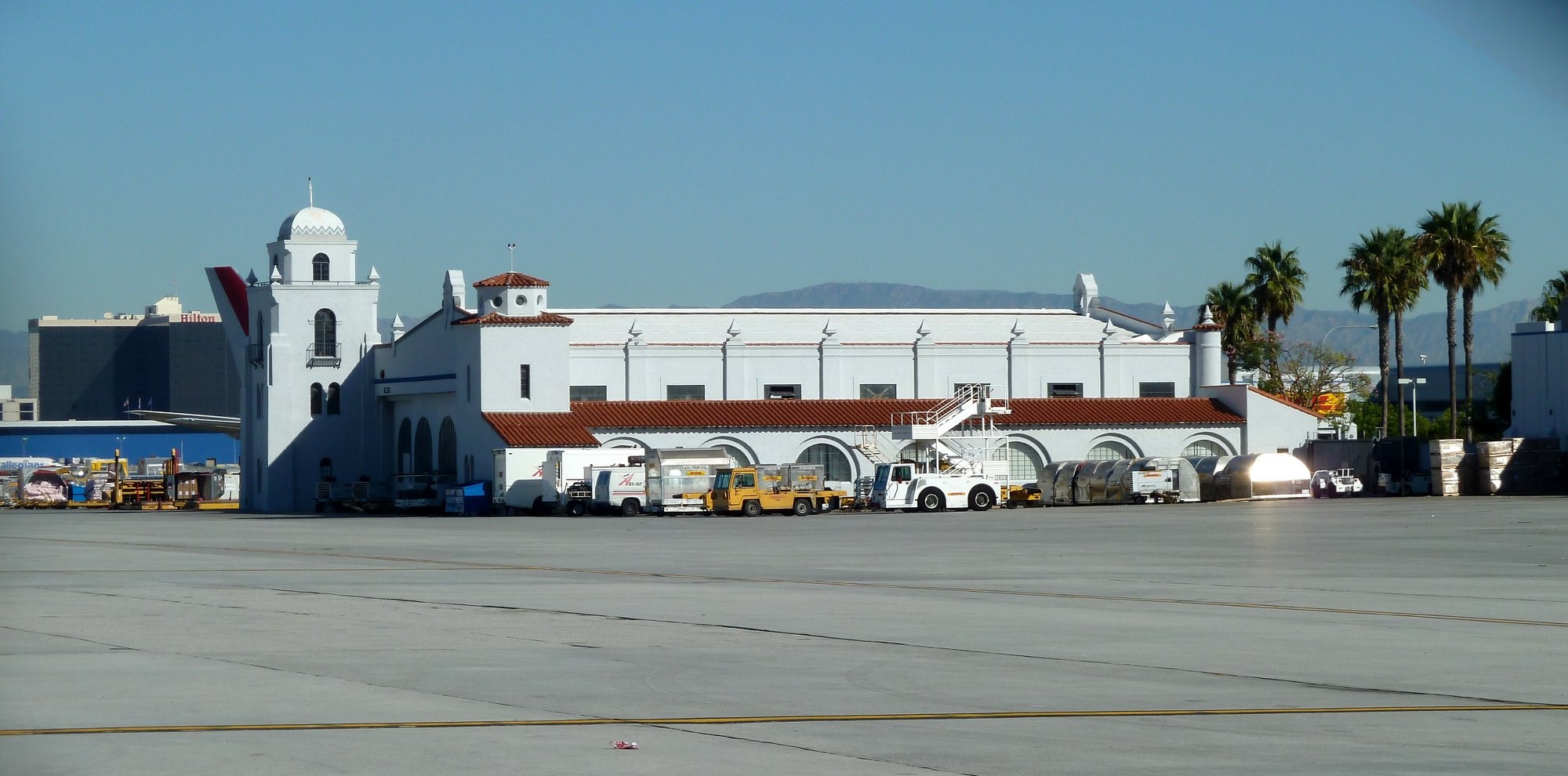 |
|
| (2019)* - Hangar No. 1 at LAX, the oldest surviving structure from the original Mines Field airport. Photo by Bobak Ha'Eri / Wikipedia. |
Historical Notes By the 1970s, Hangar No. 1 had fallen into limited use as newer facilities replaced early airport buildings. In 1990, the hangar was restored at a cost of about two million dollars to bring back its original appearance and to meet modern safety standards. The building was designated a Los Angeles Historic Cultural Monument and later listed on the National Register of Historic Places. Today, it continues to function as a cargo facility and remains the last physical link to the earliest days of what became Los Angeles International Airport. |
Then and Now
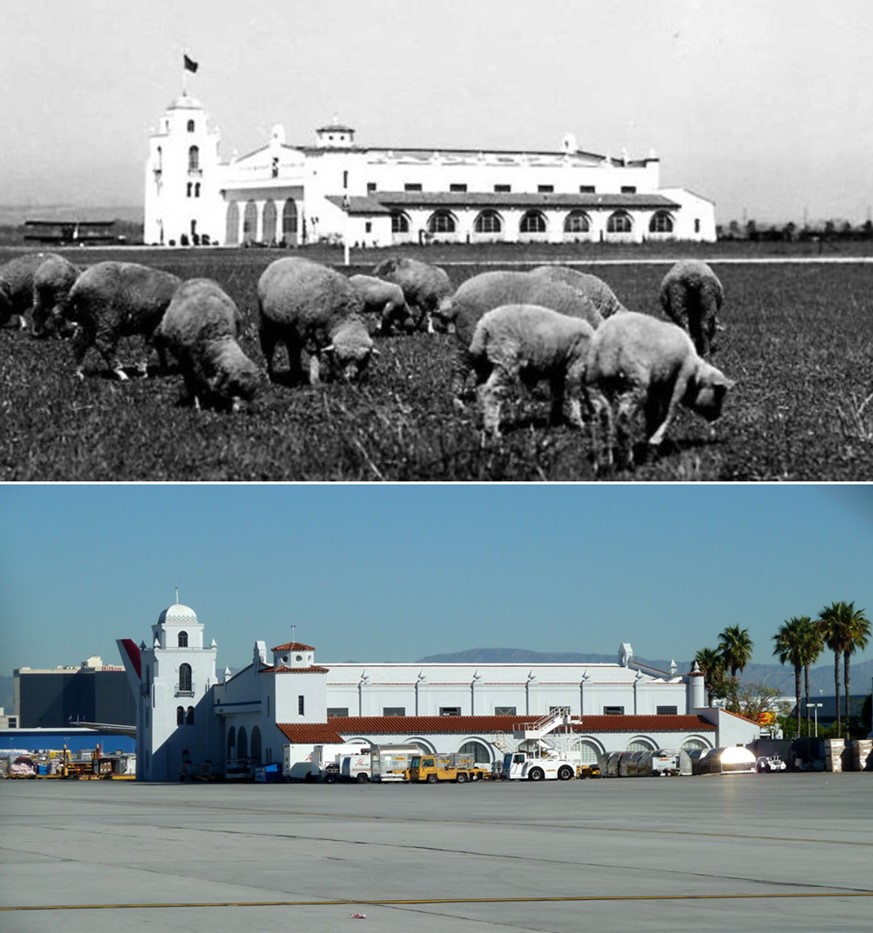 |
|
| (1930 vs. 2019)* - Hangar No. 1 at Mines Field and at LAX, showing the same building across nearly ninety years. Photo comparison by Jack Feldman. |
Historical Notes This comparison highlights how much the surrounding airport has changed while the hangar itself remains largely intact. Its towers, arched openings, and distinctive roofline still reflect the original 1929 design, even as modern cargo and airport infrastructure now surround it. Hangar No. 1 is significant not just for its age, but for what it represents. It marks the moment when Los Angeles committed to aviation as part of its future and invested in an airport long before air travel became common. |
* * * * * |
From Open Fields to City Airport
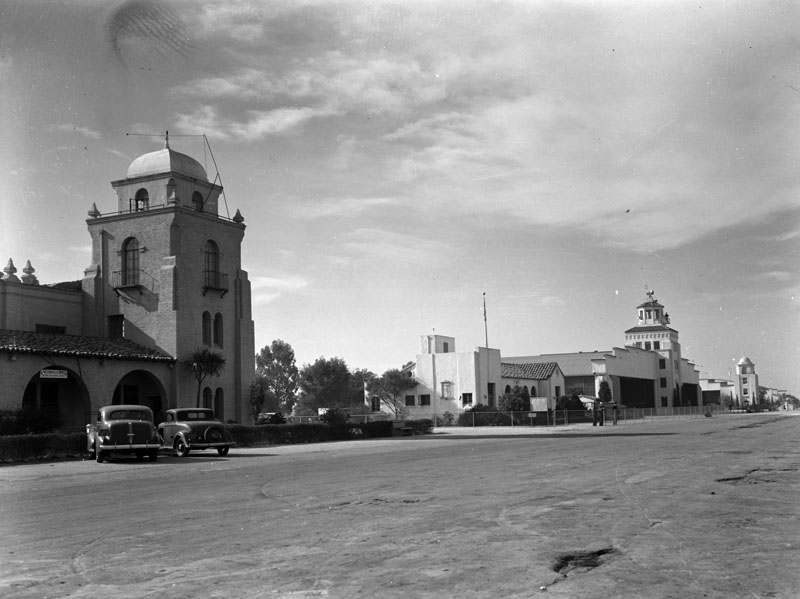 |
|
| (1937)* - View of Mines Field, the year the City of Los Angeles purchased the airport. |
Historical Notes In 1937, the City of Los Angeles purchased Mines Field outright, securing control over its future development. This decision allowed the city to plan long term improvements and expand the airport beyond its original modest role. A few years later, voters approved a major bond issue that funded new construction and upgrades. The airport was renamed Los Angeles Airport and began its transformation from a small municipal airfield into a facility capable of handling large scale commercial aviation. |
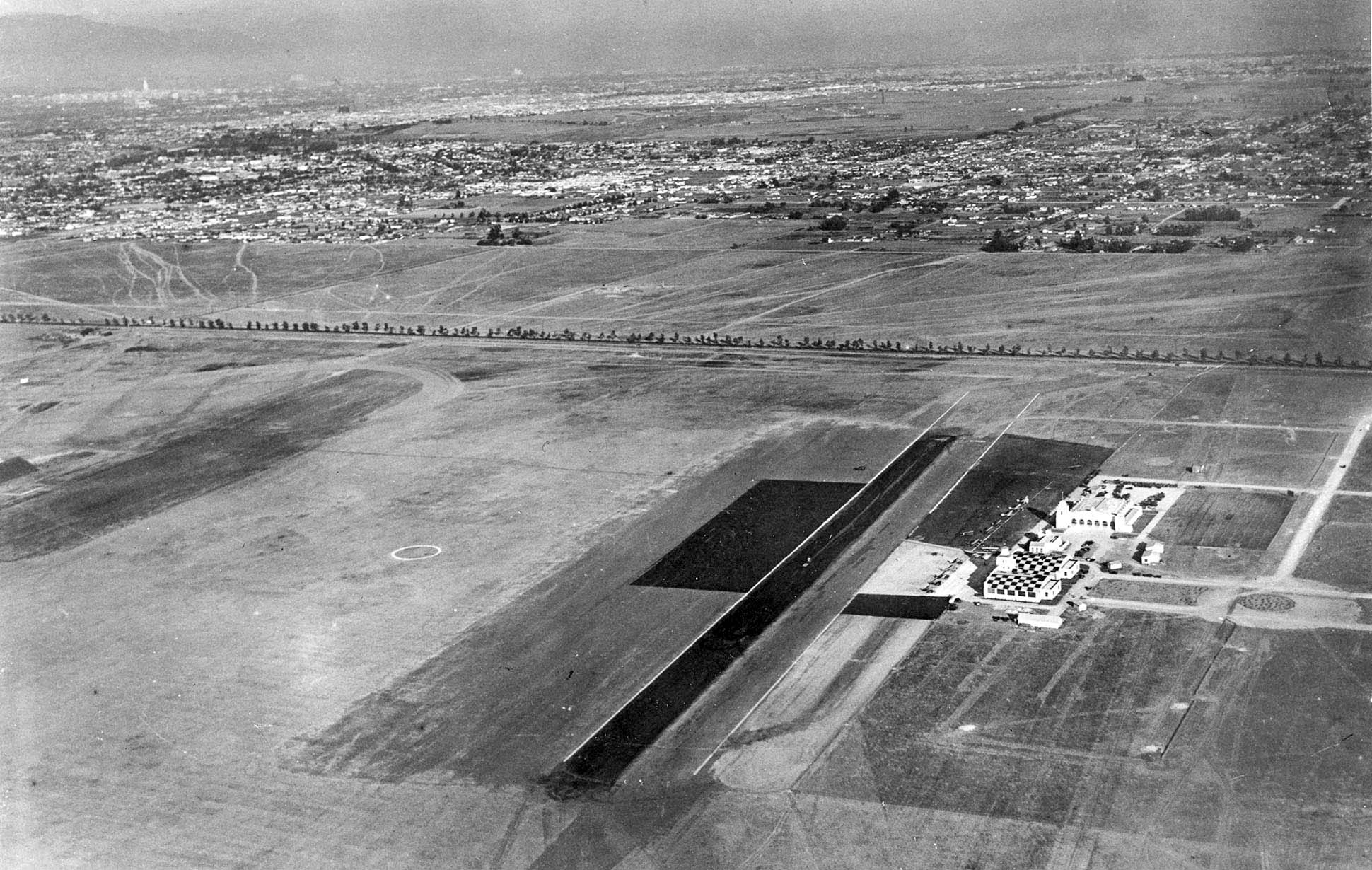 |
|
| (1929)*– Aerial view of Mines Field looking northeast, surrounded by open farmland. |
Historical Notes When Mines Field was selected in 1928, it was still part of Southern California’s ranching and farming landscape. Wheat, barley, and lima beans grew in the surrounding fields, and there was little nearby development. City leaders chose the site from dozens of possibilities, believing aviation would become essential to the region’s growth. This aerial view shows how small the airport was at the start. Within a short time, Hangar No. 1 and other basic improvements were added, setting in motion the steady expansion that eventually led to one of the world’s busiest airports. |
* * * * * |
Los Angeles Municapl Airport
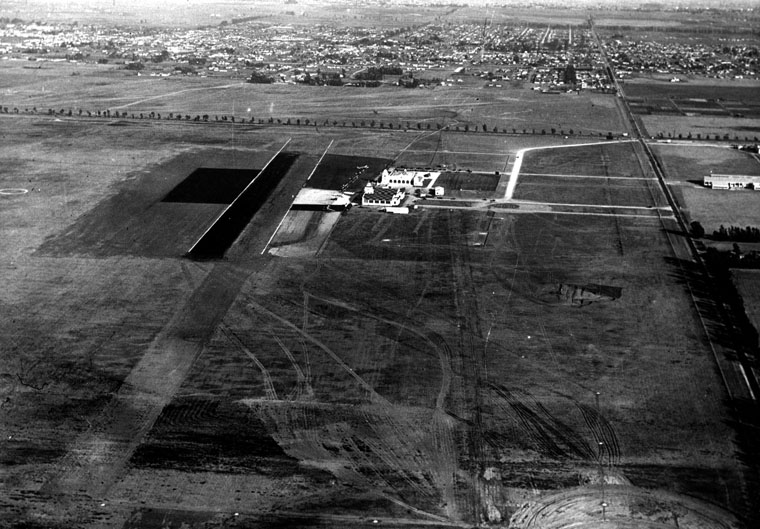 |
|
| (1930)* - Aerial view of Mines Field and surroundings; Mines Field later to become the Los Angeles International Airport. This photo was taken just before the airport was dedicated as the new official airport of Los Angeles and called LA Municipal Aiport but also known as Mines Field. |
Historical Notes In 1930 the airport was dedicated and renamed Los Angeles Municipal Airport. The dirt runway was replaced with an all-weather surface, and additional facilities like hangars, a restaurant, and a control tower were built. |
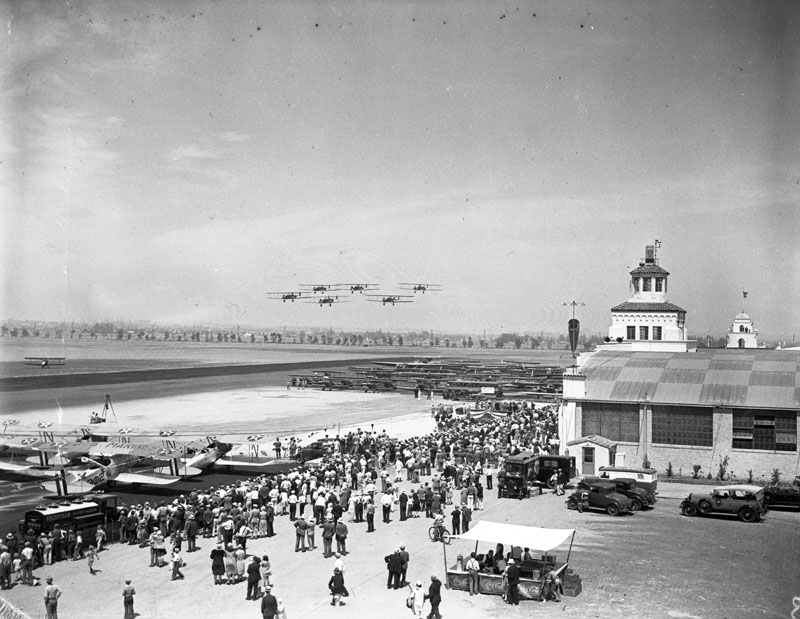 |
|
| (1930)* - Dedication of LA Municipal Airport (later L.A. International Airport) watched by large crowd and with lots of planes flying overhead. |
Historical Notes Mines Field was dedicated and opened as the official airport of Los Angeles in 1930, and the city purchased it to be a municipal airfield in 1937. The name was officially changed to Los Angeles Airport in 1941, and to Los Angeles International Airport in 1949. The main airline airports for Los Angeles had been Burbank Airport (then known as Union Air Terminal, and later Lockheed) and the Grand Central Airport in Glendale. By 1940 most airlines served Burbank only; in late 1946 most airline flights moved to LAX, but Burbank always retained a few. |
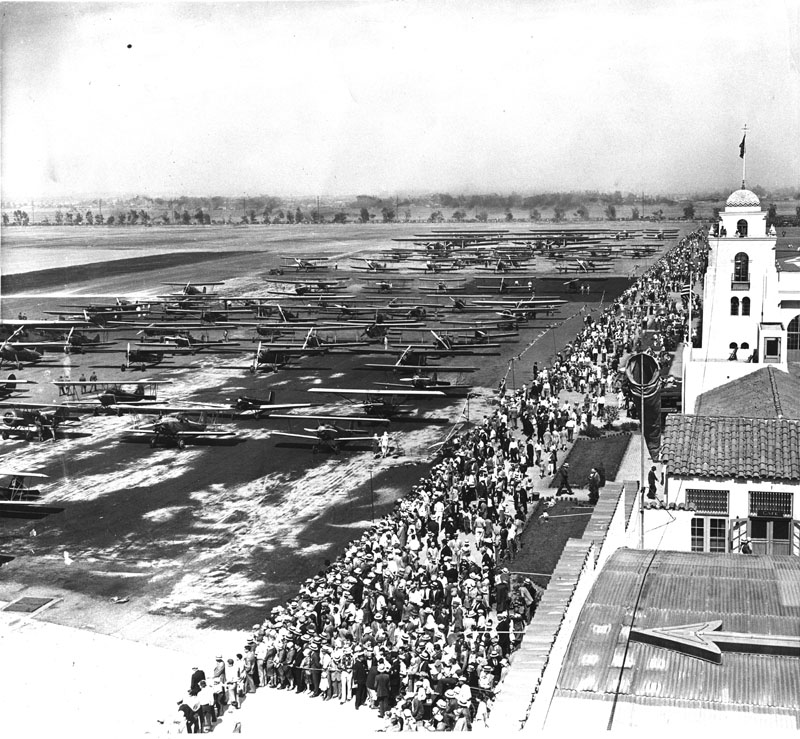 |
|
| (1930)* - Crowds of people attended the dedication of the airport on June 7, 1930. Many planes can be seen parked on the runway. |
Historical Notes The Los Angeles Municipal Airport (later renamed LAX) was officially dedicated in a two-day gala event on June 7-8, 1930. Here are the key details about its dedication: The airport was originally known as Mines Field, named after the real estate agent who helped secure the site for the city. In the lead up to the dedication, the city held a weeklong National Air Races event at Mines Field from September 8-16, 1928 which drew an estimated 65,000 spectators and demonstrated it was a suitable airport location. |
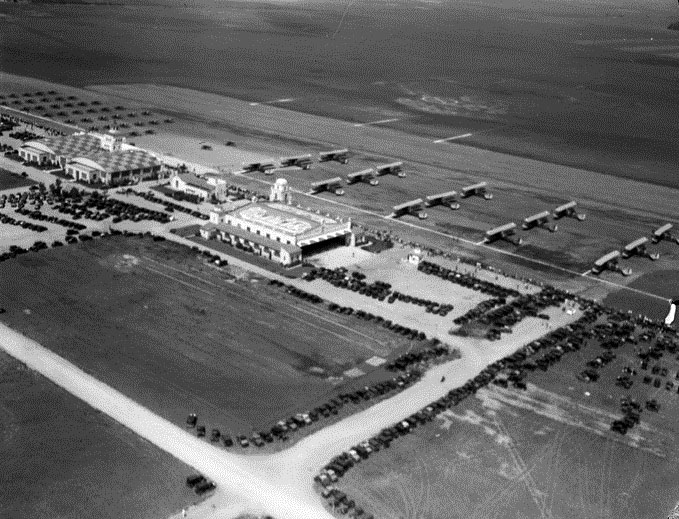 |
|
| (ca. 1931)** - Aerial view of Los Angeles Municipal Airport (now LAX) on Army Day. |
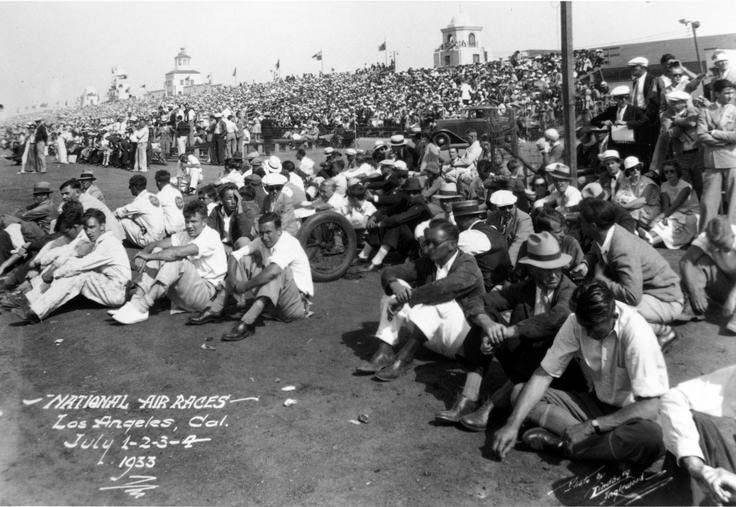 |
|
| (1933)* – View showing a huge crowd of spectators at Mines Field during the 1933 National Air Races. |
Historical Notes Several National Air Races were hosted at Mines Field. This 1933 race attracted even more spectators than the inaugural race in 1928, and really put Mines Field, aka LAX, on the map. |
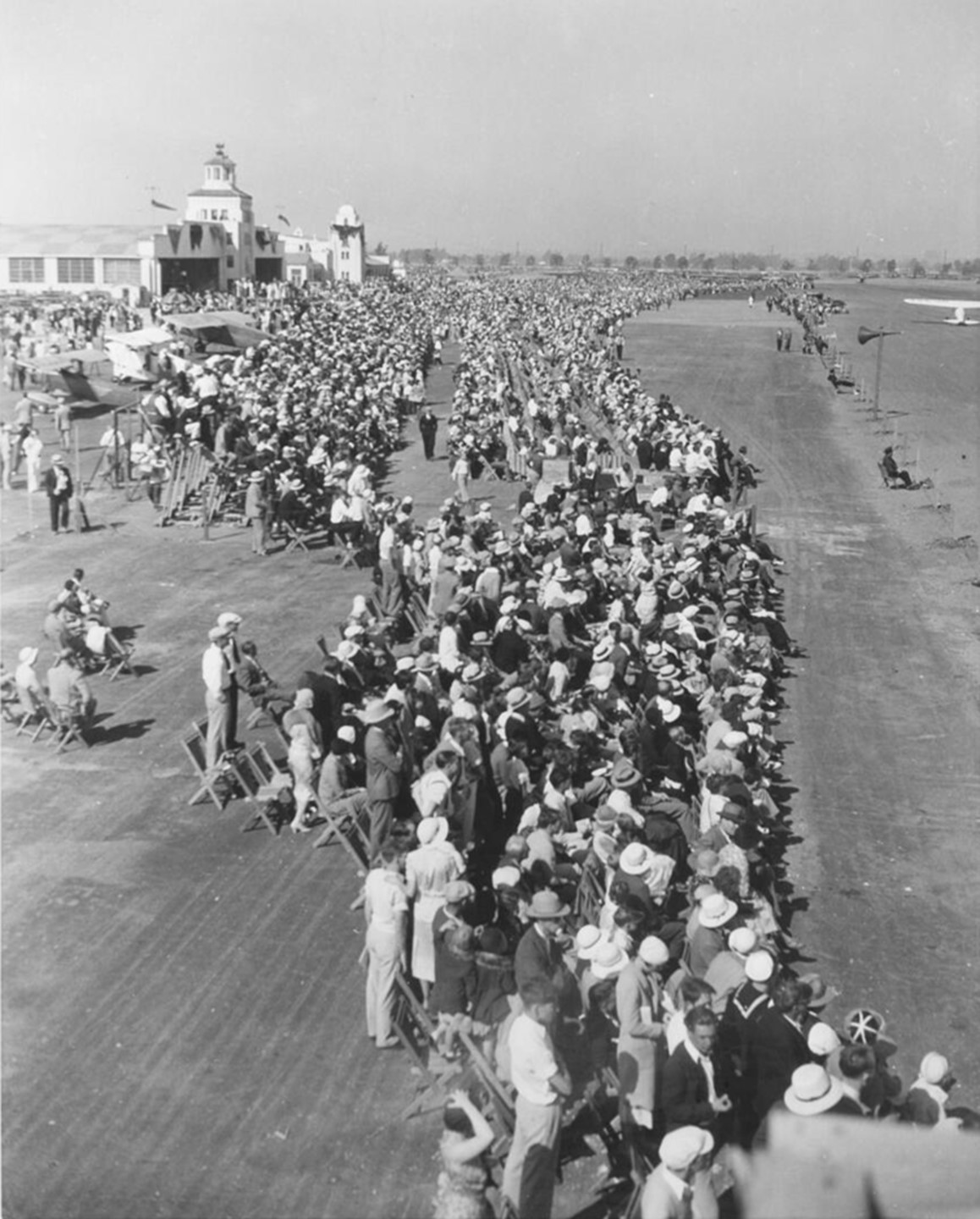 |
|
| (1930s)* - Crowd gathered for an air show at Mines Field. |
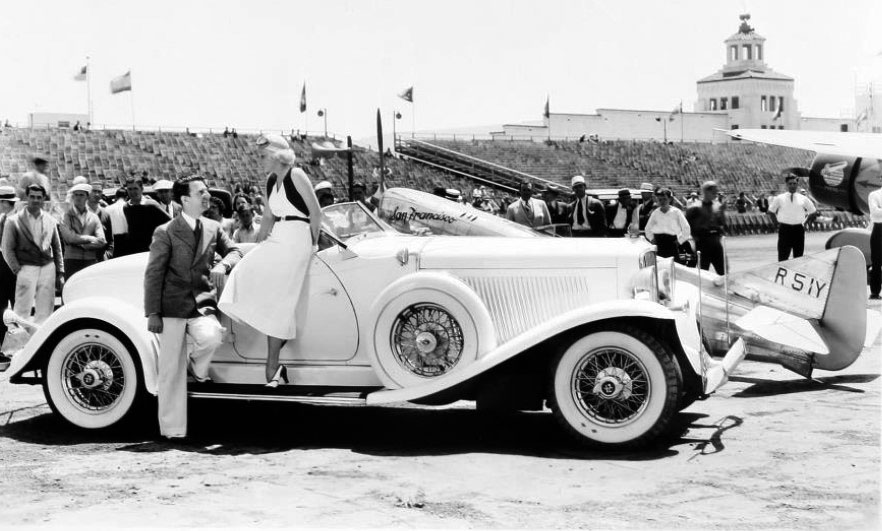 |
|
| (1933)* - Jean Harlow posed on a 1932 Auburn Boat-tailed Speedster along with race organizer Cliff Henderson. The photo was taken at the 1933 National Air Race held at Mines Field, now the site of LAX. |
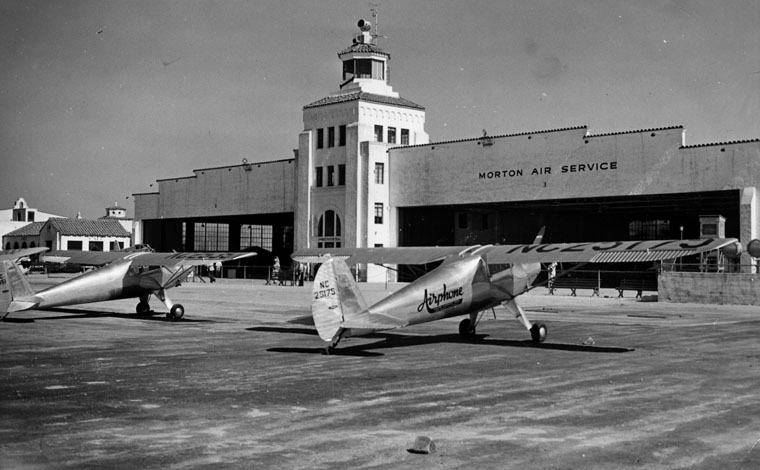 |
|
| (ca. 1930s)* - Two hangars, one with name Morton Air Service above it, at Mines Field. |
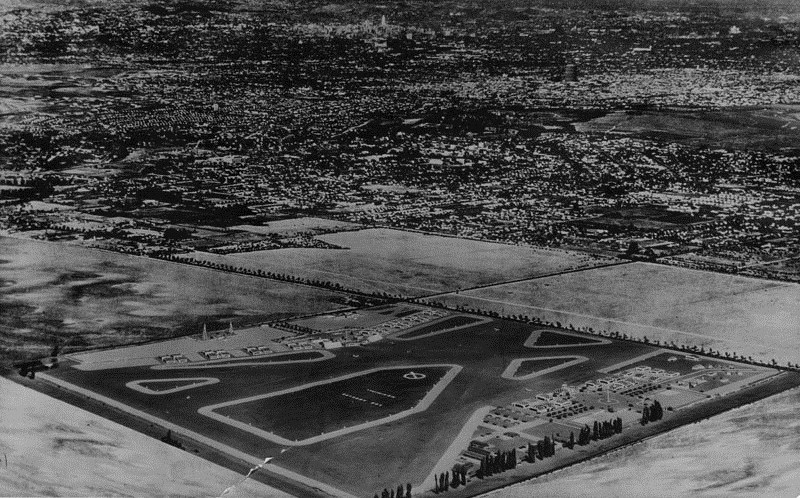 |
|
| (1939)* - Aerial view of Mines Field (Los Angeles Municpal Airport at time of photo). The field was sold to the City of Los Angeles by Wiliam W. Mines in 1937 upon which the name was changed to Los Angeles Municipal Airport |
Historical Notes Despite the city's support and investments, Mines Field, which featured a 2,000-foot runway and hangar space for 40 planes, would not become the region's principal aviation terminus until the 1940s. That distinction was held for nearly two decades by Burbank's Lockheed Field (today, Bob Hope Airport), through which most airlines routed their planes. Other important airports were located in Alhambra, Van Nuys (Metropolitan Airport), Glendale (Grand Central Air Terminal), and the present-day City of Commerce (Vail Field). |
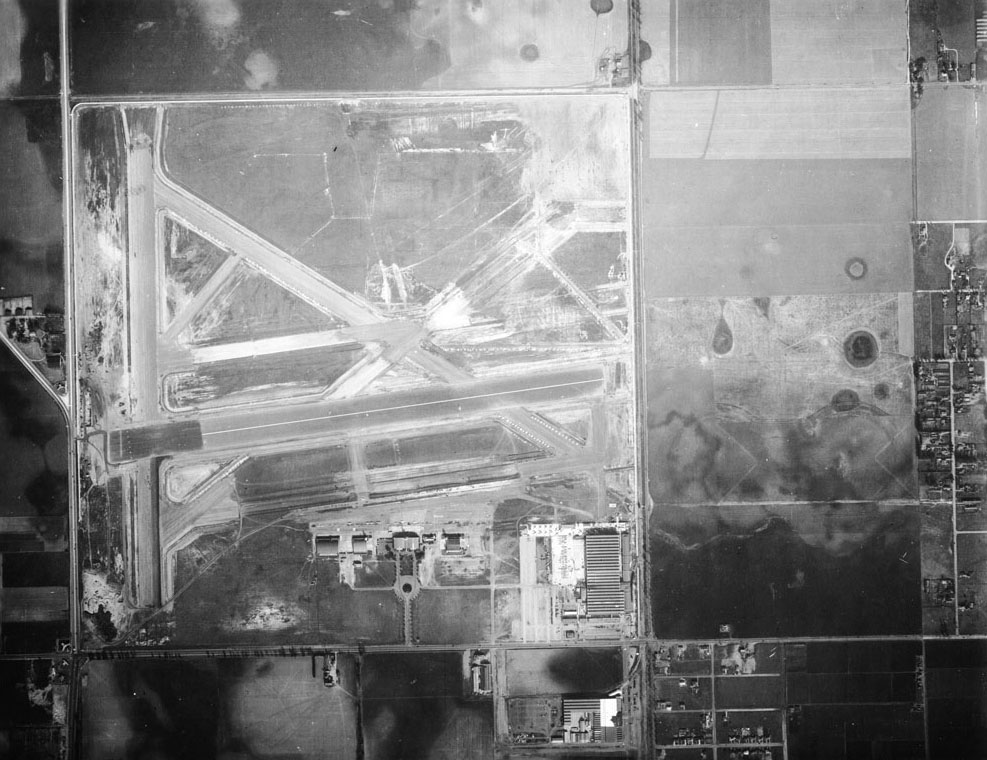 |
|
| (1939)^* - Aerial view of Los Angeles Municipal Airport after the City of Los Angeles purchased it outright. |
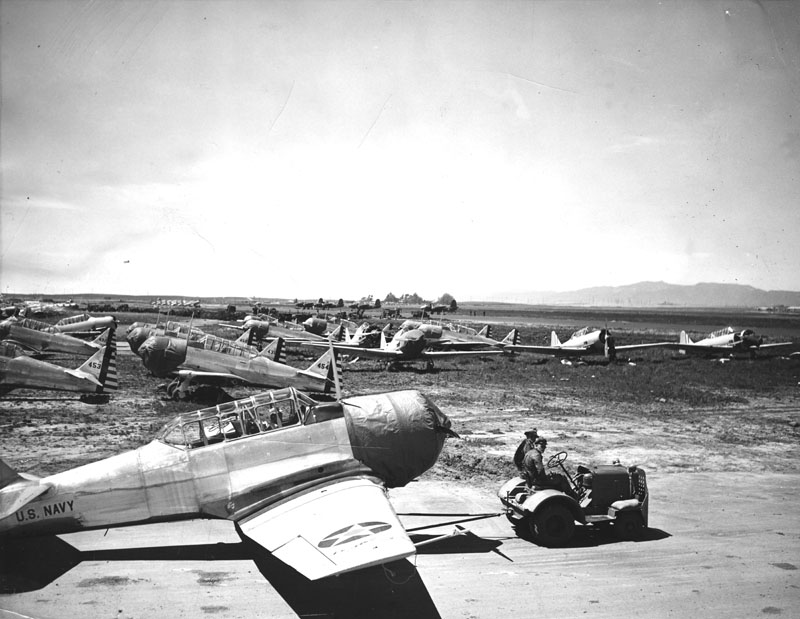 |
|
| (1941)* - This photo of the Municipal Airport, the first to be taken under special permission of the War Department illustrates the necessity of completing the airport project for national defense. The field is overcrowded with new planes. Most of these are United States Navy trainers ready for final tests. At extreme right are two trainers for the British awaiting delivery to Canada. An average of 30 test hops is made daily at the uncompleted airport. |
Historical Notes Los Angeles Municipal Airport (Mines Field), was used extensively during the war by the Army Air Forces, Navy and local aircraft manufacturers, and continued to function as a commercial airport. The Air Transport Command and Air Technical Service Command had operations here and there was also a large military air freight terminal. |
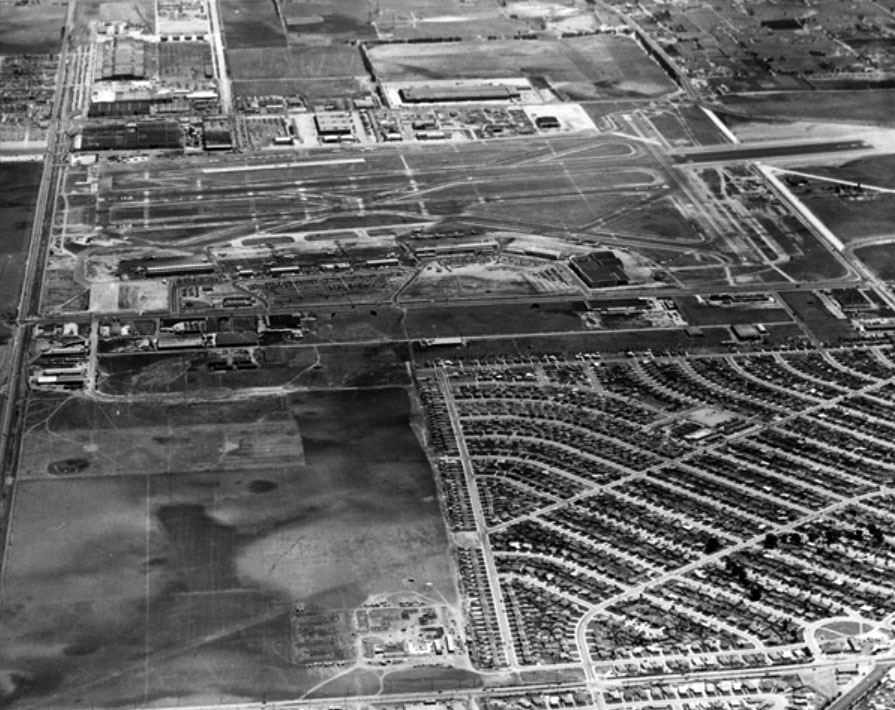 |
|
| (ca. 1946)^* - Aerial view of Los Angeles Municipal Airport shortly after its postwar renovations. |
 |
|
| (1946)*- Early morning panoramic view of scores of jackrabbits watching activities at Los Angeles Municipal Airport, slated to open to major airlines on December 9, 1946. Photo: LA Times Image Archive |
Historical Notes Commercial airline service started at Los Angeles Municipal Airport in December 1946 and on July 10, 1956 Boeing's 707 prototype (the 367-80) visited LAX. The Los Angeles Times said it was its first appearance at a "commercial airport" outside the Seattle area. |
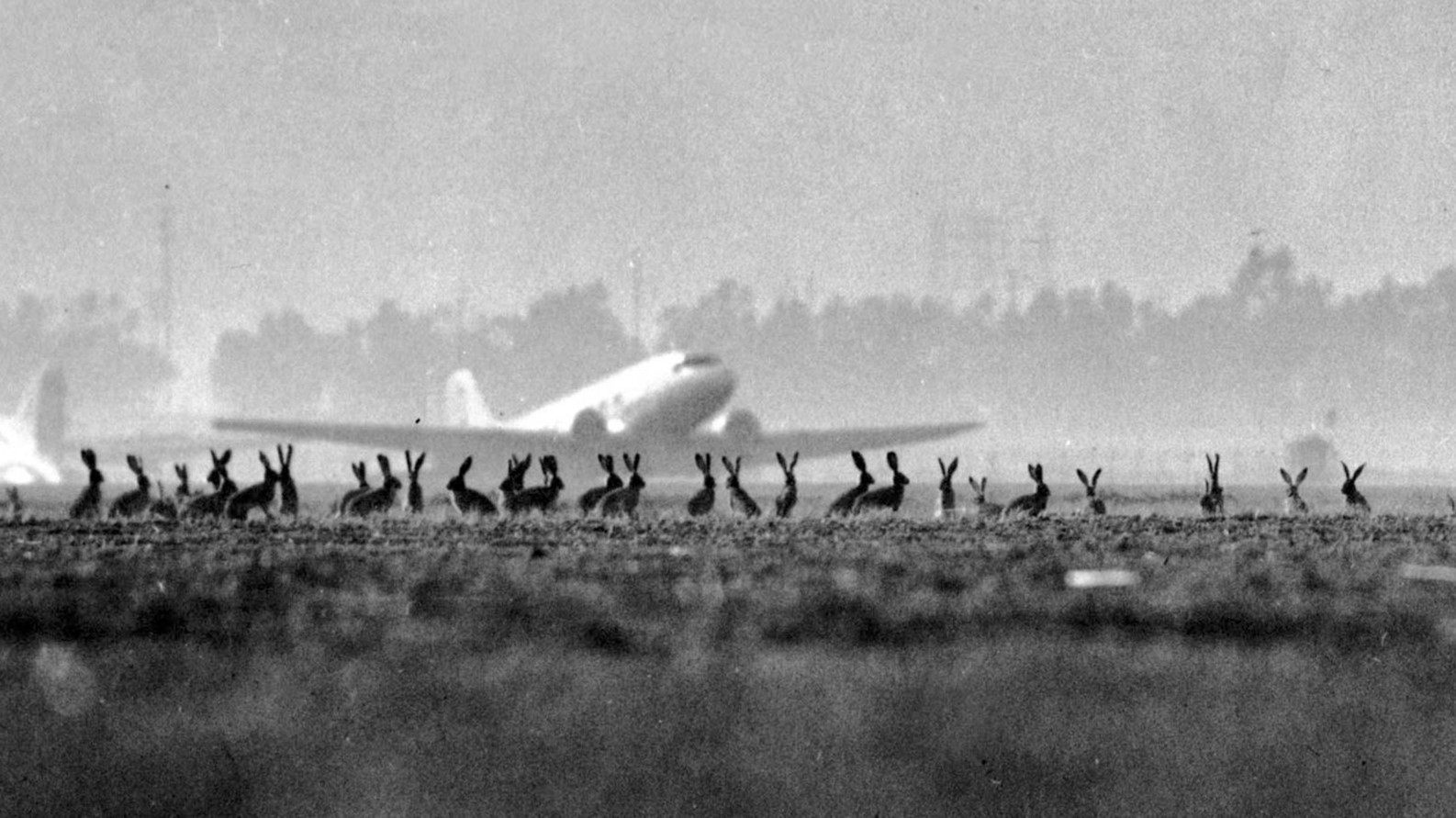 |
|
| (1946)*- Close-up view showing jackrabbits watching activities at Los Angeles Municipal Airport, slated to open to major airlines on December 9, 1946. Photo: LA Times Image Archive |
Historical Notes After the war, four temporary terminals were erected, and major airlines like American Airlines, TWA, United Airlines, and Western Airlines began passenger operations. The airport was renamed Los Angeles International Airport in 1949. |
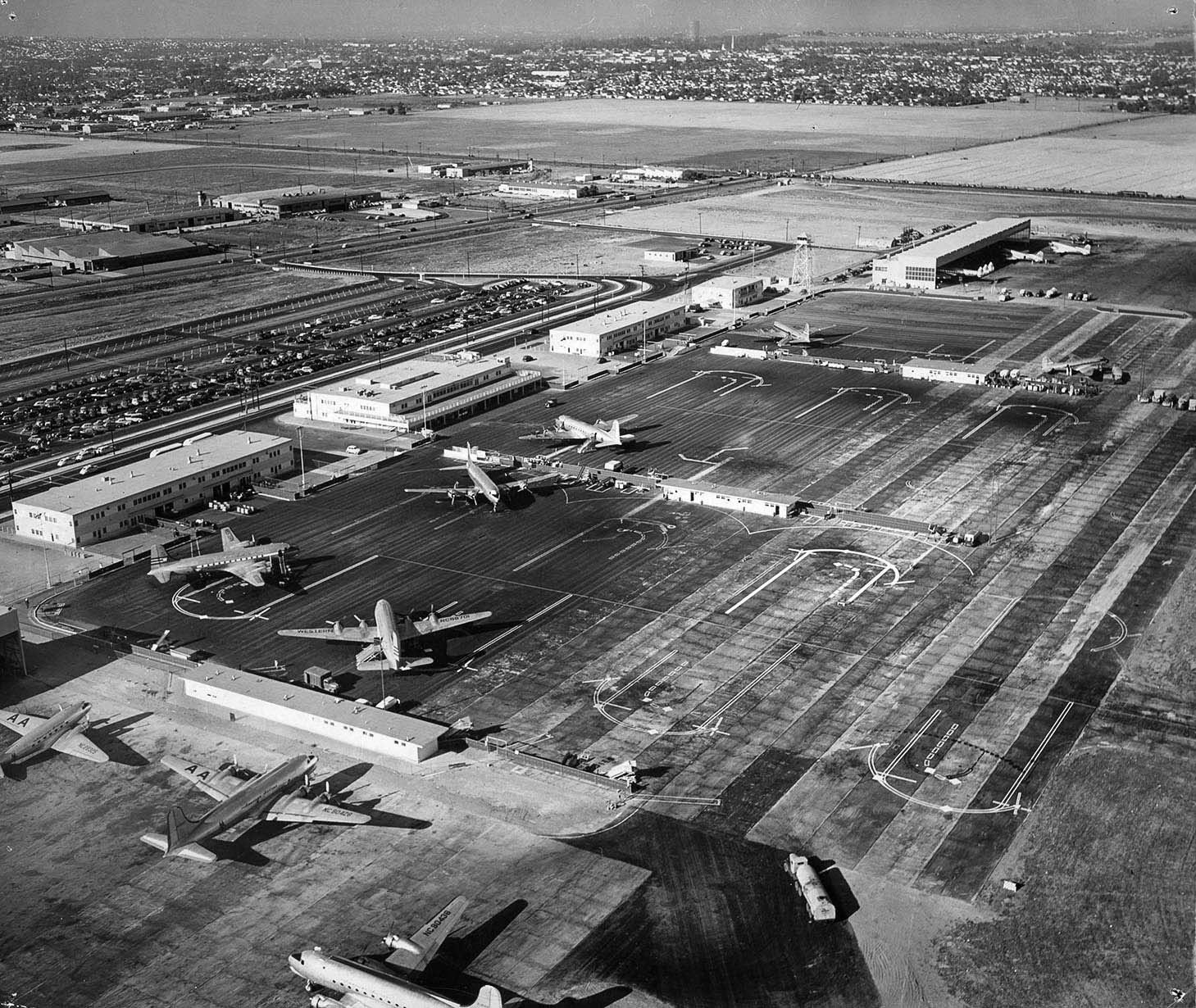 |
|
| (1947)* - Aerial view of Los Angeles Municipal Airport less than one year after commercial airline service began. |
Historical Notes Photo caption, dated Oct. 10, 1947, reads: The main passenger concourse is served by three modern terminal buildings. Six major airlines are operating at the airport, with passenger volume exceeding 100,000 a month. |
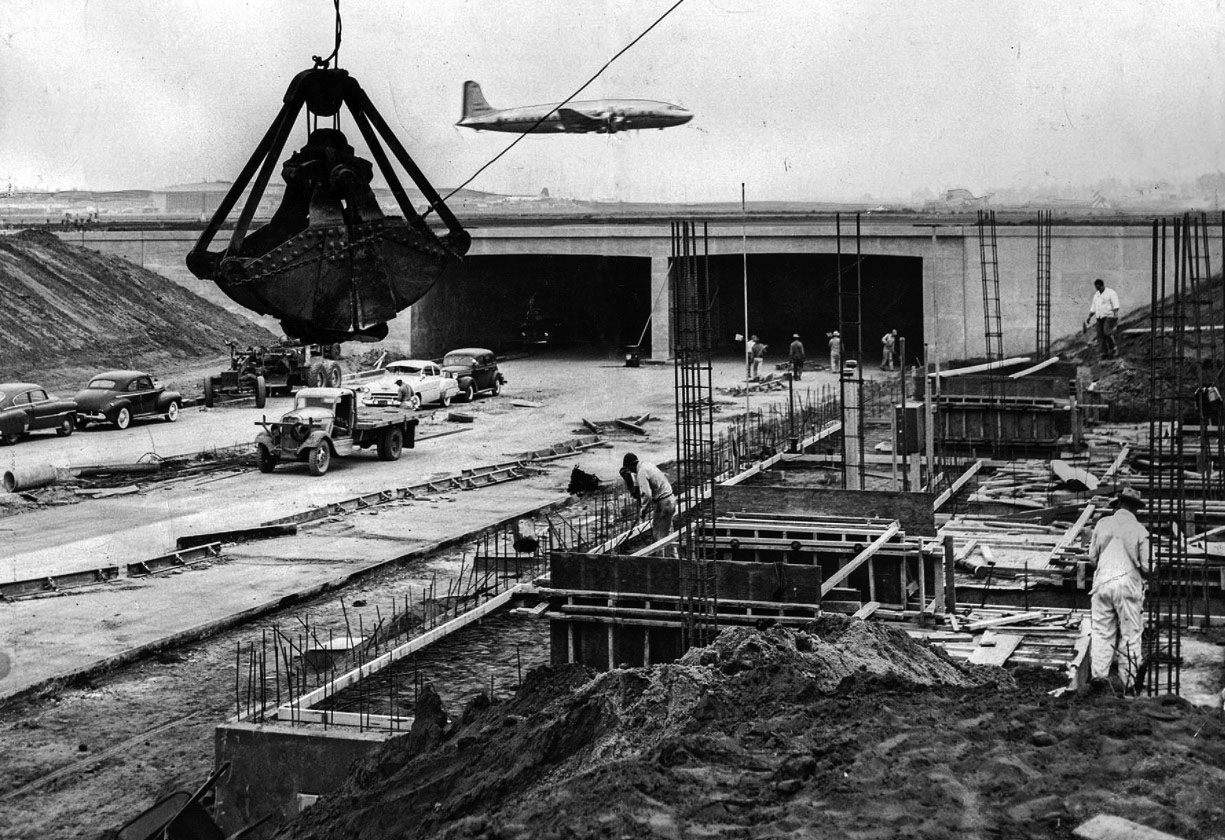 |
|
| (1952)* - Construction of the north portal of the Sepulveda Boulevard tunnel underneath Los Angeles International Airport. |
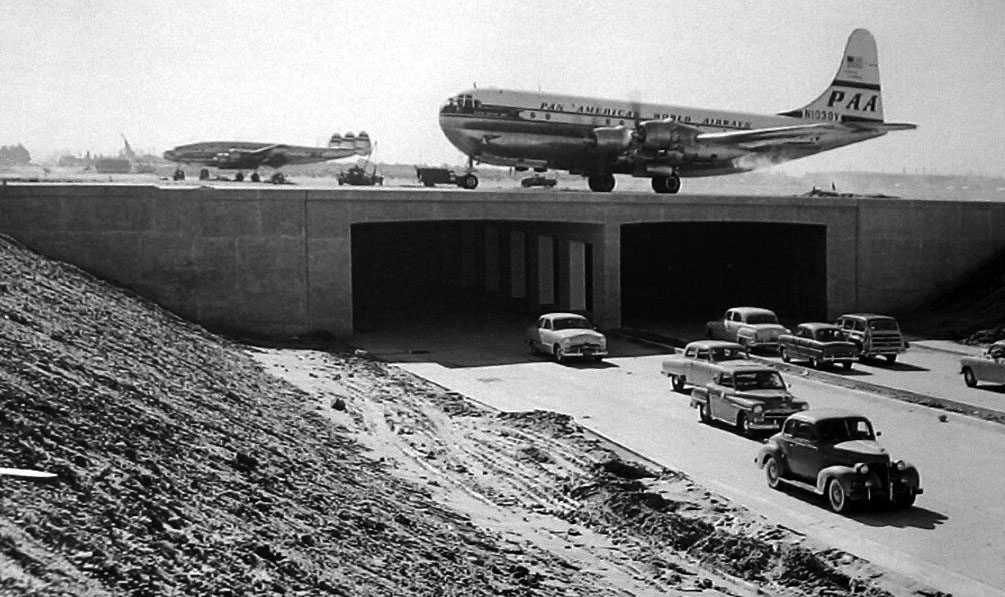 |
|
| (1953)* - A Pan American Airlines Stratocruiser maneuvering over the newly constructed Sepulveda Tunnel at LAX in 1953. To its left is the Lockheed Constellation, preferred by TWA at the time. |
Historical Notes Mines Field did not extend west of Sepulveda Boulevard. Sepulveda was rerouted circa 1950 to loop around the west ends of the extended east–west runways (now runways 25L and 25R), which by November 1950 were 6,000 feet long. A tunnel was completed in 1953 allowing Sepulveda Boulevard to revert to straight and pass beneath the two runways; it was the first tunnel of its kind. For the next few years the two runways were 8,500 feet long. |
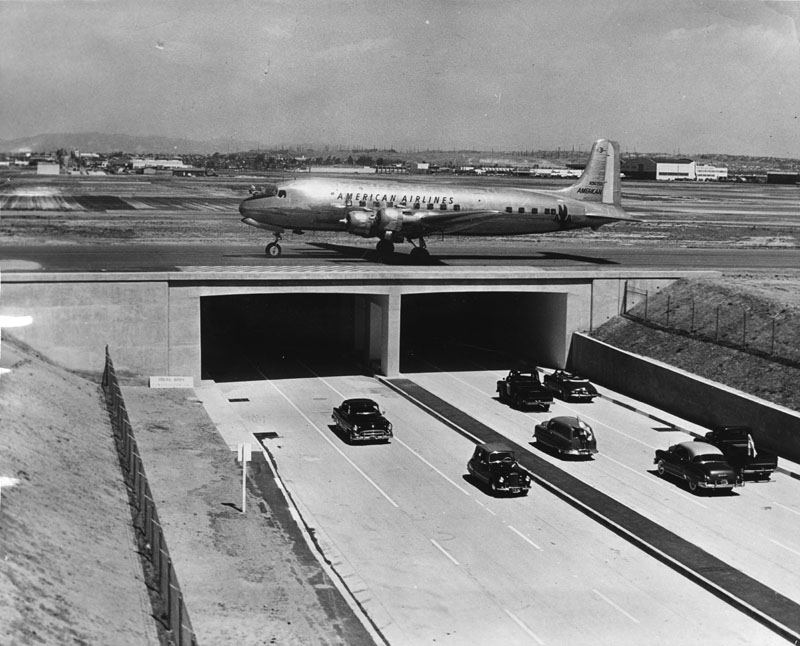 |
|
| (1953)* - Cars and trucks go through Sepulveda Airport Underpass in a final testing prior to the opening of the $3,500,000 tunnel. |
Historical Notes At the time of its completion in March 1953, the six-lane, 1909-foot-long divided tunnel was the only traffic tunnel under a large airport runway in the United States. The tunnel’s grand opening was held on April 21, 1953. L.A. Mayor Fletcher Bowron cut the ribbon (presumably with one of those giant pairs of scissors), and the LAPD band provided entertainment during the ceremony. After the first 100 cars traveled through the tunnel, their drivers received mementoes of the aviation industry from stewardesses (flight attendants) who were stationed at the intersections of Sepulveda with Imperial Highway and Century Boulevard. |
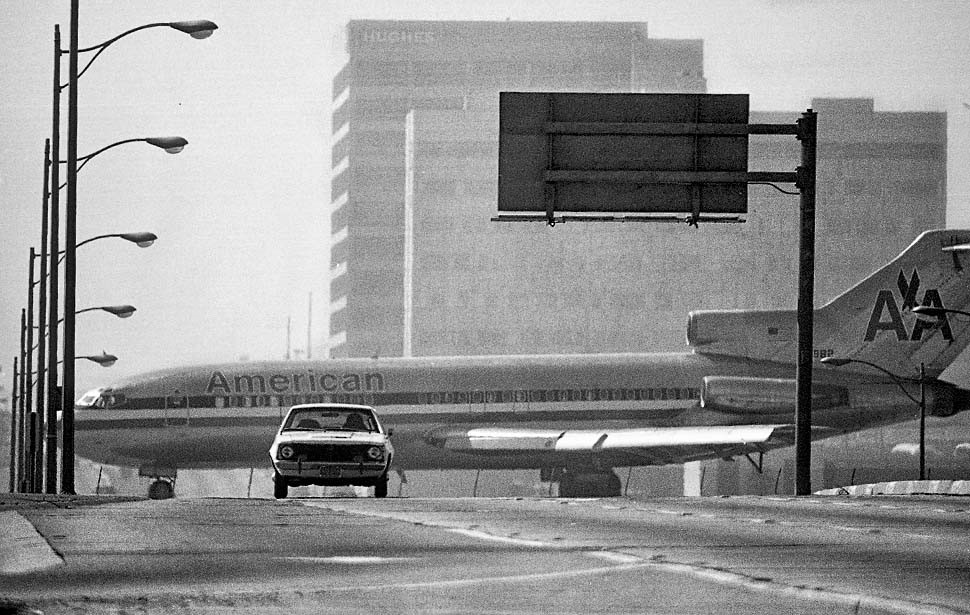 |
|
| (1976)* - View looking north on Sepulveda using a long telephoto lens showing an American Airlines jet crossing over the Sepulveda Tunnel - making for a good optical illusion. Photo by Rick Meyer |
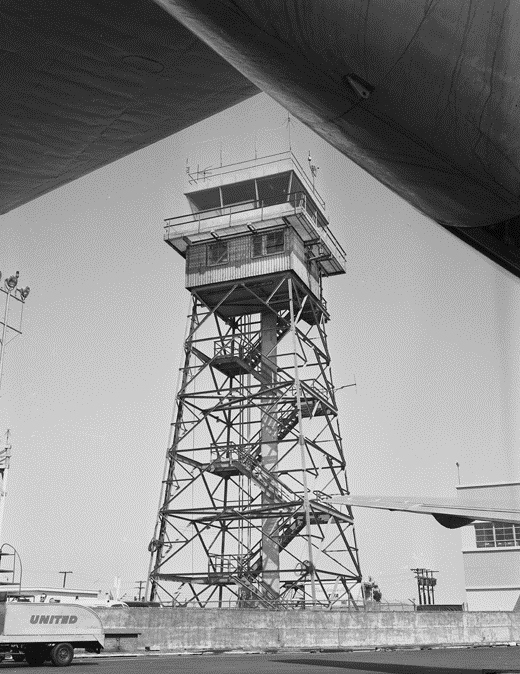 |
|
| (1956)* - View of the control tower at Los Angeles International Airport. |
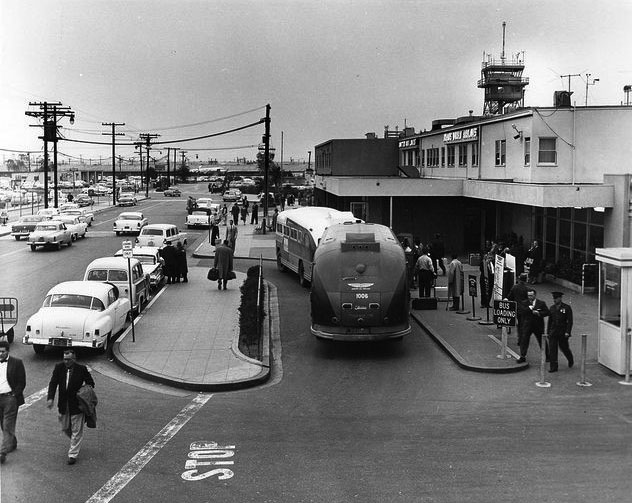 |
|
| (1950s)* - View showing the bus loading lane in front of the terminal at LAX with control tower in the background. |
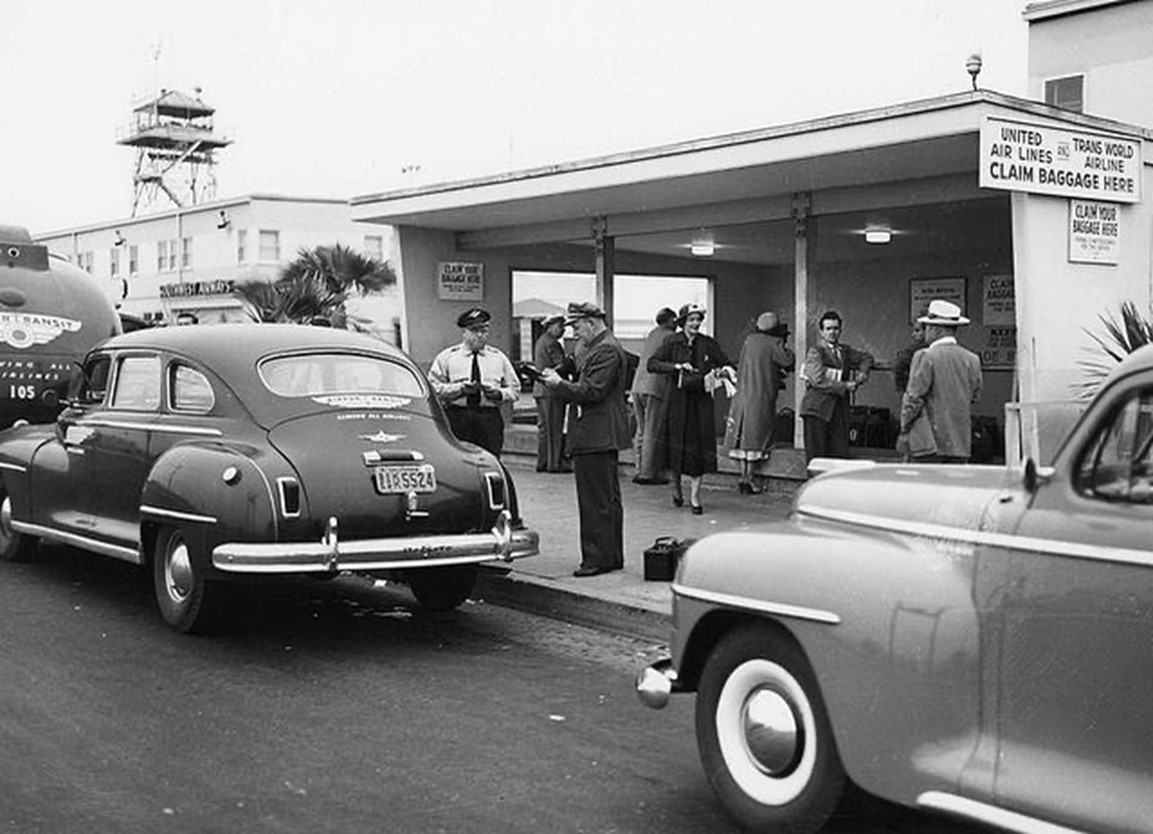 |
|
| (1950s)* – Baggage claim area for United Air Lines and Trans World Airlines at LAX with control tower seen in the backgrund. |
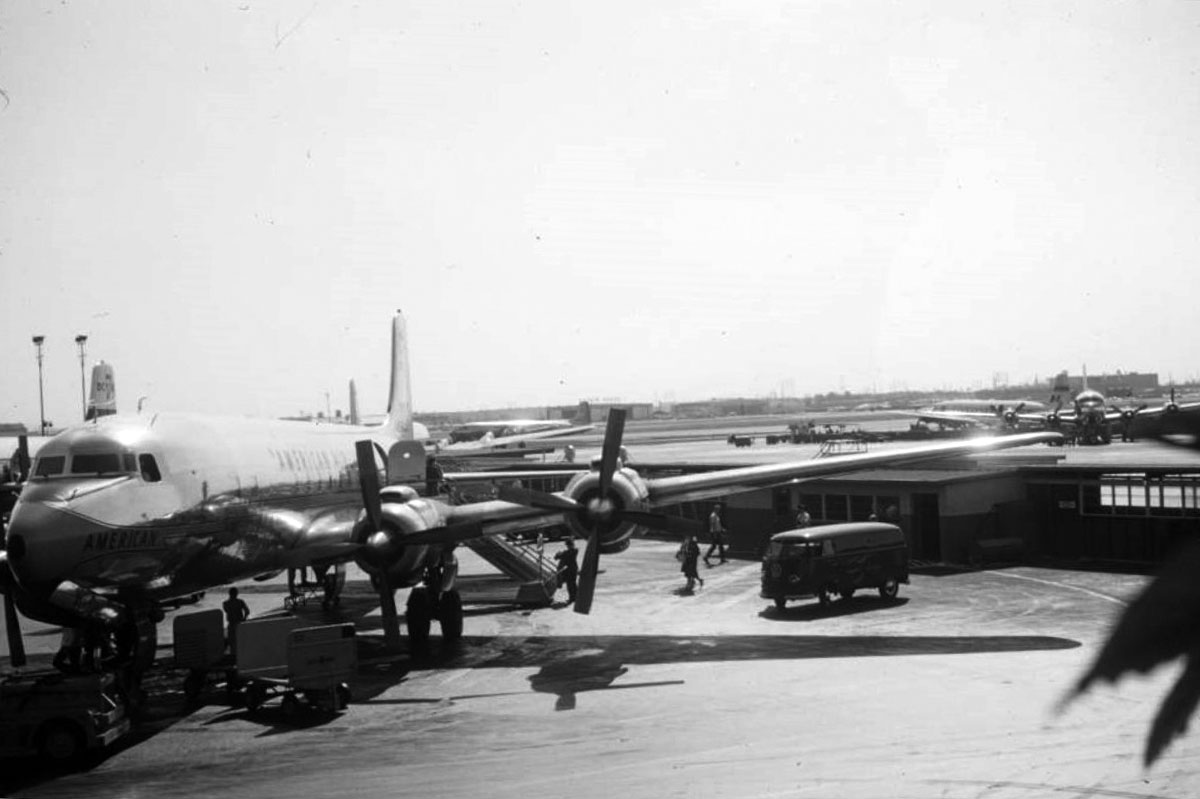 |
|
| (1957)* - View showing passengers boarding an American Airlines DC-7 aircraft at Los Angeles Airport. This is the Flagship Wisconsin, fleet number 323 on the nose landing gear door. A Volkwagen panel van is to the right. |
Historical Notes The Douglas DC-7 was built by the Douglas Aircraft Company from 1953 to 1958. It was the last major piston-engine powered transport made by Douglas, coming just a few years before the advent of jet aircraft such as the Boeing 707 and Douglas DC-8. |
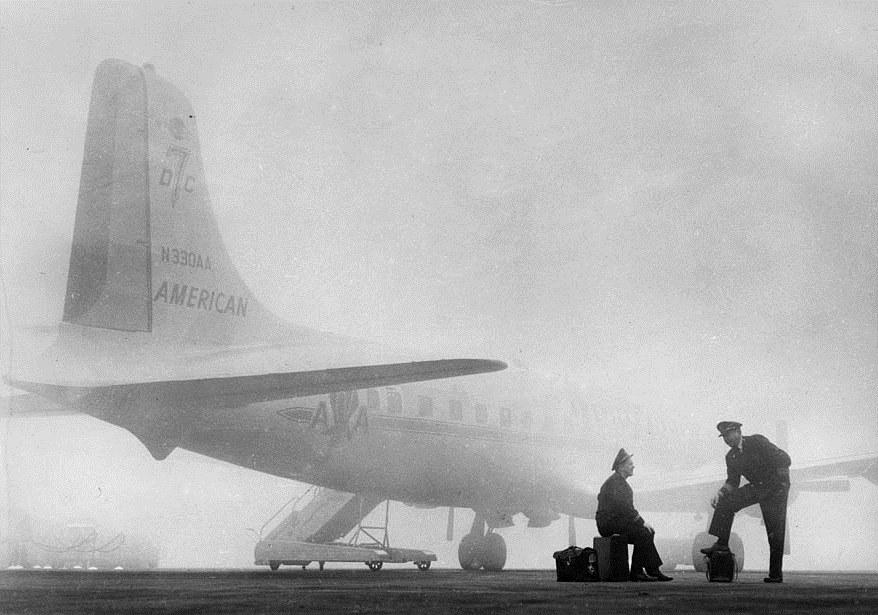 |
|
| (1958)* - LAX fogged in. American Airlines flight engineer Frank Nusser, left, and Capt. Don Young wait by their aircraft for fog to lift at Los Angeles International Airport. Photo by John Malmin; LA Times Image Archives |
Historical Notes In 1958 the architecture firm Pereira & Luckman was contracted to design a master plan for the complete re-design of the airport in anticipation of the "jet age." The plan, developed along with architects Welton Becket and Paul Williams, called for a massive series of terminals and parking structures to be built in the central portion of the property, with these buildings connected at the center by a huge steel-and-glass dome. The plan was never realized, and shortly thereafter the Theme Building was constructed on the site originally intended for the dome.*^ |
The New 'Jet Age' LAX
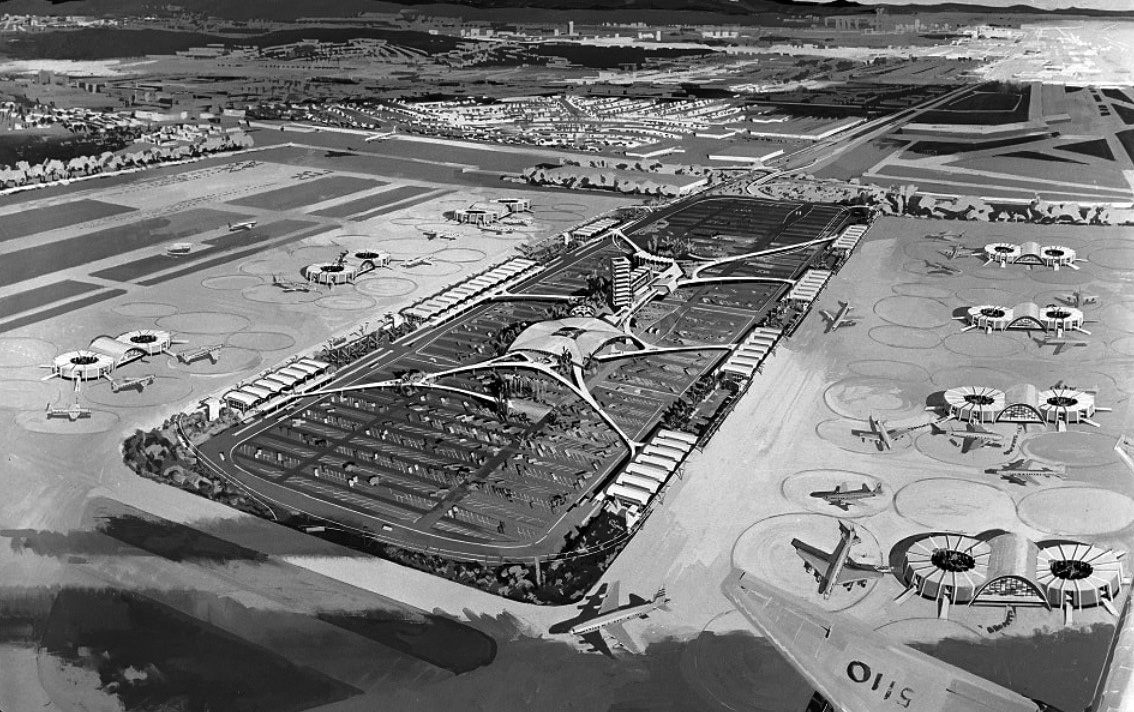 |
|
| (1958)* – Artist’s impression showing the future terminal area of LAX. Credit: LAX Photo Archives |
Historical Notes Designed by a joint venture of Pereira & Luckman, Welton Becket and Associates, and Paul R. Williams, the plan called for a series of terminals organized around a central parking area. Each terminal had a satellite building out in the middle of the ramp, reached by underground tunnels from the ticketing area. The original scheme depicted above featured a system of trains connecting the terminals, which was later scrapped. The complex was designed to handle 23 million passengers by 1970. The total development cost at the time was $70 million. |
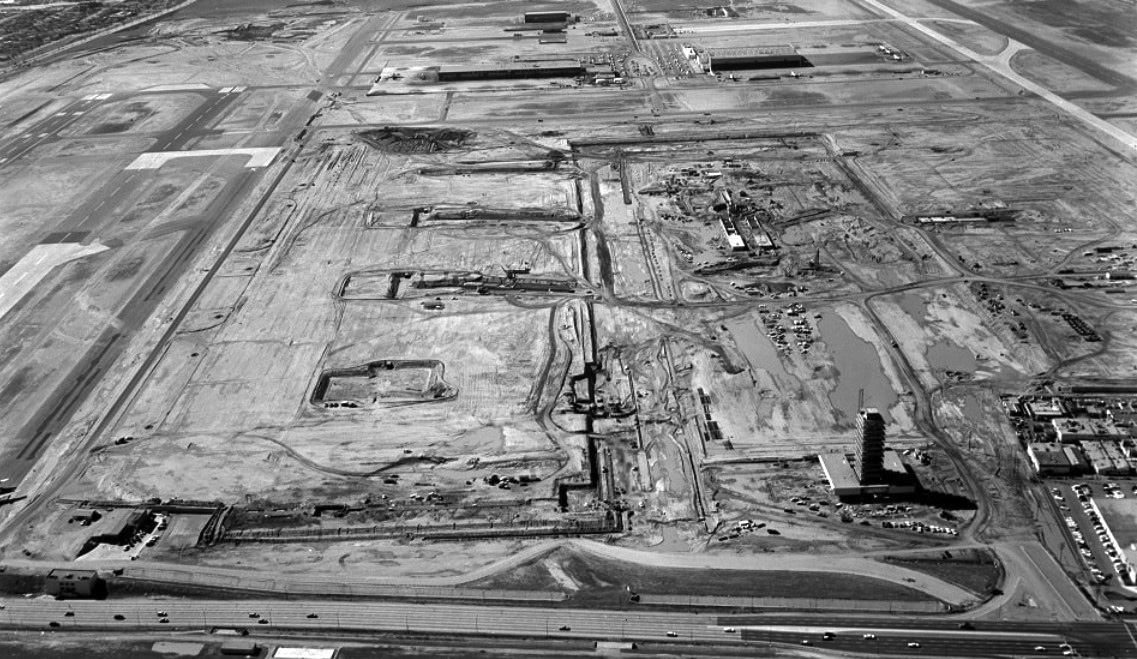 |
|
| (1960)^ – Aerial view looking west showing groundwork for the new passenger terminal area. The Control Tower (foreground) has already been completed. Sepulveda Boulevard runs horizontally at bottom of photo. Credit LAX Photo Archives via The Airport History.org Collection |
Historical Notes The trenches in the center of the image will eventually contain the tunnels that connect the ticketing buildings to the satellites. |
.jpg) |
|
| (1960)* - Control Tower (1) rises to its height of 172 feet as foundation of ticketing building (2) takes shape. Site preparation is 90 per cent complete two months ahead of schedule. Herald Examiner progress picture at L.A.'s air terminal site. |
Historical Notes The original plan called for a series of terminals and parking structures in the central portion of the property, with these buildings connected at the center by a huge steel-and-glass dome. The dome was never built, and the Theme Building was built on the site intended for the dome.^ |
.jpg) |
|
| (1960)^ - Aerial view looking east showing the construction of satellites #4, #5 and #7. Construction of the legendary Space Age Theme Building in the upper left is also progressing well. Photo Date: November, 1960. Credit LAX Photo Archives via The Airport History.org Collection |
Historical Notes In the new terminal area west of Sepulveda Blvd that started opening in 1961, each terminal had a satellite building out in the middle of the ramp, reached by underground tunnels from the ticketing area. United's satellites 7 and 8 were first to open, followed by TWA's terminal 3, American's terminal 4 and Western's terminal 5. Satellite 2 opened as the international terminal several months later, and satellite 6, a "consolidated" terminal for other domestic carriers, was to be the last to open. By 1964 the airport had international service by Aeronaves, Air France, JAL, TWA, UTA, Varig and Western in addition to Mexicana, Pan Am and SAS.^ |
Theme Building
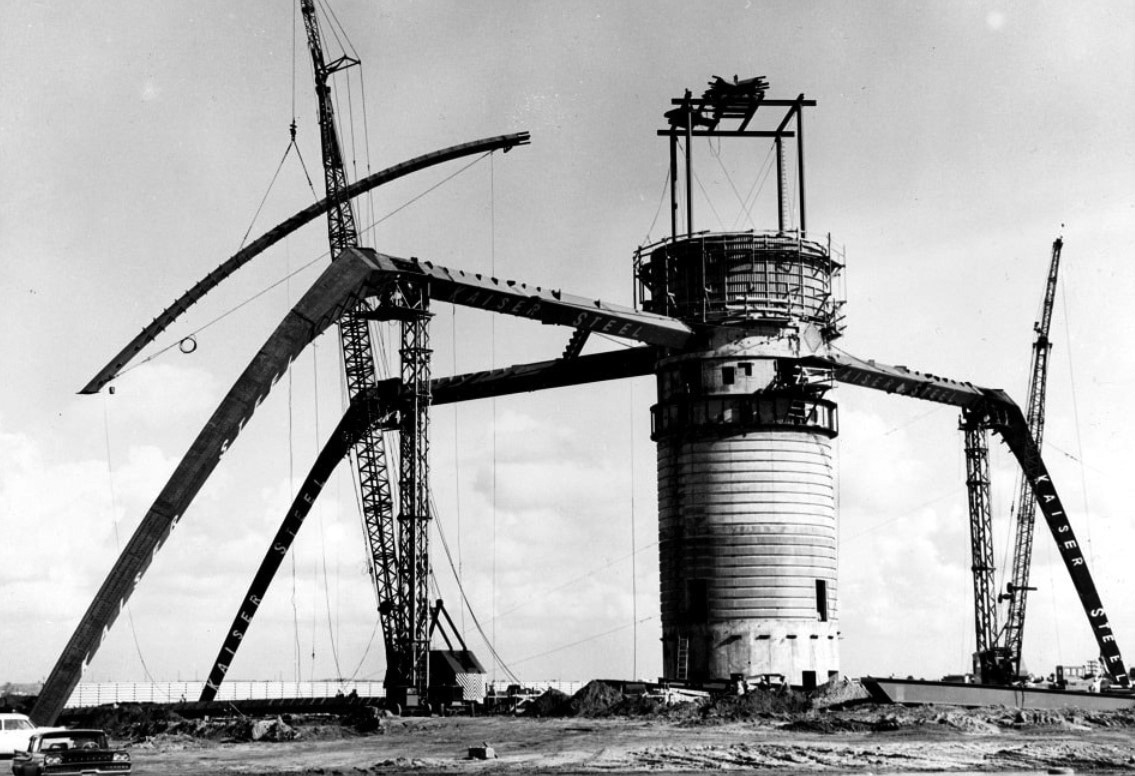 |
|
| (1960)^ - View showing the Theme Building under construction. Credit LAX Photo Archives via The Airport History.org Collection |
Historical Notes The modern parobolic arches of the Theme Building would dominate the center of the terminal area, with four “legs” rising 135 feet from the ground and 340 feet across the base. It would contain a restaurant and observation deck, with an employee cafeteria at ground level. |
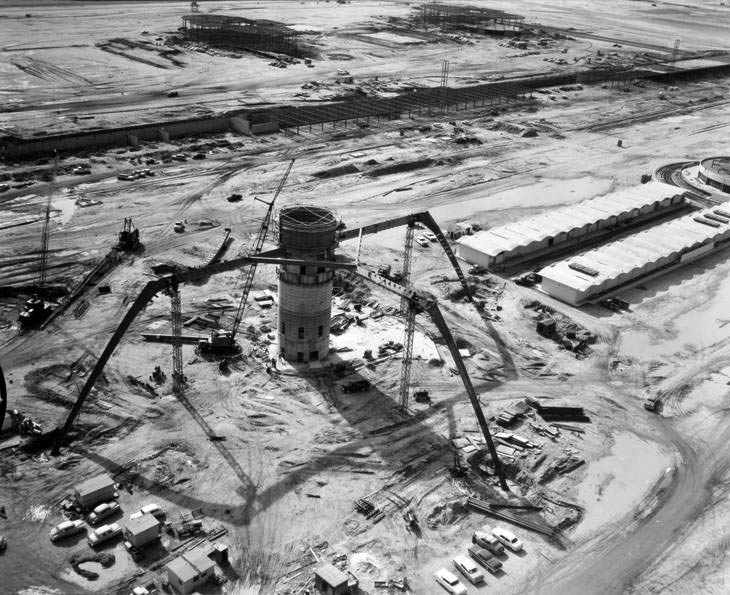 |
|
| (1960)*** – Aerial view showing LAX under construction with the Theme Building in the foreground and two terminal buildings in the distance. |
Historical Notes The distinctive white googie "Theme Building", designed by Pereira & Luckman architect Paul Williams and constructed in 1960/1961 by Robert E. McKee Construction Co., resembles a flying saucer that has landed on its four legs. |
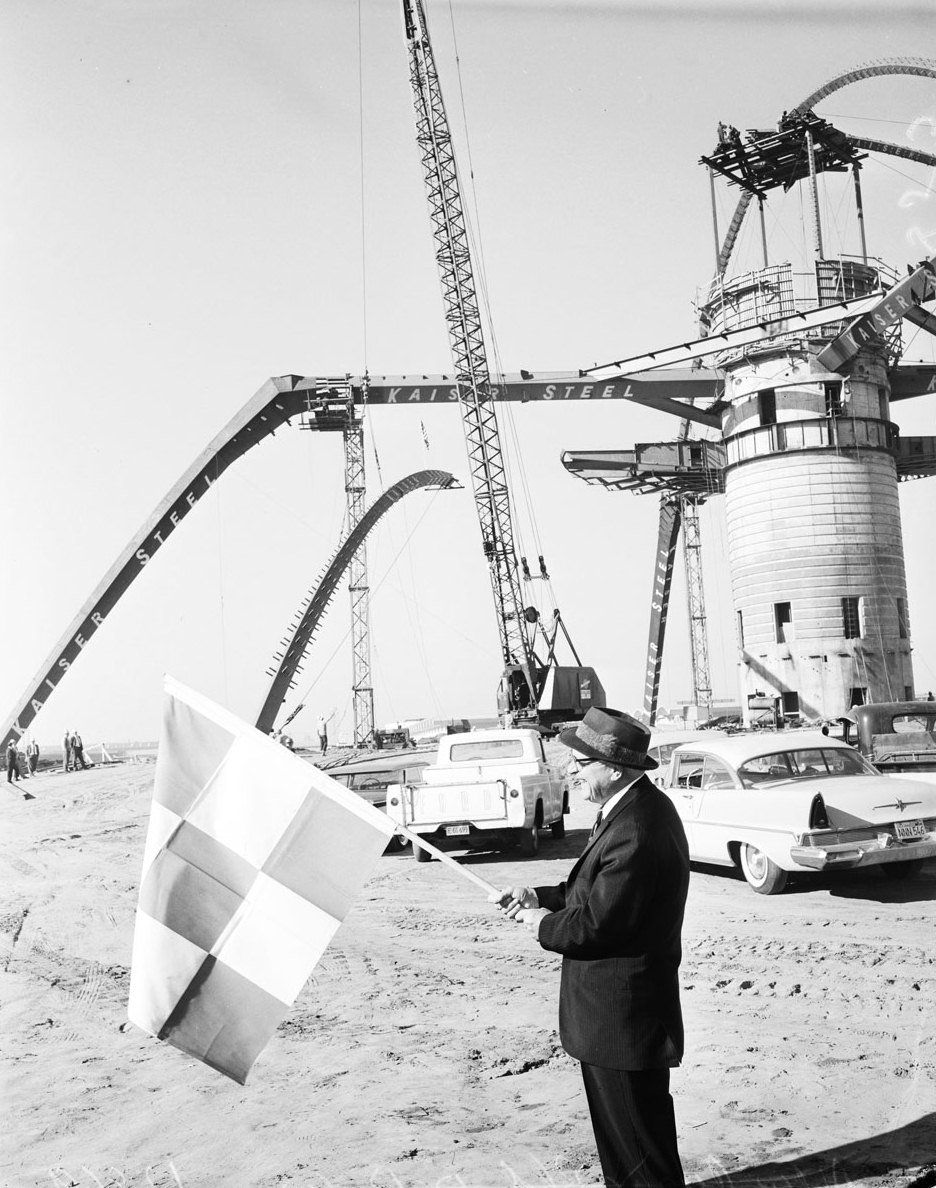 |
|
| (1960)* - Close-up view showing the Theme Building under construction in 1960. Airport Commission president Don Belding waves a flag in the foreground. |
Historical Notes The Theme Building became an iconic landmark structure at the LAX. It opened in 1961, and is an example of the Mid-Century modern influenced design school known as "Googie" or "Populuxe”. |
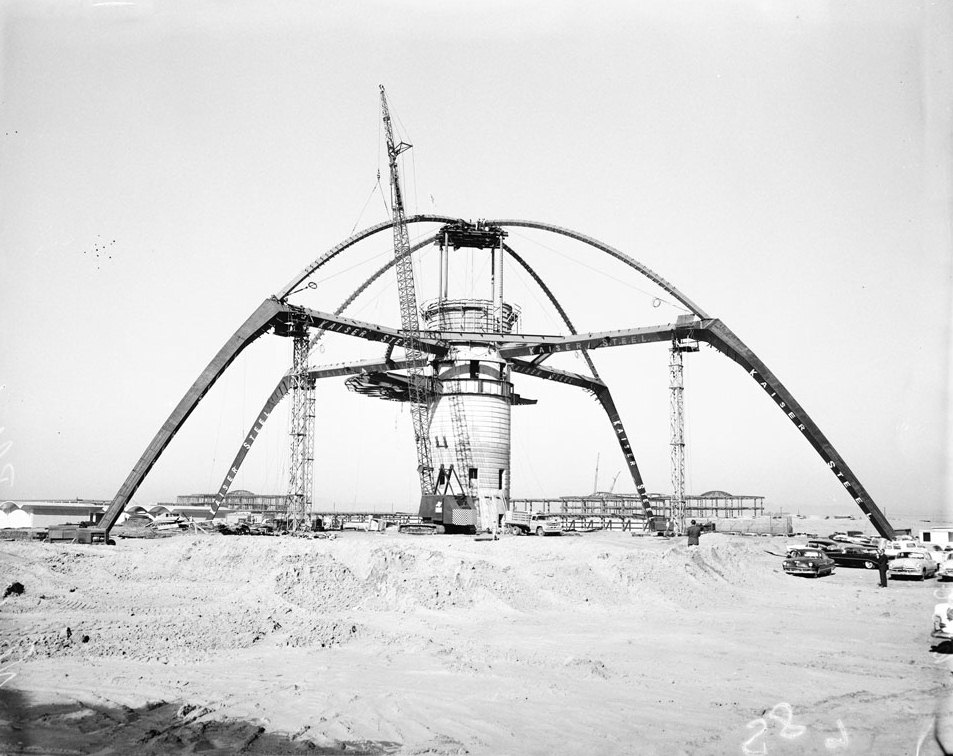 |
|
| (1960)* - View of the new 'Theme Building' as last steel girder is put in place. |
Historical Notes The original design for the airport created by Pereira & Luckman in 1959 had all the terminal buildings and parking structures connected to a huge glass dome, which would serve as a central hub for traffic circulation. The plan was eventually scaled down considerably and the terminals were constructed elsewhere on the property. The Theme Building was subsequently built to mark the spot intended for the dome structure, as a reminder of the original plan. |
 |
|
| (ca. 1961)*- Structural steel and scaffolding, Theme Building LAX. Courtesy of LAX Photo Archives, LAX Flight Path Museum |
Historical Notes The appearance of the building as a single homogenous structure is a cleverly constructed illusion. The building's two crossed arches actually consist of four steel-reinforced concrete legs that extend approximately 15' above the ground, and a hollow, stucco-covered steel truss constituting the remaining lower arches and entire upper arches. To avoid changing the appearance of the structure with overt reinforcement, the Theme Building was retrofitted with a tuned mass damper to counteract earthquake movements.*^ |
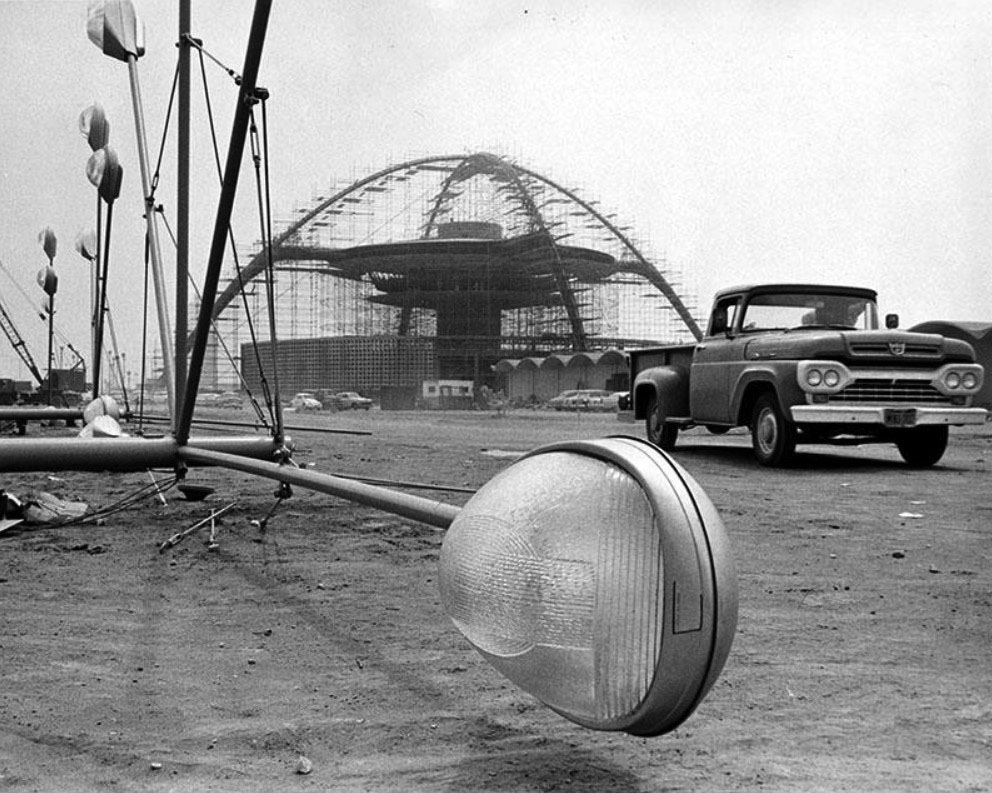 |
|
| (1961)* - New streetlights being assembled in the foreground as construction continues on the Theme Building. Click HERE to see more in Early Los Angeles Streetlights. Photo by John Woods - LAPL |
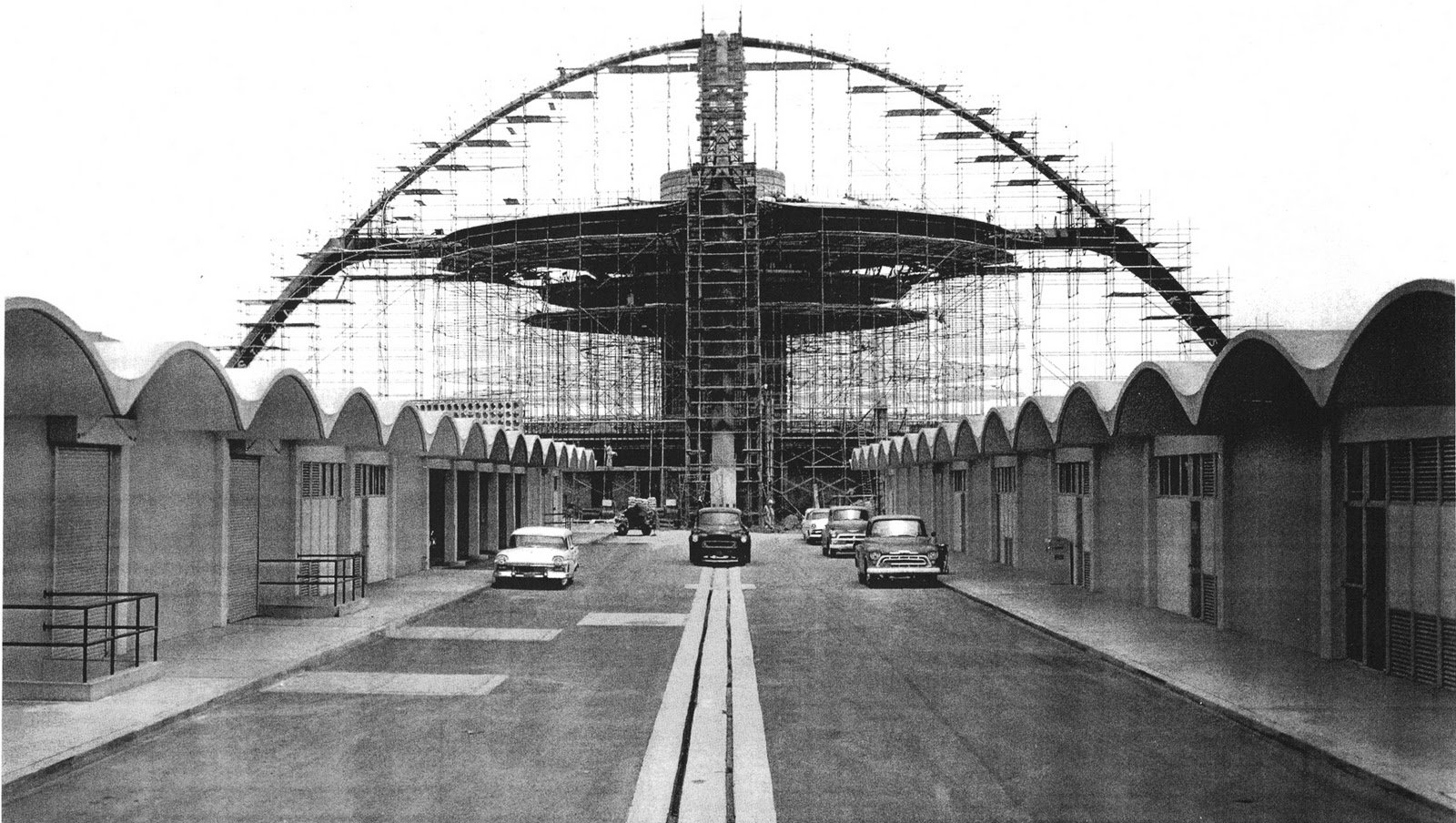 |
|
| (ca. 1961)*** - Maintenance garages and Theme Building LAX |
 |
|
| (ca. 1961)*** - LAX Theme Building. Photo: Julius Shulman / Getty Research Institute |
Hitorical Notes The distinctive white building resembles a flying saucer that has landed on its four legs. It was designed by a team of architects and engineers headed by William Pereira and Charles Luckman, that also included Paul Williams and Welton Becket. The initial design of the building was created by James Langenheim, of Pereira & Luckman. |
 |
|
| (1962)* - View of the Theme Building and its parking lot. Note the stylish multi-head streetlights surrounding the building. Click HERE to see more in Early Los Angeles Streetlights. UCLA Library Digital Collections |
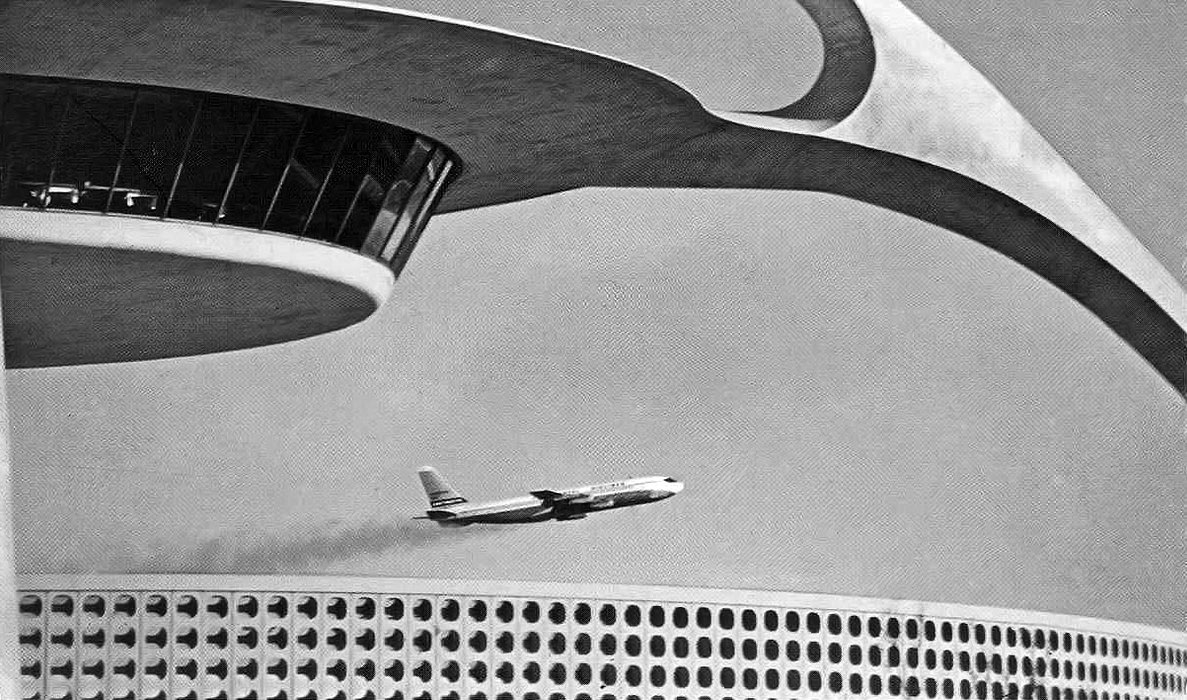 |
|
| (1960s)^ – Postcard view of the Theme Building with Continental 707 taking off in the background. Photo courtesy of Vintage Airlines |
* * * * * |
LAX Control Tower
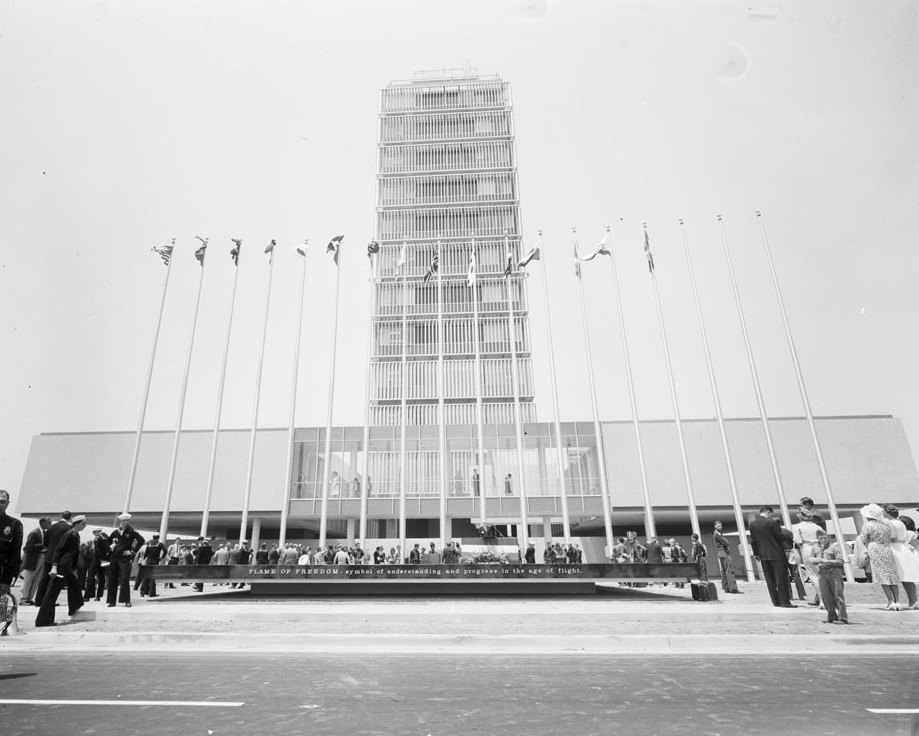 |
|
| (1961)^* - Dedication of new International Airport for jets, June 22, 1961. |
Historical Notes The control tower as seen above served as the Los Angeles Airport's main control tower until April 1996 when it was replaced by the new LAX Control Tower. The old tower is currently being used as LAX offices. |
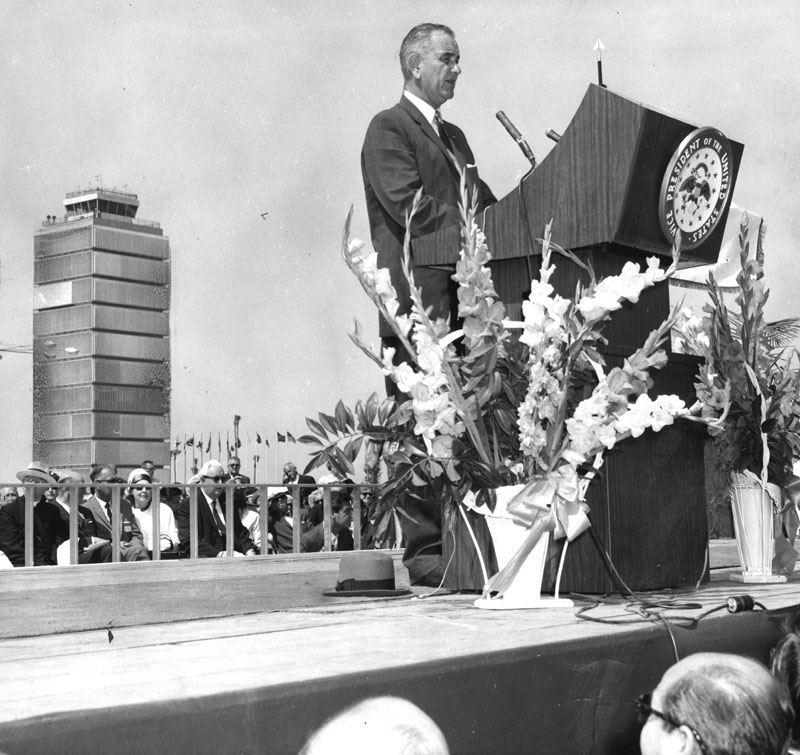 |
|
| (1961)* - Photo of then Vice President Lyndon B. Johnson speaking at the new jet age terminal dedicated June 25, 1961. Control tower rises in the background. |
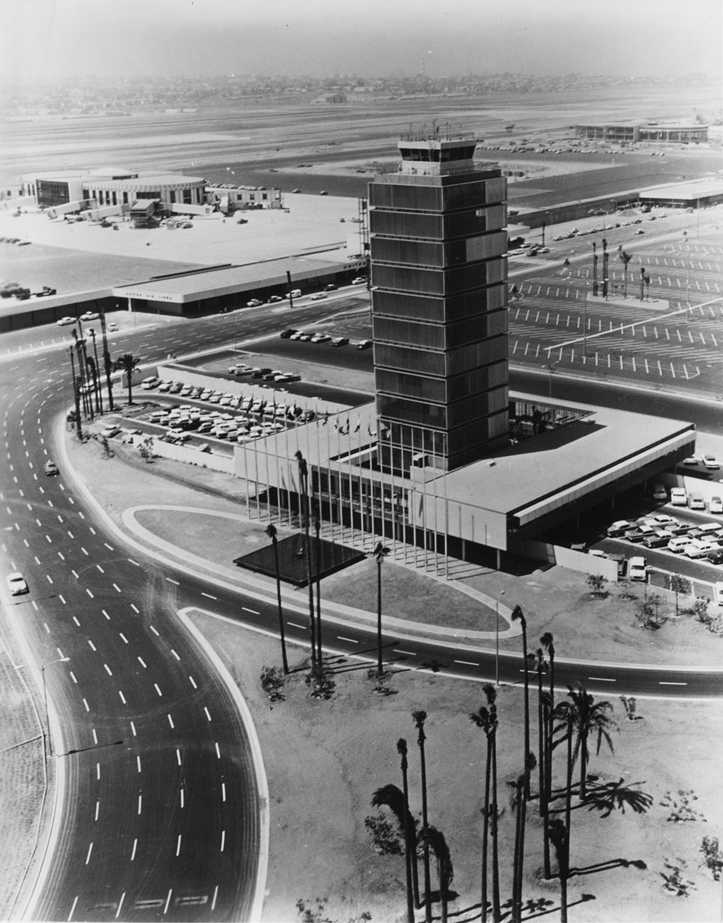 |
|
| (1961)* - Photograph of an aerial view of the control tower administration building at the new jet age terminal at Los Angeles International Airport, in September 1961. USC Digital Library |
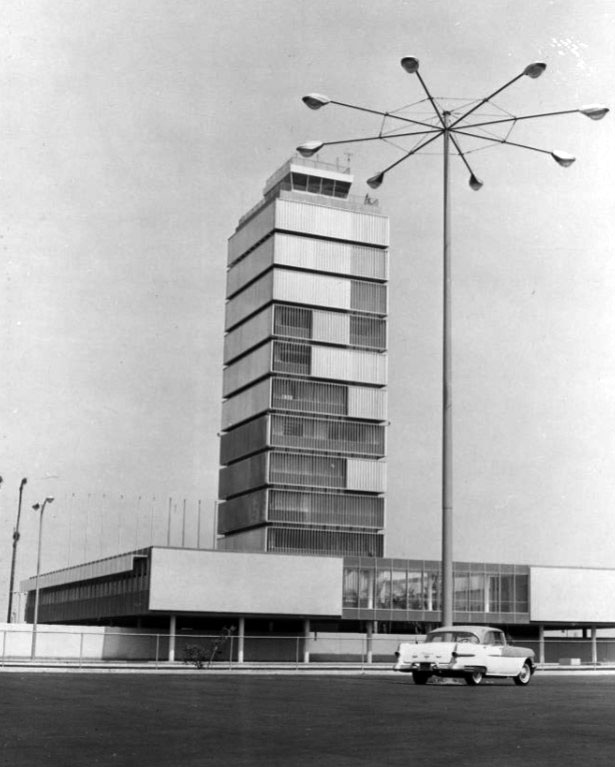 |
|
| (1961)* – View showing the control tower administration building at LAX. Also seen is a 57’ tall, 8-lamp, mercury-vapor streetlight in the parking lot. |
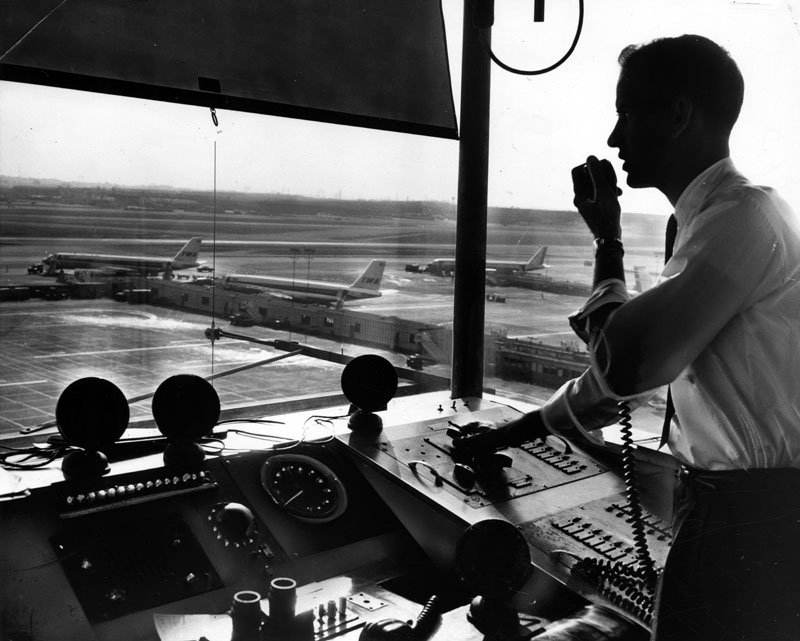 |
|
| (1961)* - An air traffic controller at work inside the control tower at Los Angeles international Airport. Two Trans World Airlines (TWA) planes can be seen in the background. Los Angeles Examiner Collection - LAPL |
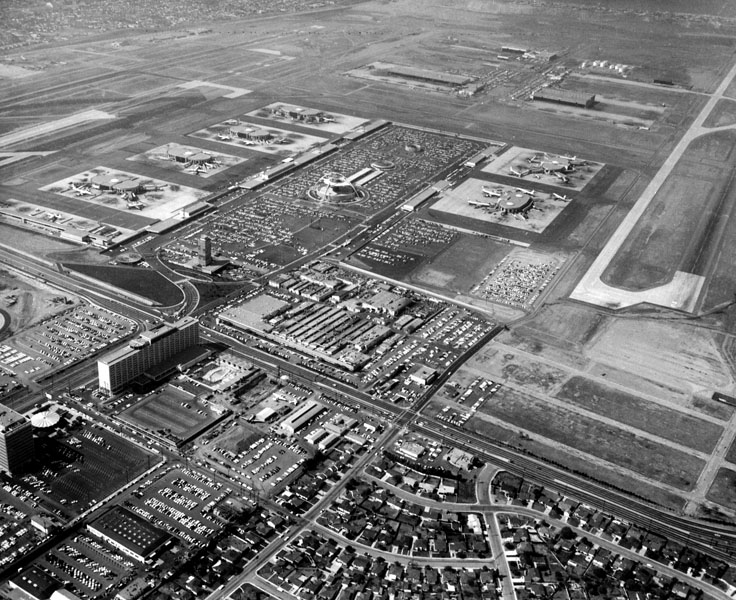 |
|
| (1962)* - Aerial view of the Los Angeles International Airport. |
Historical Notes The present terminal complex was constructed in 1961. In the early 1980s, LAX added domestic and international terminals and a second-level roadway. |
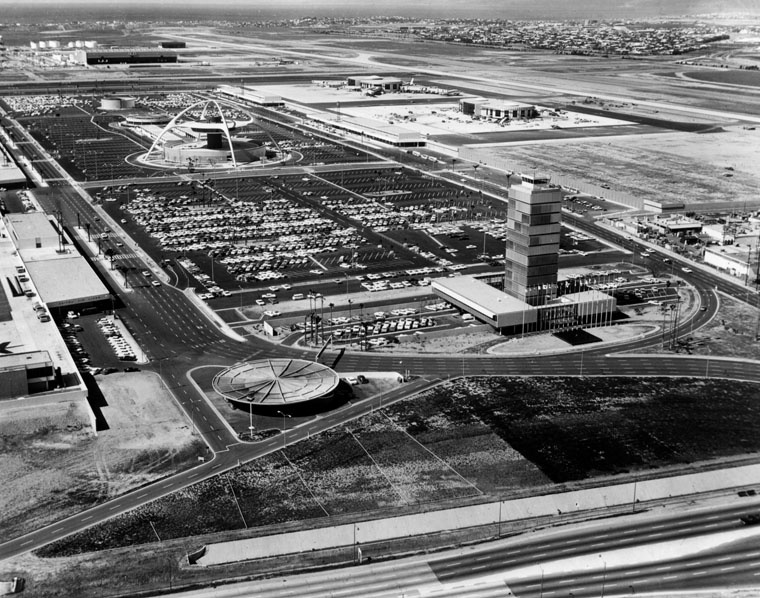 |
|
| (1962)* - Aerial view of Los Angeles International Airport. LAPL |
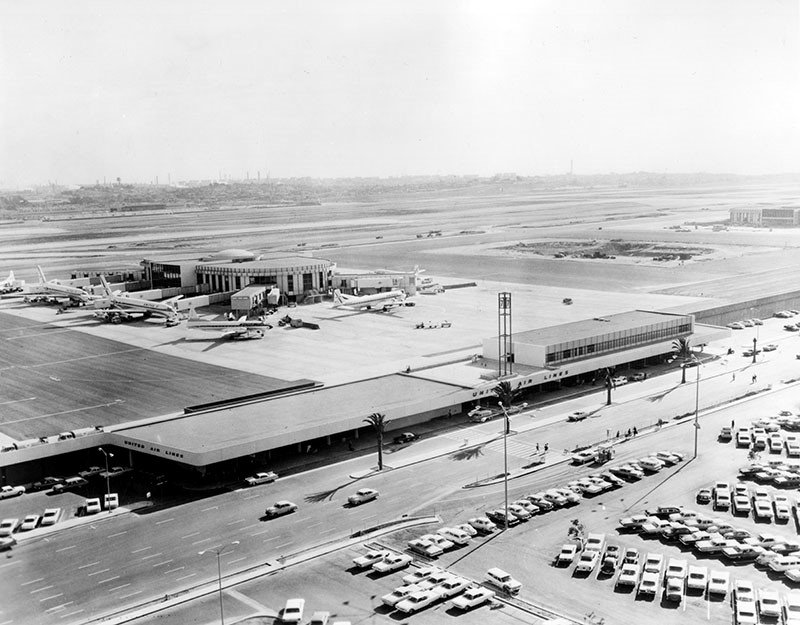 |
|
| (1963)* - Photograph caption dated January 29, 1963 reads, "Los Angeles jet age airport - Control tower and satellite terminal, left to be previewed." Photo by John Woods - Valley Times Photo Collection |
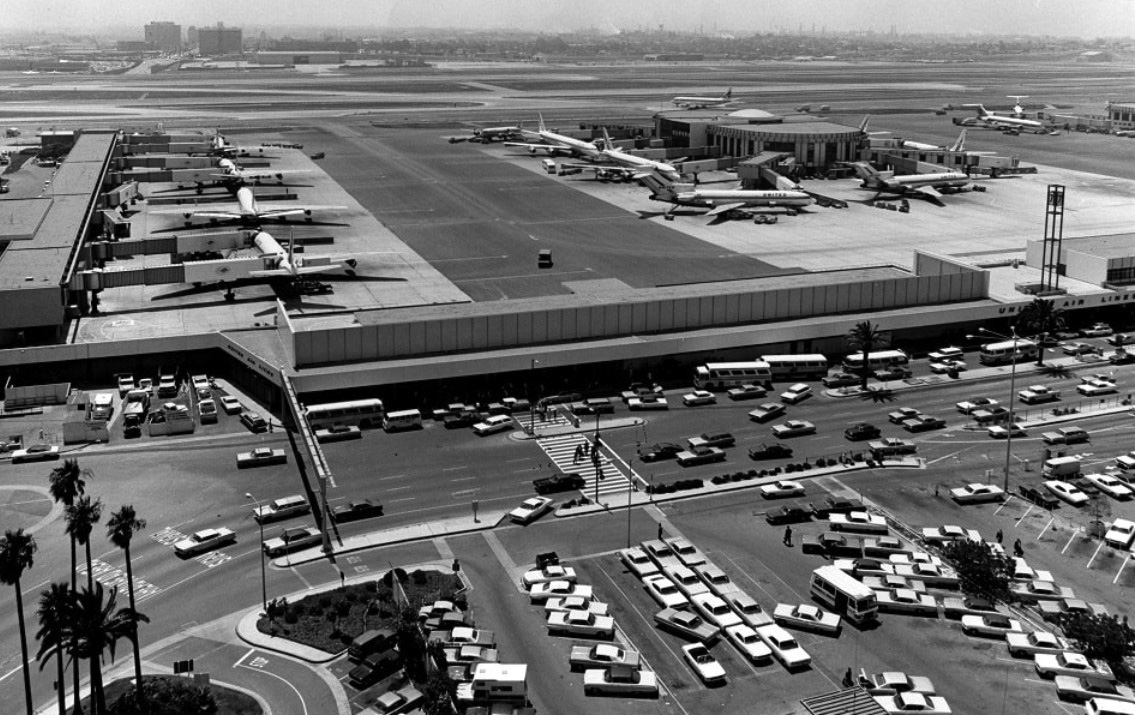 |
|
| (1968)^ – View looking down at Terminal 7 (upper-right) as seen from the air traffic control tower. By now Boeing 727s have entered the scene. This images also includes Building 8 to the left which was a conventional concourse and part of United’s complex. The curbside has become a lot busier than in previous years. Photo courtesy of AirportHistory.org |
 |
|
| (1963)* - Aerial view of International Airport's new terminal. Herald Examiner Collection / LAPL |
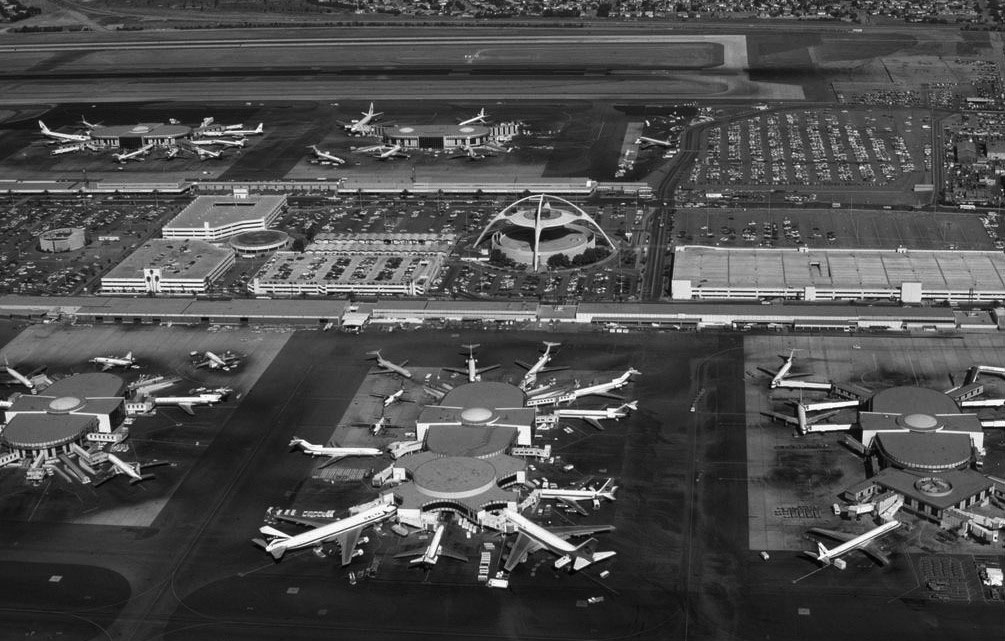 |
|
| (ca. 1971)^*# - Aerial view of LAX showing five terminals surrounding the Theme Building. The satellite terminals were connected via underground tunnels. |
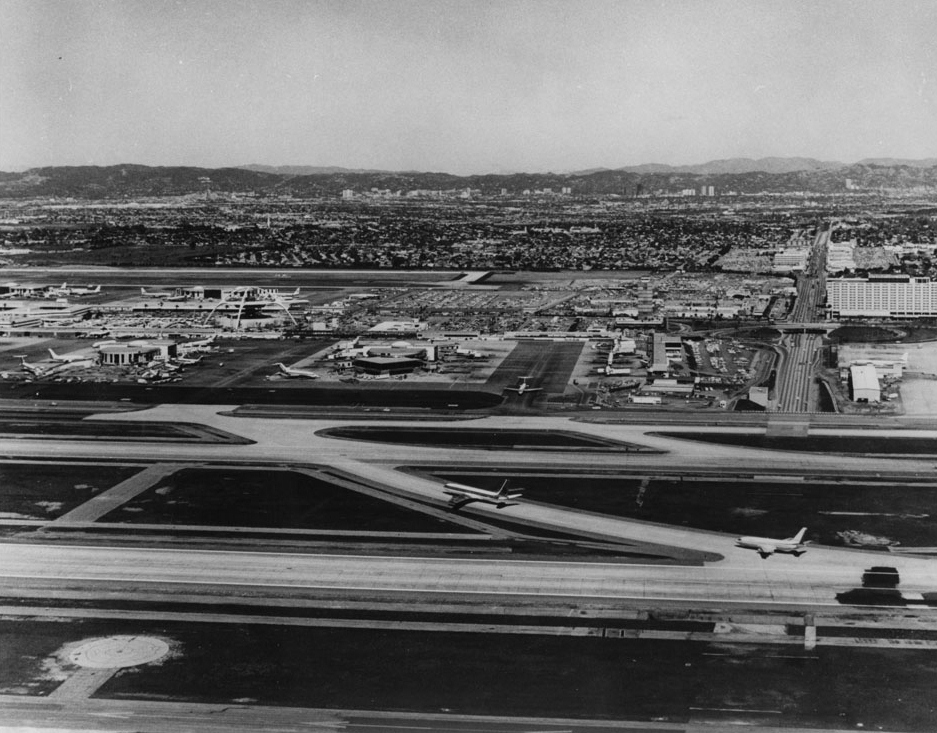 |
|
| (1971)^* - View of the runways and Theme Building at the Los Angeles International Airport, taken by James Caldwell, in February 1971. USC Digital Archives |
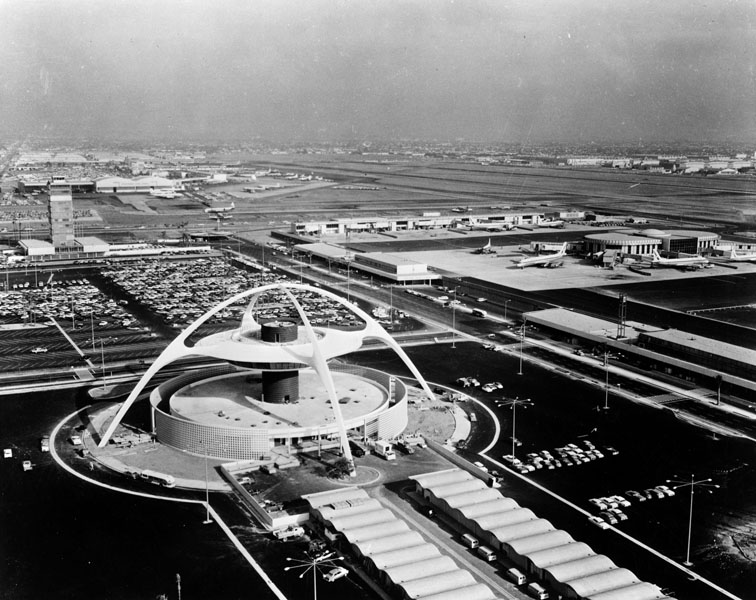 |
|
| (n.d.)* - Theme Building at the Los Angeles International Airport in the foreground with a sweeping view of the airport seen from the air. - LAPL |
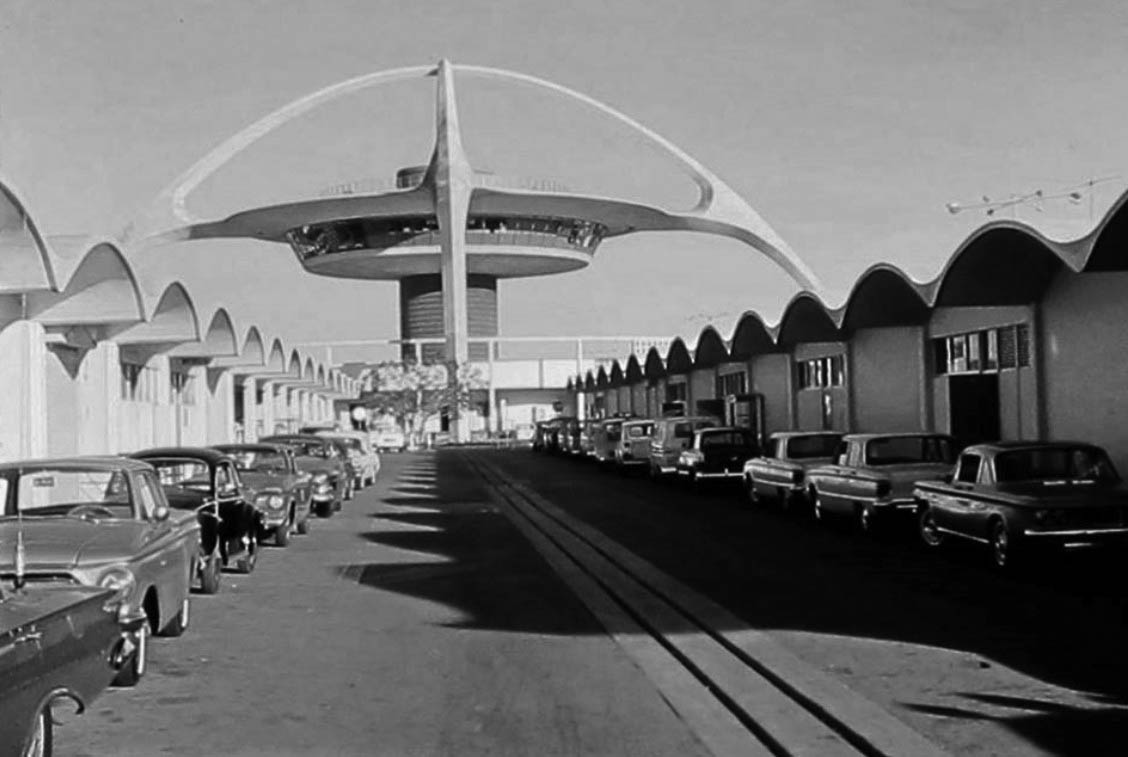 |
|
| (1960s)^ – View looking between maintenance buildings at LAX toward the Theme Building with cars parked on both sides of alleyway. Photo courtesy of Bizzare Los Angeles |
Historical Notes A $4 million renovation, with retro-futuristic interior and electric lighting designed by Walt Disney Imagineering, was completed before the "Encounter Restaurant" opened there in 1997. Visitors are able to take an elevator up to the Observation Level of the "Theme Building", located on the roof of the Encounter Restaurant. After the September 11 attacks, the Observation Level was closed for security reasons. Following a $12.3 million restoration of the building completed in 2010, the observation level re-opened to the public on weekends. On September 9th, 2003, a permanent memorial honoring those who perished in the attacks of September 11th was opened on the grounds of the Theme Building. |
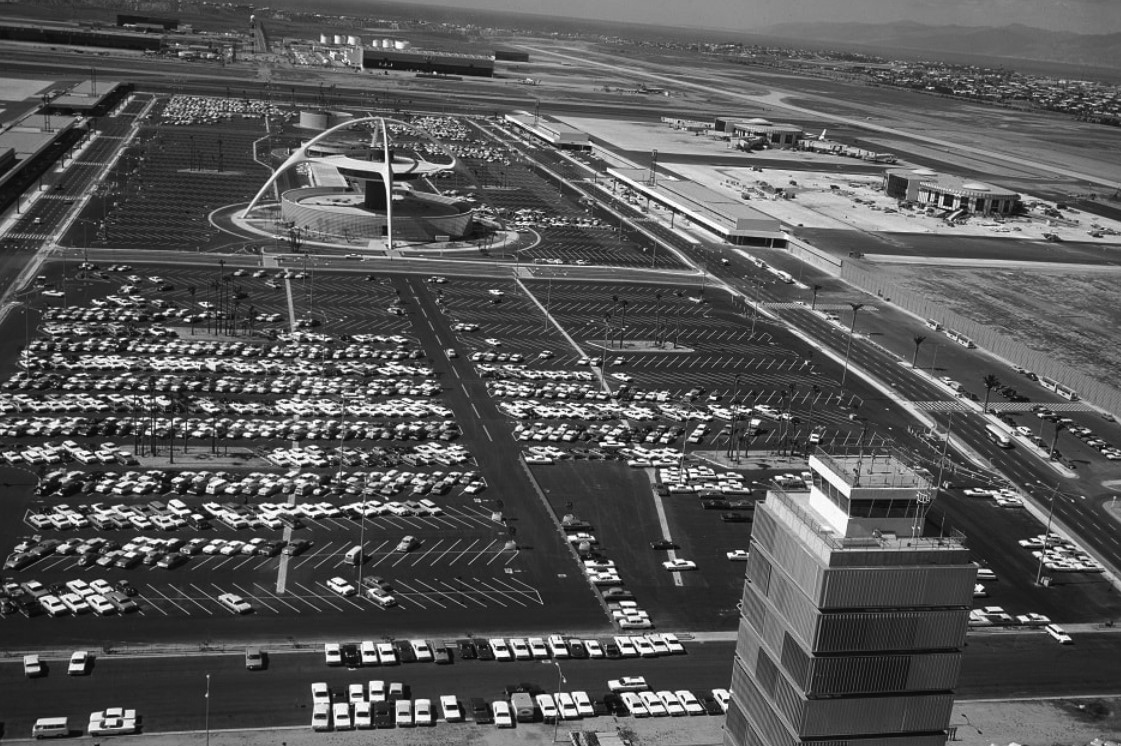 |
|
| (1960s)* - Aerial view showing the core area of the passenger terminal area looking west with the air traffic control tower in the foreground. The Theme Building is located in the middle of a 5,000-car parking area. To the right and left are the various ticketing facilities. The two large structures in the background are the American (L) and TWA (R) maintenance hangars. |
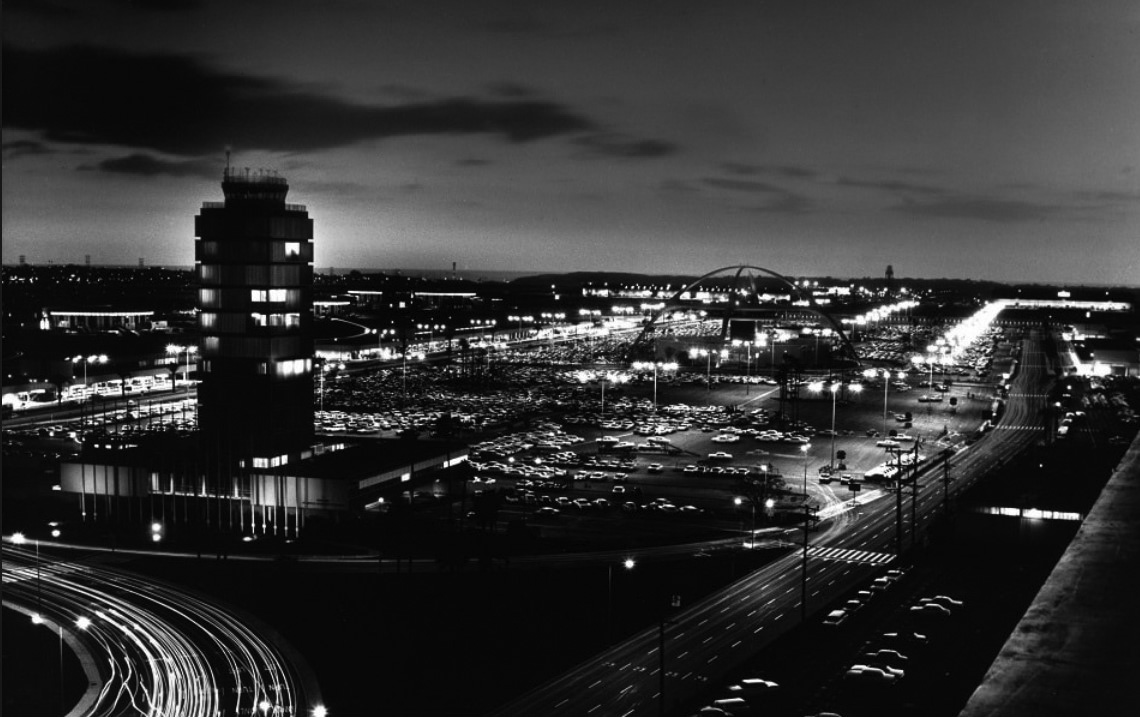 |
|
| (1960s)^ – Horizon view of LAX at dusk. Credit: LAX Photo Archives |
 |
|
| (ca. 1964)* - An early morning sunrise at LAX Airport during the Atomic Age. Photo LA Times |
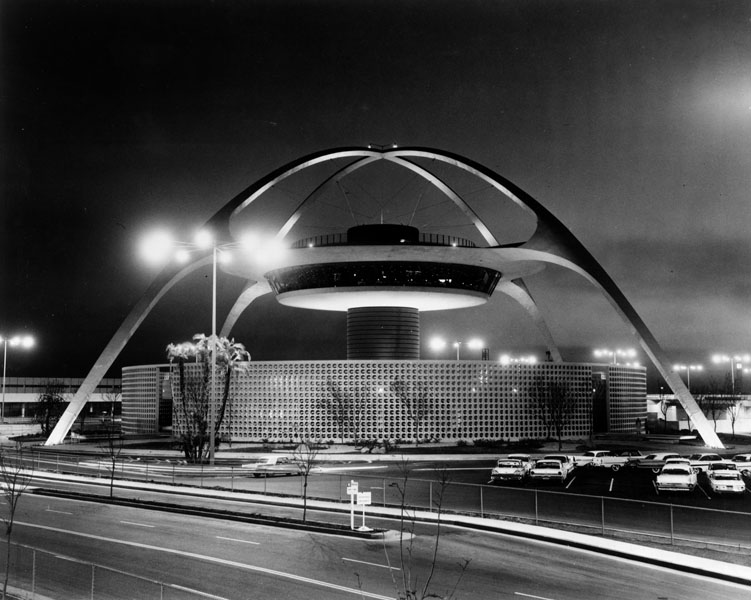 |
|
| (1960s)* - Theme Building at the Los Angeles International Airport illuminated at night. LAPL |
Historical Notes The Los Angeles City Council designated the Theme Building a cultural and historical monument (No. 570) in 1992. Click HERE to see the complete LA Historic Cultural Monument List. |
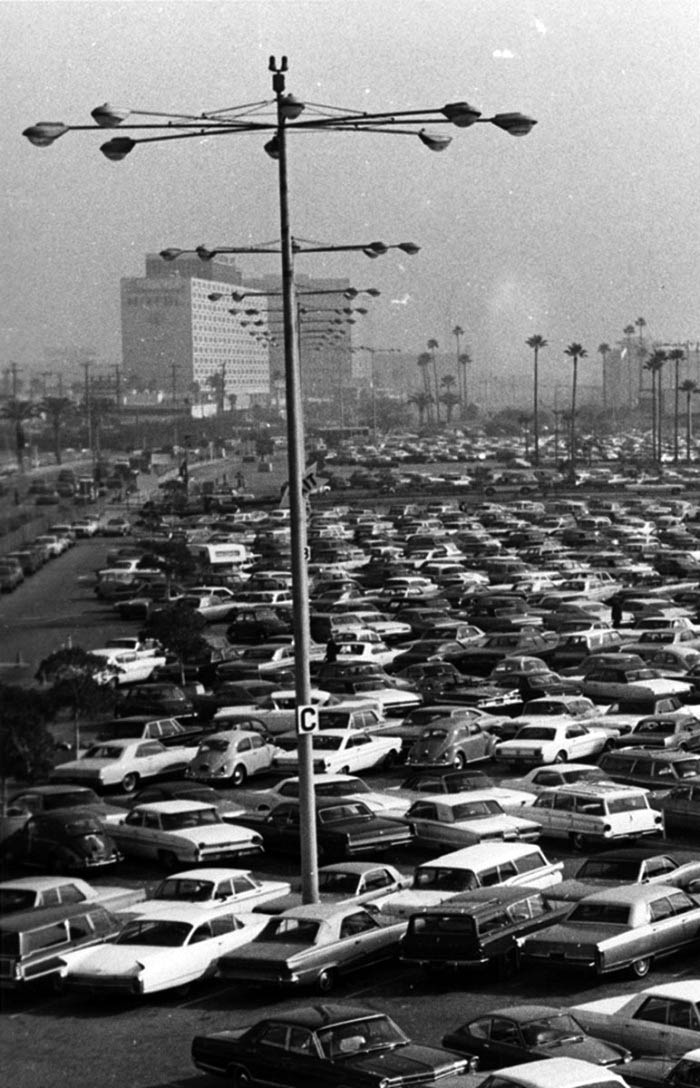 |
|
| (ca. 1974)* – A line of tall eight-headed lamps stand in the foreground, above row upon row of automobiles in a series of parking lots outside the airport. |
 |
|
| (1971)* – View showing a full parking lot at LAX with the Theme Building at right and the Control Tower in the distance. Mustangs and VW’s were popular. Photo by James Caldwell |
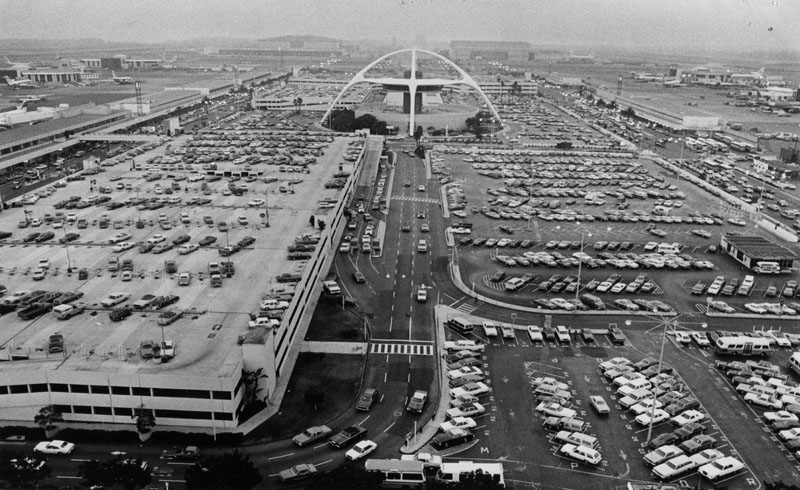 |
|
| (1978)* - Photograph caption dated August 27, 1978 reads, "Finding a place to park at Los Angeles International can be a traveler's major problem." Note the new multi-level parking structure at left. |
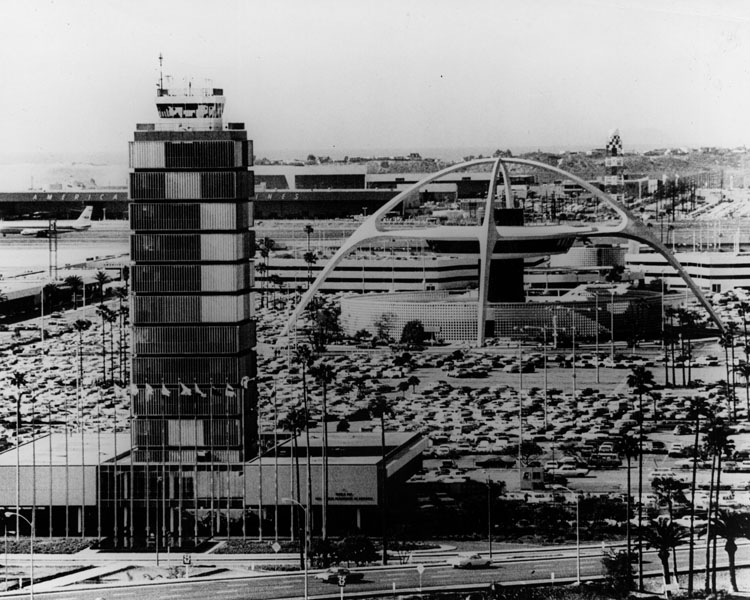 |
|
| (1973)* - Close-up view of Control Tower and Theme Building at Los Angeles International Airport. |
 |
|
| (n.d.)* - A 747 Jumbo Jet takes off from LAX. The Theme Building is seen in the background. |
Historical Notes The Boeing 747 is a large, long–range wide-body airliner and cargo aircraft manufactured by Boeing Commercial Airplanes in the United States. After introducing the 707 in October 1958, Pan Am wanted a jet 2½ times its size, to reduce its seat cost by 30% to democratize air travel. In 1965, Joe Sutter left the 737 development program to design the 747, the first twin aisle airliner. In April 1966, Pan Am ordered 25 747-100 aircraft and in late 1966, Pratt & Whitney agreed to develop its JT9D, a high-bypass turbofan. On September 30, 1968, the first 747 was rolled out of the custom-built Everett Plant, the largest building in the world by volume. The first flight took place on February 9, 1969 and the 747 was certified in December of that year. It entered service with Pan Am on January 22, 1970; it was the first airplane dubbed a "Jumbo Jet"."^ |
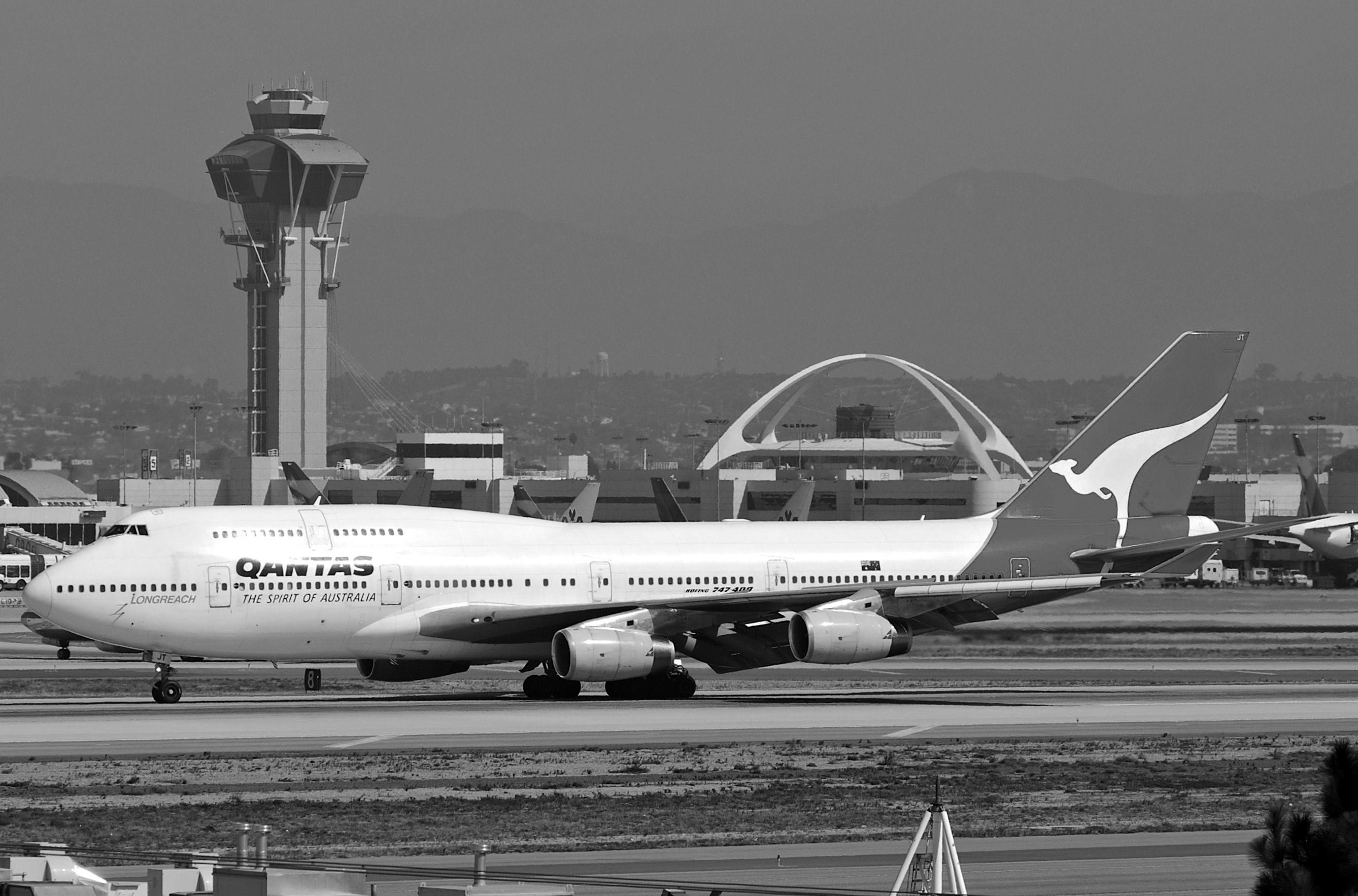 |
|
| (2020)^ – A Qantas Boeing 747-400 taxis on LAX runway after flying in from Sydney on its next to last flight. Final flight will be to the Mojave Desert for storage. Wikipedia |
Historical Notes Qantas has been an ardent supporter of the Boeing 747 and has purchased nearly every variant of the jet from the 747-100 to the 747-400. The Jumbo Jet was the aircraft of choice for its longest routes over the years and helped usher in a wave of nonstop connections between Australia and cities across the US including Los Angeles, Dallas, and San Francisco. Qantas 747s carried more than 250 million people in almost half a century of service. It was once the world's only airline with an all 747 fleet. The 747, which is still being produced, mainly as a freighter, was eventually outclassed for fuel economy by the newest generation of jetliners, such as the Airbus A350 and Boeing's own more recent models.* |
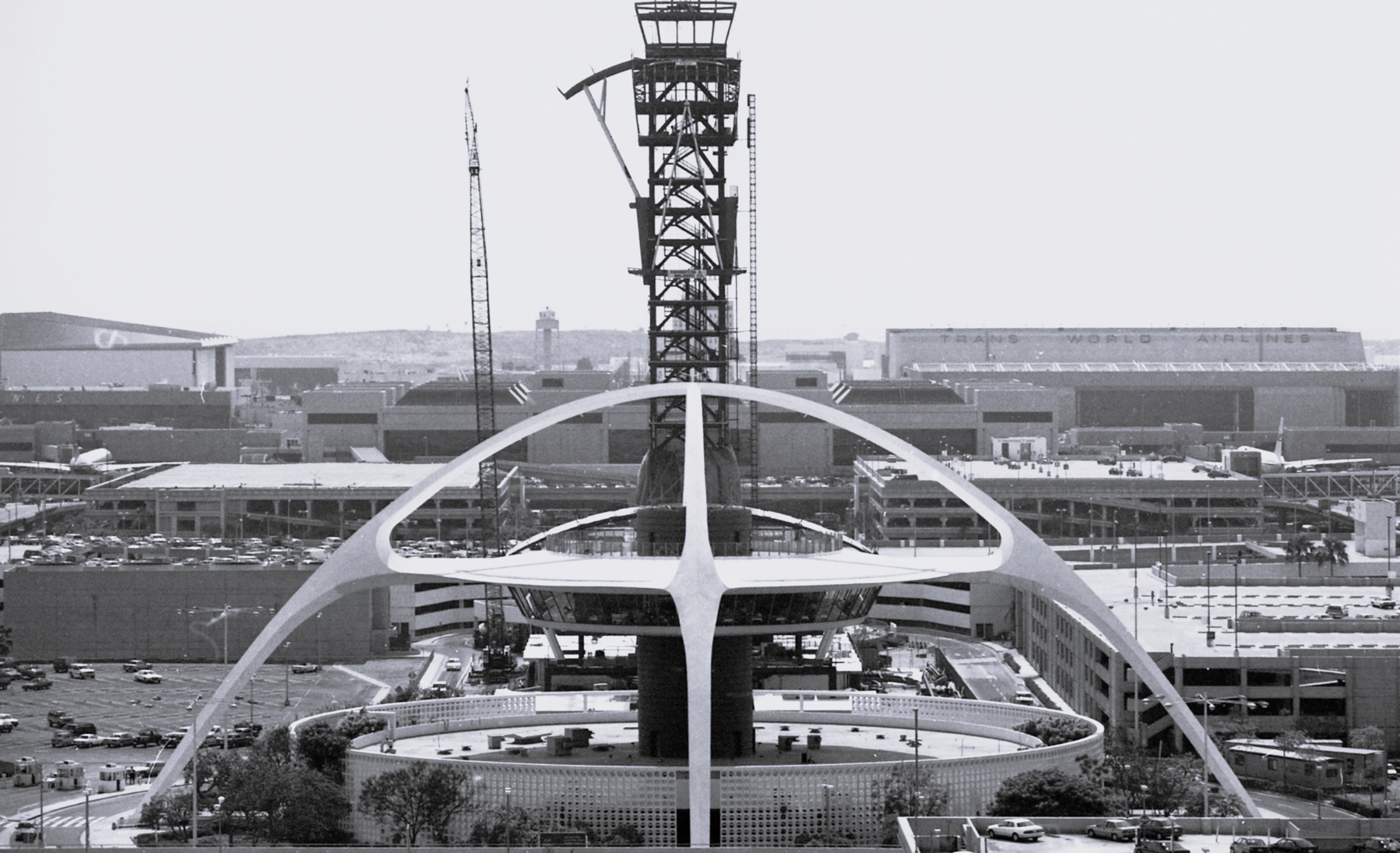 |
|
| (1995)* – Construction of the 277-ft tall current control tower at LAX with the Theme Building in the foreground. |
Historical Notes The current control tower at Los Angeles International Airport (LAX) was built in 1995 and became operational in April 1996. Here are the key details about the construction of the LAX control tower: The previous control tower at LAX was built in 1961 and served the airport for 35 years until it was replaced. The new tower was designed to be 277 feet tall, over 100 feet taller than the previous one, with more than double the cab space at 625 square feet. The new tower, designed by architects Kate Diamond and Adrianna Levinescu, has architectural features resembling the letters L, A, and X. The 277-foot tall tower was dedicated on March 22, 1996 and went into full operation a week later in April 1996, replacing the 1961 tower. |
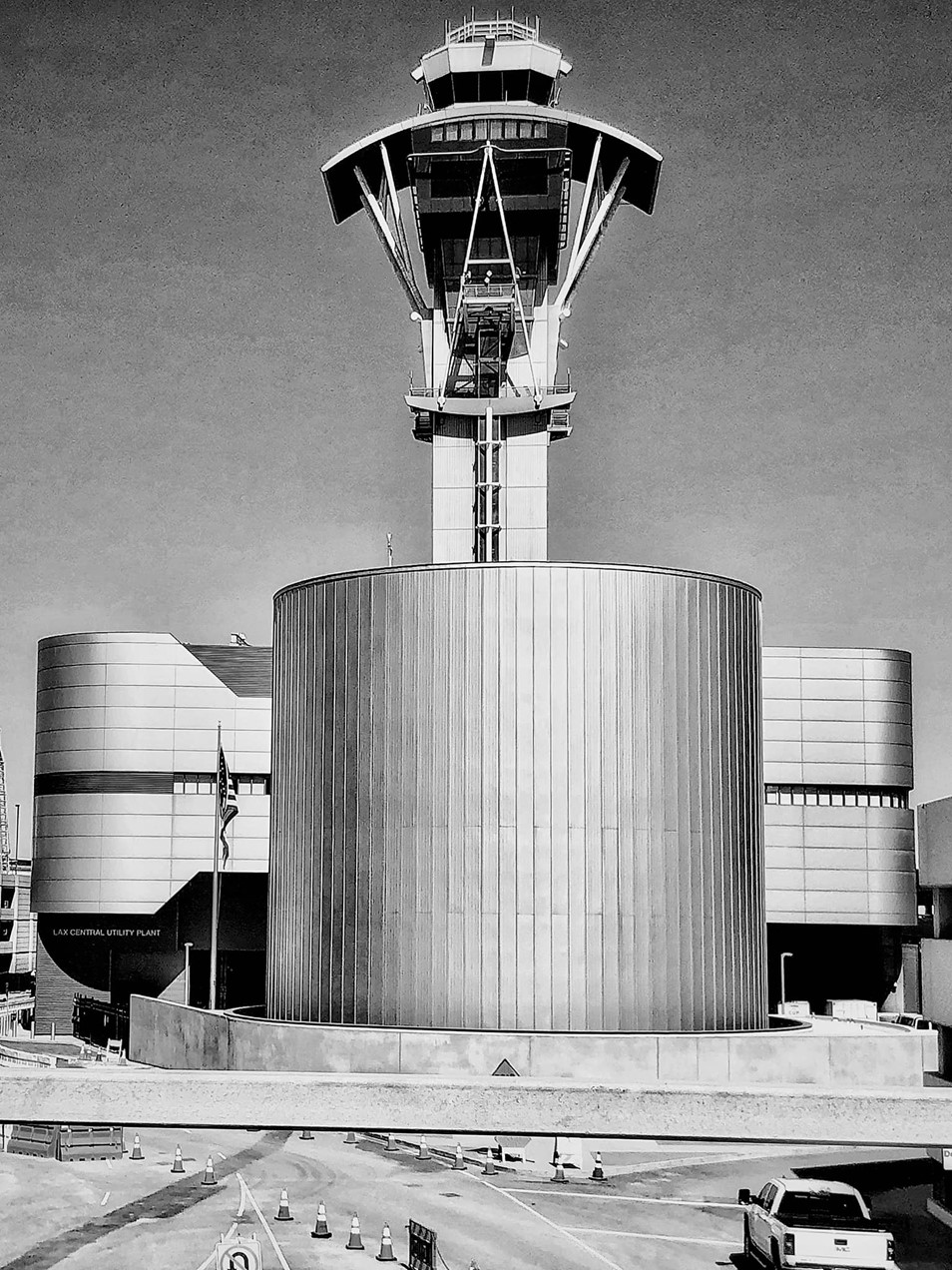 |
|
| (2023)* - LAX Control Tower Building. Photo by Carlos G. Lucero |
Historical Notes Completed in 1996, Los Angeles International Airport's air traffic control tower was designed by architect Kate Diamond of the architectural firm Siegel Diamond and Holmes Narver. It was meant to resemble a palm tree, with fronds dropping to its sides from the top. The 277-foot tower is 115 feet taller than its predecessor and cost $22 million to build. |
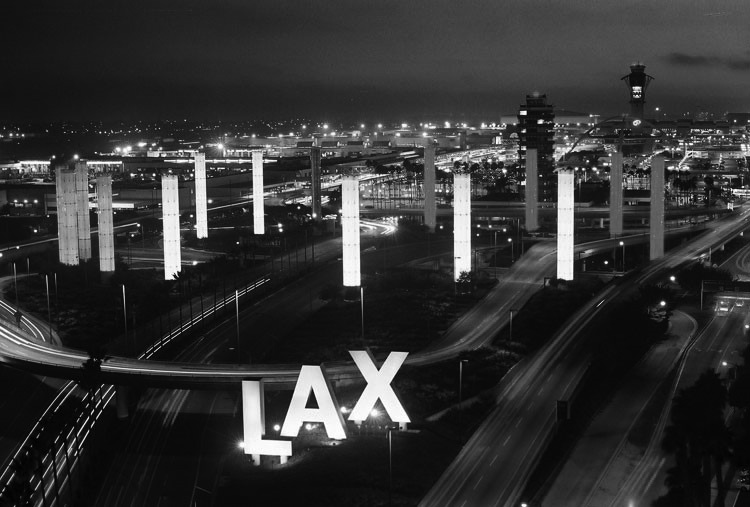 |
|
| (2018)^ - Los Angeles International Airport (LAX) is the fifth busiest airport in the world, accommodating more than 61 million travelers per year. The iconic pillars that form a gateway entrance to the airport are now known world wide and represent Los Angeles almost as much as the famed Hollywood sign. Photo courtesy of Foreman and Associates Lighting. |
Historical Notes The entrance to LAX is marked by the LAX Gateway pylons, which are 100-foot-tall columns that illuminate the area. These pylons are part of a larger installation that includes 11 translucent, tempered glass columns of varying heights along Century Boulevard, culminating in a ring of 15 100-foot-tall columns at the intersection of Century and Sepulveda boulevards. The pylons are designed to mimic an aircraft takeoff pattern and are visible to airline passengers from 3,000 feet. They are illuminated in a variety of colors, with 16 million color possibilities, and sequences designed and programmed by lighting artists and airport staff. The LAX Gateway pylons participate in environmental initiatives such as Earth Hour. During Earth Hour, the pylons are turned off to raise public awareness of climate change and the need for energy conservation. This event is part of a coordinated worldwide effort. |
* * * * * |
Please Support Our CauseWater and Power Associates, Inc. is a non-profit, public service organization dedicated to preserving historical records and photos. Your generosity allows us to continue to disseminate knowledge of the rich and diverse multicultural history of the greater Los Angeles area; to serve as a resource of historical information; and to assist in the preservation of the city's historic records.
|
More Historical Early Views
Newest Additions
Early LA Buildings and City Views
History of Water and Electricity in Los Angeles
* * * * * |
References and Credits
* LA Public Library Image Archive
^ Oviatt Library Digital Archives
**Los Angeles Times Photographic Archive: Municipal Airport; Spruce Goose
^^Aerofiles - US Aviation Firsts
*#Abandoned & Little-Known Airfields – Paul Freeman
#*Huntington Digital Library Archive
**#UCLA Library Digital Collections
#**Theatlantic.com: Northrop XB-35
#*^This Day in Aviation: Lockheed Vega 1
#^*Vintage Photos of LA - Facebook.com: Theme Building
^*#Noirish Los Angeles - forum.skyscraperpage.com; Bob's Airmail Service Station; LAX Aerial; Rogers Airfield; Corvette and Theme Building
**^KCET.org: From Mines Field to LAX: The Early History of L.A. International Airport; Welcome to L.A. River
***Pinterest: LAX Theme Building; Theme Building 2; Theme Building 3; Hughes XH-17 “Flying Crane”; Northrop YB-35; Theme Building Under Construction; Mines Field 1933 National Air Races
*^^California State Military Museum - Mines Field; Lockheed Air Terminal
^**Dmairfield.com: Mines Field
*#*San Diego Air & Space Museum Archive
*##Facebook.com: Garden of Allah Novels – Martin Turnbull
^#*theautry.org - From the Ground Up: The Infrastructure of Flight in Southern California
^^^Airliners.net: The Wings of the Net: 1929 Fokker
^.^Facebook.com: Vintage Airlines
^^#LA Times: Arcadia Balloon School and Ross Field; LAX Fogged In
^^*Los Angeles World Airpots: LAX
*#^LA World Airports - History of Van Nuys Airport
^#^FriendsReunited.co.uk: Northrop YB-49 Bomber
^## Facebook.com: Photos of Time Travelers; Bill Gabel's Photos of L.A./Zeppelin
#++LAist.com
*^* Seaplanes of the Magic Isle
^*^ Nuestra Señora la Reina de los Ángeles: losangelespast.com
****Pasadena Museum of History
^*^^South Bay Daily Breeze: Seaplanes to Catalina; Mines Field; Sepulveda Tunnel
^^^^Pinterest/Santa Monica Past: Douglas Aircraft
^**^California State Library Image Archive
^***Earlyaviators.com: Roy Knabenshue
*^*#Santa Monica Municipal Airport
*^##Facebook.com: Classic Hollywood-Los Angeles-SFV
*^*^Pinterest: Appreciation of History - Reddit.com
^*^*San Fernando Valley Relics - Facebook.com: Burbank Airport; Angeles Mesa Drive Airport (Burbank Airport)
*#*#Los Angeles Then and Now: Douglas' Dream Took Wing in Santa Monica
^##^Pasadena PIO: Bob Hope Airport
*#*^Airships.net: Graf Zeppelin
^^#^Facebook.com - Great Photos from Los Angeles' Past: Rogers Airfield
*#^#Flickr.com: Walking Over Santa Monica
^*^#Facebook.com - Bizarre Los Angeles
^#^#Pinterest: Bygone Los Angeles: Vintage L.A.: Spruce Goose
#**^Pinterest: Hollwood Early Days
#^^^Calisphere Digital Archive
##**Mines Field
***# Flightpath.us
***^ Pomona Public Library Digital Archive: Bob's Airmail Service Station
*^ Wikipedia: Los Angeles International Airport; 1910 L.A. International Air Meet at Dominguez Hills; Bob Hope Airport; Grand Central Airport; Airship; Zeppelin; Theme Building; William Wrigley, Jr.; Spirit of St. Louis; Lockheed Hudson; Douglas DC-3; Amelia Earhart; Maddux Air Lines; Carthay Circle; Hughes Airport; Hughes H-4 Hercules; Howard Hughes; Hughes Helicopters; Playa Vista; Northrop YB-35; Jack Northrop; Norhtrop YB-49; History of Santa Monica; Boeing 247; Hughes H-1 Racer; Charles Lindbergh; L-1011 Tristar; Leslie Brand; Van Nuys Airport; Douglas DC-7; Continental Airlines; Western Airlines
< Back
Menu
- Home
- Mission
- Museum
- Major Efforts
- Recent Newsletters
- Historical Op Ed Pieces
- Board Officers and Directors
- Mulholland/McCarthy Service Awards
- Positions on Owens Valley and the City of Los Angeles Issues
- Legislative Positions on
Water Issues
- Legislative Positions on
Energy Issues
- Membership
- Contact Us
- Search Index